CHAPTER 8: THE IMPEACHMENT OF WARREN HASTINGS
1 Quoted in Tillman W. Nechtman, Nabobs: Empire and Identity in Eighteenth-Century Britain Cambridge, 2010, p. 104.
2 Edmund Burke, The Writings and Speeches of Edmund Burke ed. P. J. Marshall, 6 vols, Oxford, 1991, vol. 6, pp. 275–6, 457.
3 Edmund Burke, Speeches on the Impeachment of Warren Hastings ed. George Bell, Calcutta, 1906, vol. 1, p. 361, vol. 6, pp. 275–6.
4 Keith Feiling, Warren Hastings London, 1954, p. 355.
5 Burke, Speeches on the Impeachment of Warren Hastings vol. 1, p. 361, vol. 6, pp. 285–7.
6 V. K. Saxena (ed.), Speeches on the Impeachment of Warren Hastings 2 vols, Delhi, 1987, vol. 1, pp. 13–14.
7 Burke, The Writings and Speeches of Edmund Burke 6 vols, vol. 5, pp. 401–2.
8 Burke, Speeches on the Impeachment of Warren Hastings vol. 1, p. 79.
9 Thomas Babington Macaulay, ‘Warren Hastings’, in The Historical Essays of Macaulay ed. Samuel Thurber, Boston, 1892, p. 362.
10 Quoted in Nick Robins, The Corporation That Changed the World: How the East India Company Shaped the Modern Multinational London, 2006, p. 133.
11 Quoted in the Oxford Dictionary of National Biography vol. XVIII, p. 81.
12 Feiling, Warren Hastings p. 357.
13 Jennifer Pitts, ‘Edmund Burke’s peculiar Universalism’, in Jennifer Pitts, A Turn to Empire: The Rise of Imperial Liberalism in Britain and France Princeton, 2005.
14 Ibid., p. 285.
15 Ibid., p. 339.
16 The more despotic character of the final phase of Hastings’ period as Governor General is well explored in Andrew Otis’s fascinating study, Hicky’s Bengal Gazette: The Untold Story of India’s First Newspaper Chennai, 2018.
17 Sir Penderel Moon, The British Conquest and Dominion of India London, 1989, p. 222.
18 Feiling, Warren Hastings p. 354.
19 Ibid., p. 111.
20 BL, Add Mss 39903, f. 34r.
21 Alexander Dalrymple, A Retrospective View of the Antient System of the East India Company, with a Plan of Regulation London, 1784, p. 73.
22 Denis Kincaid, British Social Life in India up to 1938 London, 1938, pp. 22, 95.
23 Voyage en Inde du Comte de Modave, 1773–1776 ed. Jean Deloche, Pondicherry, 1971, p. 77.
24 Rajat Datta, ‘The Commercial Economy of Eastern India under British Rule’, in H. V. Bowen, Elizabeth Mancke and John G. Reid, Britain’s Oceanic Empire: Atlantic and Indian Ocean Worlds, c. 1550–850 Cambridge, 2012, p. 361.
25 Moon, The British Conquest and Dominion of India p. 245.
26 P. J. Marshall, The Making and Unmaking of Empires: Britain, India and America c. 1750– 1783 Oxford, 2007, p. 243.
27 P. J. Marshall, Bengal: The British Bridgehead – Eastern India 1740–1828 Cambridge, 1987, p. 114; Datta, ‘The Commercial Economy of Eastern India under British Rule’, p. 346.
28 H. V. Bowen, ‘British India, 1765–813: The Metropolitan Context’, in Peter Marshall, The Eighteenth Century Oxford, 1998, p. 535; C. A. Bayly, Indian Society and the Making of the British Empire Cambridge, 1988, p. 35; Datta, ‘The Commerical Economy of Eastern India under British Rule’, p. 358.
29 Quoted in H. V. Bowen, The Business of Empire: The East India Company and Imperial Britain, 1756–1833 Cambridge, 2006, pp. 241–2; Holden Furber, ‘Rival Empires of Trade in the Orient, 1600–800’, in Maritime India intro. Sanjay Subrahmanyam, New Delhi, 2004, p. 175.
30 Datta, ‘The Commercial Economy of Eastern India under British Rule’, p. 346.
31 Marshall, The Making and Unmaking of Empires pp. 248–51.
32 Datta, ‘The Commercial Economy of Eastern India under British Rule’, p. 363.
33 Ibid., pp. 362–3; Bayly, Indian Society and the Making of the British Empire p. 85. See also Seema Alavi, The Sepoys and the Company: Tradition and Transition in Northern India 1770– 1830 Delhi, 1995.
34 Burton Stein, ‘Eighteenth Century India: Another View’, Studies in History vol. 5, 1 n.s. (1989), p. 21.
35 Abdul Latif Shushtari : Kitab Tuhfat al-’Alam written Hyderabad 1802 & lithographed Bombay 1847, p. 427.
36 Moon, The British Conquest and Dominion of India p. 247.
37 Quoted in Denys Forrest, Tiger of Mysore: The Life and Death of Tipu Sultan London, 1970, p. 205.
38 J. Michaud, History of Mysore Under Haidar Ali and Tipp. oo Sultan trans. V. K. Raman Menon, Madras, 1924, pp. 47–8.
39 Burton Stein, ‘State Formation and Economy Reconsidered’, Modern Asian Studies vol. 19, no. 3, Special Issue: Papers Presented at the Conference on Indian Economic and Social History, Cambridge University, April 1984 (1985), pp. 387–413, p. 403. See also Irfan Habib (ed.), Resistance and Modernisation under Haidar Ali & Tipu Sultan New Delhi, 1999, Introduction, p. xxxi.
40 A. Subbaraya Chetty, ‘Tipu’s Endowments to Hindus and Hindu institutions’, in Habib (ed.), Resistance and Modernisation under Haidar Ali & Tipu Sultan pp. 101–11.
41 B. A. Saletore, ‘Tipu Sultan as a Defender of Hindu Dharma’, in Habib (ed.), Resistance and Modernisation under Haidar Ali & Tipu Sultan p. 125.
42 Ibid., p. 126.
43 Habib (ed.), Resistance and Modernisation under Haidar Ali & Tipu Sultan Introduction, p. xxvii. See also Mahmud Husain, The Dreams of Tipu Sultan Karachi, n.d.
44 Habib (ed.) Resistance and Modernisation under Haidar Ali & Tipu Sultan Introduction, p. xxvi.
45 Maya Jasanoff, Edge of Empire: Conquest and Collecting in the East, 1750–1850 London, 2005, pp. 184–5; Habib (ed.), Resistance and Modernisation under Haidar Ali & Tipu Sultan Introduction, p. xxxiv.
46 T. Venkatasami Row, A Manual of the District of Tanjore in the Madras Presidency Madras, 1883, pp. 812–13. See also Stein, ‘Eighteenth Century India: Another View’, Studies in History vol. 5, 1 n.s. (1989).
47 Moon, The British Conquest and Dominion of India p. 248.
48 James Rennell, The Marches of the British Armies in the Peninsula of India London, 1792, p. 33.
49 Moon, The British Conquest and Dominion of India p. 251.
50 Quoted in Forrest, Tiger of Mysore p. 149.
51 Cornwallis to Malet, 25 March 1791, BL IOR, mmc P/252/60, ff. 2005–6; Cornwallis to Oakeley, 30 April 1791, mmc P/252/61, ff. 2318–2319; Letter from Madras, 15 July 1791, BL IOR, hm 251, ff. 9–11; Cornwallis to Oakeley, 24 May 1791, BL IOR, mmc P/252/62, ff. 2827– 9; Cockburn to Jackson, 12 July 1791, BL IOR, mmc P/252/63, ff. 3317, 3321; Torin to Cornwallis, 21 October 1791, National Archives, pro 30/11/45, f. 5. Quoted in Mesrob Vartavarian, ‘An Open Military Economy: The British Conquest of South India Reconsidered, 1780–799’, Journal of the Economic and Social History of the Orient vol. 57, no. 4 (2014), pp. 486–510, p. 496.
52 Quoted in Govind Sakharam Sardesai, A New History of the Marathas 3 vols, Baroda, 1948, vol. 3, p. 193.
53 Military Operations BL, IOR, HM251, ff. 746–7, quoted in Vartavarian, ‘An Open Military Economy’, p. 497.
54 BL, OIOC, Eur Mss F228/52 Dec 1791, f. 1.
55 Jean-Marie Lafont, Indika: Essays in Indo-French Relations 1630–1976 Delhi, 2000, p. 186.
56 BL, OIOC, Eur Mss F228/52 Dec 1791, f. 2.
57 Ibid.
58 Forrest, Tiger of Mysore p. 200.
59 Sardesai, A New History of the Marathas vol. 3, p. 192.
60 Datta, ‘The Commerical Economy of Eastern India under British Rule’, p. 342.
61 Durba Ghosh, Sex and the Family in Colonial India: The Making of Empire Cambridge, 2006; William Dalrymple, White Mughals: Love and Betrayal in Eighteenth-Century India London, 2002.
62 R. B. Saksena, Indo-European Poets of Urdu and Persian Lucknow, 1941, p. 21; Christopher J. Hawes, Poor Relations: The Making of a Eurasian Community in British India, 1773–1833 London, 1996, ch. 4; William Dalrymple, White Mughals: Love and Betrayal in Eighteenth- Century India London, 2002, pp. 50–2; Bayly, Indian Society and the Making of the British Empire p. 70.
63 C. A. Bayly, The Birth of the Modern World 1780–1914 Oxford, 2004, p. 111.
64 Anderson Correspondence, BL, Add Mss 45, 427, Wm Palmer to David Anderson, 12 November 1786, f. 196.
65 Marshall, Bengal: The British Bridgehead pp. 122–5.
66 Bayly, The Birth of the Modern World p. 111; Marshall, Bengal: The British Bridgehead, pp. 122–5; C. A. Bayly, Rulers, Townsmen and Bazaars: North Indian Society in the Age of British Expansion Cambridge, 1983, pp. 466–7, 474, 479; Bayly, Indian Society and the Making of the British Empire pp. 108, 150.
67 Kumkum Chatterjee, ‘Collaboration and Conflict: Bankers and Early Colonial Rule in India: 1757–813’, Indian Economic and Social History Review 30, 3 (1993), pp. 296–7. This whole argument was first made in the 1980s by Christopher Bayly in Rulers, Townsmen and Bazaars and by Karen Leonard in her groundbreaking essay ‘The Great Firm Theory of the Decline of the Mughal Empire’, Comparative Studies in Society and History 21, 2 (1979), and in ‘Banking Firms in Nineteenth-Century Hyderabad Politics’, Modern Asian Studies 15, 2 (1981). See also the dissent of J. F. Richards in ‘Mughal State Finance and the Premodern World Economy’, Comparative Studies in Society and History vol. 23, no. 2 (1981).
68 Rajat Kanta Ray, ‘Indian Society and the Establishment of British Supremacy, 1765–818’, in Marshall, The Eighteenth Century pp. 516–17.
69 ‘Chahar Gulzar Shuja’ of Hari Charan Das in Sir H. M. Elliot and John Dowson, A History of India as Told By Its Own Historians 8 vols, London, 1867–77, vol. VIII, p. 229.
70 At the cost, according to Washbrook, Bayly and more recently – in a different vein – Parthasarathi, of rendering the Indian economy relatively static, and unable to respond effectively to the new challenges of British industrialisation – though this is disputed: Tirthakar Roy offers a more optimistic account.
71 Ray, ‘Indian Society and the Establishment of British Supremacy, 1765–818’, in Marshall, The Eighteenth Century p. 517.
72 Jadunath Sarkar, Fall of the Mughal Empire 4 vols, New Delhi, 1991, vol. 3, p. 254.
73 The Company was, of course, not only dependent on ‘local money’ –it could also draw on the resources of the Company at home and the domestic state. See J. R. Ward’s important older article ‘The Industrial Revolution and British Imperialism, 1750–850’, in Economic History Review, n.s., vol. 47, no. 1 (February 1994), pp. 44–65 on the role of domestic consumers in financing the tea trade.
74 Sayid Athar Abbas Rizvi, Shah ‘Abd al’Aziz: Puritanism, Sectarianism and Jihad Canberra, 1982, p. 44.
75 In the lovely words of Ferdinand Mount, Tears of the Rajas: Mutiny, Money and Marriage in India 1805–1905 London, 2016, p. 185.
76 Voyage en Inde pp. 549–550.
77 Napoleon to Tipu, 7 Pluviôse VII [26 January 1799], OIOC, P/354/38. The second quotation, which is quoted by Andrew Roberts in Napoleon and Wellington London, 2001, pp. 16–17, in fact dates from 1812 when Napoleon was flirting with launching a second Eastern expedition; but it reflected the ease with which he saw India falling into his hands on the earlier expedition. Maya Jasanoff is especially good on Napoleon’s Egyptian expedition in her brilliant Edge of Empire.
78 Quoted in Sir John Malcolm, Political History of India 2 vols, London, 1826, vol. 1, p. 310.
CHAPTER 9: THE CORPSE OF INDIA
1 Quoted in Iris Butler, The Elder Brother: The Marquess Wellesley 1760–1842 London, 1973, p. 134.
2 When he first arrived in India, Richard Wellesley was still known as the 2nd Earl of Mornington. For ease of comprehension I have called him Marquis Wellesley, his title after 1799, throughout.
3 Quoted by Sir Penderel Moon, The British Conquest and Dominion of India London, 1989, p. 341.
4 Butler, The Elder Brother p. 134.
5 Richard Wellesley, Two Views of British India: The Private Correspondence of Mr Dundas and Lord Wellesley: 1798–1801 ed. Edward Ingram, London, 1970, p. 16.
6 Quoted by Anne Buddle in The Tiger and the Thistle: Tipu Sultan and the Scots in India Edinburgh, 1999, p. 33.
7 The ultimate source for this is the Proceedings of a Jacobin Club formed at Seringapatam by the French soldiers in the Corps commanded by M Domport. Paper C in Official Documents Relating the Negotiations Carried on by Tipp. oo Sultan with the French Nation Calcutta, 1799; J. Michaud, History of Mysore Under Hyder Ali and Tipp. oo Sultan trans. V. K. Raman Menon, Madras, 1924, pp. 108–9. See also Denys Forrest, Tiger of Mysore: The Life and Death of Tipu Sultan London, 1970, pp. 250–2; Maya Jasanoff, Edge of Empire: Conquest and Collecting in the East, 1750– 1850 London, 2005, pp. 150–1, 159–60.
8 Quoted in Herbert Compton, The European Military Adventurers of Hindustan London, 1943, pp. 8–9.
9 Forrest, Tiger of Mysore: The Life and Death of Tipu Sultan p. 254.
10 Ibid., p. 259.
11 Richard Wellesley, Marquess Wellesley, The Despatches, Minutes and Correspondence of the Marquess Wellesley KG during his Administration of India ed. Montgomery Martin, 5 vols, London, 1840, vol. 1, p. 159.
12 Mark Wilks, Historical Sketches of the South Indian History 2 vols, London, 1817, vol. 2, p. 689.
13 The full translations of Raymond’s correspondence can be found in Jadunath Sarkar, ‘General Raymond of the Nizam’s Army’, in Mohammed Taher, Muslim Rule in Deccan Delhi, 1997, pp. 125–44.
14 Compton (ed.), The European Military Adventurers of Hindustan pp. 382–6.
15 Wellesley, The Despatches, Minutes and Correspondence of the Marquess Wellesley KG 5 vols, vol. 1, p. 209. See also Jac Weller, Wellington in India London, 1972, pp. 24–5.
16 Rt Hon. S. R. Lushington, The Life and Services of Lord George Harris GCB London, 1840, p. 235.
17 J. W. Kaye, The Life and Correspondence of Sir John Malcolm GCB London, 1840, vol. 1, p. 78.
18 Ibid., vol. 1, p. 78n.
19 Quoted by Moon, The British Conquest and Dominion of India p. 281.
20 Quoted in Butler, The Elder Brother, p. 166.
21 Quoted by Moon, The British Conquest and Dominion of India p. 284.
22 Quoted in Butler, The Elder Brother p. 167.
23 Quoted by Moon, The British Conquest and Dominion of India p. 285.
24 Amales Tripathi, Trade and Finance in the Bengal Presidency, 1793–1833 Calcutta, 1979, pp. 4, 46–7, 72, 80–1; Rajat Kanta Ray, ‘Indian Society and the Establishment of British Supremacy, 1765–818’, in Peter Marshall, The Eighteenth Century Oxford, 1998, pp. 516–17.
25 Burton Stein, ‘Eighteenth Century India: Another View’, Studies in History vol. 5, 1 n.s. (1989), p. 21. Also see D. Peers, ‘State, Power and Colonialism’, in India and the British Empire ed. Douglas Peers and Nandini Gooptu, Oxford, 2012, p. 33.
26 Pratul C. Gupta, Baji Rao II and the East India Company New Delhi, 1939, p. 57. The politics of the period are extremely complex, even by Maratha standards. The death (whether by accident or suicide) in October 1795, had thrown the Peshwa’s succession wide open as the only surviving members of the Peshwa family, Baji Rao and his brother Chimaji, were in prison (being sons of the disgraced Raghunath Rao) and no love was lost between them and Nana Phadnavis. Daulat Rao, who was still in Pune, and Nana began a long drawn-out struggle to be in control of the next Peshwa. Baji Rao was a master in guile, behind an apparently sweet-natured exterior. He eventually promised Scindia money, obtained Nana’s concurrence and after fourteen months rose to be a Peshwa with no money, dependent on Scindia for arms and Nana for administrative experience. However, mutual suspicions were deep and Nana and Daulat Rao were at loggerheads. Nana wanted Scindia to go north. Scindia wanted money which he believed Nana alone had. By a clever deception using the ‘word of a European officer’ named Filose, Scindia lured Nana to his camp for a farewell meeting and arrested him. Nana was kept in the Scindia camp for three months but refused to disgorge any money. He was then sent as a prisoner to Ahmednagar. The administration collapsed and Nana had to be released and restored. But the suspicions remained and none of the advice that Nana gave was accepted. The British attack on Tipu had Nana pleading for an army to be sent, and finally, at the end April 1799, he wrote to the British that he would lead an army himself. However, it was too late. The British offer of a part of Tipu’s province in exchange for a humiliating treaty was rejected by Nana in 1799. He died in 1800.
27 Quoted in William Kirkpatrick, Select Letters of Tipoo Sultan to Various Public Functionaries London, 1811. See also Kate Brittlebank, Tipu Sultan’s Search for Legitimacy New Delhi, 1997, p. 11.
28 Quoted in Butler, The Elder Brother, p. 162.
29 Quoted by Moon, The British Conquest and Dominion of India p. 277.
30 Forrest, Tiger of Mysore pp. 270–1.
31 Quoted in Butler, The Elder Brother p. 166.
32 OIOC, India Office Library, Kirkpatrick letters, Mss Eur F228/11 f. 10.
33 Gupta, Baji Rao II and the East India Company p. 58.
34 Michaud, History of Mysore Under Hyder Ali and Tipp. oo Sultan pp. 100–3.
35 Ibid., p. 129.
36 Mahmud Husain, The Dreams of Tipu Sultan Karachi, n.d.; Michaud, History of Mysore Under Hyder Ali and Tipp. oo Sultan pp. 165–7.
37 Quoted by Moon, The British Conquest and Dominion of India p. 285; C. A. Bayly, Indian Society and the Making of the British Empire Cambridge, 1988, p. 97.
38 Butler, The Elder Brother p. 170.
39 Organising the carriage bullocks and sheep for feeding the army was one of James Kirkpatrick’s main concerns at this period. See OIOC, Kirkpatrick papers, Mss Eur F228/11, pp. 14, 15, 28, etc.
40 Wellesley’s remark quoted by Moon, The British Conquest and Dominion of India p. 286; the subsistence remark quoted by Buddle, The Tiger and the Thistle.
41 Quoted by Buddle, The Tiger and the Thistle p. 15.
42 David Price, Memoirs of the Early Life and Service of a Field Officer on the Retired List of the Indian Army London, 1839, p. 430.
43 Quoted by Buddle, The Tiger and the Thistle p. 34.
44 Alexander Beatson, A View of the Origin and Conduct of the War with Tippoo Sultan London, 1800, pp. 97, 139–40; Price, Memoirs of the Early Life and Service of a Field Officer pp. 434–5.
45 Price, pp. 418–21.
46 Captain G. R. P. Wheatley, ‘The Final Campaign against Tipu’, Journal of the United Service Institution of India 41 (1912), p. 255.
47 Weller, Wellington in India p. 73.
48 Michaud, History of Mysore Under Hyder Ali and Tipp. oo Sultan p. 169; Forrest, Tiger of Mysore p. 290.
49 Captain W. H. Wilkin, The Life of Sir David Baird London, 1912, p. 68.
50 Price, Memoirs of the Early Life and Service of a Field Officer p. 427.
51 Forrest, Tiger of Mysore p. 291.
52 Beatson, A View of the Origin and Conduct of the War with Tipp. oo Sultan p. civ.
53 Wilkin, The Life of Sir David Baird p. 73.
54 Beatson, A View of the Origin and Conduct of the War with Tipp. oo Sultan p. 123.
55 Edward Moor, A Narrative of the Operations of Captain Little’s Detachment London, 1874, pp. 24–32.
56 Quoted by Moon, The British Conquest and Dominion of India p. 288.
57 Beatson, A View of the Origin and Conduct of the War with Tipp. oo Sultan p. 148.
58 Price, Memoirs of the Early Life and Service of a Field Officer p. 432.
59 Edward Moore, 1794, cited in A. Sen, ‘A Pre-British Economic Formation in India of the Late Eighteenth Century’, in Barun De (ed.), Perspectives in Social Sciences Calcutta, 1977, I, Historical Dimensions p. 46.
60 Price, Memoirs of the Early Life and Service of a Field Officer pp. 434–5.
61 See Forrest, Tiger of Mysore p. 299. Also Buddle, The Tiger and the Thistle p. 37.
62 Anon, Narrative Sketches of the Conquest of Mysore London, 1800, p. 102; Anne Buddle, Tigers Around the Throne: The Court of Tipu Sultan (1750–1799) London, 1990, p. 36.
63 Arthur Wellesley to the Court of Directors, January 1800. Quoted in Buddle, Tigers Around the Throne p. 38.
64 Wilkie Collins, The Moonstone London, 1868.
65 Quoted by Butler, The Elder Brother p. 188.
66 Quoted in Abdus Subhan, ‘Tipu Sultan: India’s Freedom-Fighter par Excellence’, in Aniriddha Ray (ed.), Tipu Sultan and his Age: A Collection of Seminar Papers Calcutta, 2002, p. 39.
67 For Nana Phadnavis see Grant Duff’s A History of the Mahrattas London, 1826, at A. L. Srivastava, The Mughal Empire, 1526–1803 A.D. (Agra, 1964); S. N. Sen, Anglo-Maratha Relations during the Administration of Warren Hastings Madras, 1974.
68 Moon, The British Conquest and Dominion of India p. 314.
69 Quoted by Moon, The British Conquest and Dominion of India p. 314. See also Sir Jadunath Sarkar, ed. Raghubir Singh, Mohan Singh’s Waqai-Holkar Jaipur, 1998.
70 Archives Departmentales de la Savoie, Chambery, De Boigne Archive, bundle AB IV Wm Palmer to de Boigne, Poona, 13 Dec 1799.
71 Ibid.
72 Govind Sakharam Sardesai, A New History of the Marathas 3 vols, Baroda, 1948, vol. 3, p. 371.
73 Gupta, Baji Rao II and the East India Company p. 23.
74 Munshi Munna Lal, Shah Alam Nama Tonk Mss 3406, Oriental Research Library, p. 536.
75 Jadunath Sarkar, Fall of the Mughal Empire 4 vols, New Delhi, 1991, vol. 3, pp. 173–5.
76 Sardesai, A New History of the Marathas vol. 3, p. 371.
77 Sayid Athar Abbas Rizvi, Shah ‘Abd al’Aziz: Puritanism, Sectarianism and Jihad Canberra, 1982, p. 43.
78 Compton, The European Military Adventurers of Hindustan pp. 346–7; Amar Farooqui, Zafar and the Raj: Anglo-Mughal Delhi c1800–1850 Delhi, 2013, p. 31.
79 Roznamcha-i-Shah Alam, BL, Islamic 3921. All examples are from the months of Sha’ban and Ramazan, November–ecember 1791.
80 Lal, Shah Alam Nama Tonk Mss 3406, p. 535.
81 Roznamcha-i-Shah Alam, BL, Islamic 3921. Both examples are from the months of Sha’ban and Ramazan, November–December 1791.
82 Governor General in Council to the Secret Committee of the Court of Directors, 13 July 1804, Wellesley, The Despatches vol. IV, p. 153.
83 Wellesley, The Despatches vol. III, pp. 230–3.
84 Ibid., vol. III, no. xxxv, 27 June 1803.
85 BL, IOR, H/492 ff. 251–2, Wellesley to Shah Alam, 27 June (Political Consultations, 2 March 1804).
86 BL, IOR, H/492 f. 241, Wellesley to Shah Alam, 27 June (Political Consultations, 2 March 1804). See also Percival Spear, The Twilight of the Moghuls Cambridge, 1951, p. 35. Monghyr was the former capital of Mir Qasim.
87 Colonel Hugh Pearse, Memoir of the Life and Military Services of Viscount Lake London, 1908, p. 150.
88 Major William Thorn, Memoir of the War in India Conducted by Lord Lake and Major General Sir Arthur Wellesley on the Banks of the Hyphasis London, 1818, p. 80.
89 Bayly, Indian Society and the Making of the British Empire p. 86.
90 James Welsh, Military Reminiscences Extracted from a Journal of Nearly Forty Years Active Service in the East Indie s, 2 vols, London, 1830, vol. 1, p. 147. Also Sarkar, Fall of the Mughal Empire vol. 4, p. 227.
91 Sardesai, A New History of the Marathas vol. 3, pp. 398–9.
92 John Blakiston, Twelve Years Military Adventure in Three Quarters of the Globe 2 vols, London, 1829, vol. 1, p. 145. Quoted in Randolph G. S. Cooper, The Anglo-Maratha Campaigns and the Contest for India: The Struggle for the Control of the South Asian Military Economy Cambridge, 2003, p. 81.
93 Bayly, Indian Society and the Making of the British Empire p. 85; Jon Wilson, India Conquered: Britain’s Raj and the Chaos of Empire London, 2016, p. 187; H. V. Bowen, The Business of Empire: The East India Company and Imperial Britain, 1756–1833 Cambridge, 2006, p. 47; John Micklethwait and Adrian Wooldridge, The Company: A Short History of a Revolutionary Idea London, 2003, p. 4.
94 Letters issued by Agent to Governor General. Extract from volumes (Registers) 1–21 Commissioner Banares pre-Mutiny Agency Records. See also the excellent discussion in Lakshmi Subramanian and Rajat K. Ray, ‘Merchants and Politics: From the Great Mughals to the East India Company’, in Dwijendra Tripathi, Business and Politics in India New Delhi, 1991, pp. 19–85, esp. pp. 57–9.
95 Cited in Bayly, Indian Society and the Making of the British Empire p. 102.
96 Ibid., pp. 102–3, 106, 108; Rajat Kanta Ray, ‘Indian Society and the Establishment of British Supremacy, 1765–818’, in Marshall, The Eighteenth Century pp. 516–17; C. A. Bayly, Rulers, Townsmen and Bazaars: North Indian Society in the Age of British Expansion Cambridge, 1983, pp. 211–12.
97 Quoted in James Duff, A History of the Mahrattas Calcutta, 1912, vol. 1, p. 431.
98 Compton, The European Military Adventurers of Hindustan p. 328.
99 Sardesai, A New History of the Marathas vol. 3, pp. 413–14.
100 William Pinch in Warrior Ascetics and Indian Empires Cambridge, 2006, pp. 106–7, 114. Thomas Brooke to Major Shawe, Secretary to Lord Wellesley. BL, Add Mss 37, 281 ff. 228b– 229f.
101 Sardesai, A New History of the Marathas vol. 3, pp. 403–5.
102 Ibid., vol. 3, p. 397.
103 Memorandum of 8 July 1802, quoted by Michael H. Fisher, ‘Diplomacy in India, 1526–858 ’ in H. V. Bowen, Elizabeth Mancke and John G. Reid, Britain’s Oceanic Empire: Atlantic and
Indian Ocean Worlds, c. 1550–850 Cambridge, 2012, p. 263.
104 For an excellent account of Wellesley’s grandiose style, see Mark Bence-Jones, Palaces of the Raj London, 1973, ch. 2.
105 Quoted in Philip Davies, Splendours of the Raj: British Architecture in India 1660–1947 London, 1985, p. 35.
106 Butler, The Elder Brother p. 306.
107 Sarkar, Fall of the Mughal Empire vol. 4, p. 229.
108 Sardesai, A New History of the Marathas vol. 3, p. 402.
109 26 Sept AW to JM, Supp. lementary Despatches of Arthur, Duke of Wellington, KG, 1797–1818 vol. IV, p. 160. See also Major Burton, ‘Wellesley’s Campaigns in the Deccan’, Journal of the United Services Institution India 29 (1900), p. 61.
110 John Blakiston, Twelve Years Military Adventure in Three Quarters of the Globe 2 vols, London, 1829, vol. 1, pp. 164–5. Quoted in Cooper The Anglo-Maratha Campaigns and the Contest for India p. 108.
111 Major William Thorn, Memoir of the War in India p. 279.
112 Cooper The Anglo-Maratha Campaigns contains much the best account of the battle. I visited the site of the battle with the current Duke of Wellington and found Cooper’s maps invaluable. A single East India Company lead musket ball that I picked up at Pipalgaon while walking the battleground sits in front of me as I write.
113 Sir T. E. Colebrook, The Life of Mountstuart Elphinstone 2 vols, London, 1884, vol. 1, pp. 63– 9.
114 Quoted by Sarkar, Fall of the Mughal Empire vol. 4, p. 276. Also Wilson, India Conquered p. 173.
115 Thorn, Memoir of the War in India pp. 276–7.
116 Cooper The Anglo-Maratha Campaigns p. 116.
117 Antony Brett-James (ed.), Wellington at War, 1794–1815: A Selection of his Wartime Letters London, 3 October 1803, pp. 84–5.
118 Sir Thomas Munro, quoted in Moon, The British Conquest and Dominion of India p. 321.
119 Compton, The European Military Adventurers of Hindustan, p. 204; Ray, ‘Indian Society and the Establishment of British Supremacy, 1765–818’, in Marshall, The Eighteenth Century p. 522.
120 Pearse, Memoir of the Life and Military Services of Viscount Lake p. 1; Moon, The British Conquest and Dominion of India p. 323.
121 Thorn, Memoir of the War in India pp. 87–9.
122 Compton, The European Military Adventurers of Hindustan pp. 299–301.
123 James Baillie Fraser, Military Memoirs of Lt. Col. James Skinner C.B., 2 vols, London, 1851, vol. 1, p. 265; Compton, The European Military Adventurers of Hindustan, pp. 302–3. Compton calls the letter ‘a surely characteristic letter, with its vainglorious vauntings and its ineffable French vanity’.
124 Fraser, Military Memoirs of Lt. Col. James Skinner C.B. vol. 1, pp. 253–4; Compton, The European Military Adventurers of Hindustan p. 301.
125 Fraser, Military Memoirs of Lt. Col. James Skinner C.B. vol. 1, p. 251.
126 Compton, The European Military Adventurers of Hindustan, pp. 303–4.
127 Ibid., p. 231.
128 Fraser, Military Memoirs of Lt. Col. James Skinner C.B. vol. 1, p. 266.
129 Thorn, Memoir of the War in India pp. 96–7.
130 Ibid.
131 The best modern account of the attack on Aligarh can again be found in Randolph G. S. Cooper’s wonderful Anglo-Maratha Campaigns pp. 161–3.
132 Fraser, Military Memoirs of Lt. Col. James Skinner C.B. vol. 1, pp. 266–7.
133 John Pester, War and Sport in India 1802–6 London, 1806, pp. 156–7.
134 Lal, Shah Alam Nama Tonk Mss 3406, 46th Year of the Auspicious Reign, p. 535; Maulvi Zafar Hasan, Monuments of Delhi New Delhi, 1920, vol. 3, p. 7.
135 BL, OIOC, IOR/H/492 f. 301, f. 305, Proclamation by Shah Alam.
136 BL, OIOC, IOR/H/492 f. 292, Proclamation by Shah Alam.
137 Sardesai, A New History of the Marathas vol. 3, p. 419; Compton: The European Military Adventurers of Hindustan pp. 340–1, Cooper Anglo-Maratha Campaigns p. 188.
138 Pester, War and Sport in India 1802–6 p. 163.
139 This bravura passage by Randolph G. S. Cooper is taken from Anglo-Maratha Campaigns p. 172, and is derived from the Journal of Captain George Call, vol. 1. p. 22, National Army Museum, Acc. No. 6807–150.
140 Pester, War and Sport in India p. 166.
141 Ibid., p. 169.
142 Sarkar, Fall of the Mughal Empire vol. 4, p. 246.
143 Pearse, Memoir of the Life and Military Services of Viscount Lake p. 197.
144 Martin, Despatches of Marquess Wellesley vol. III, p. 445. Commander-in-Chief General Lake’s Secret Despatch to Governor General Richard Wellesley.
145 Fakir Khair ud-Din Illahabadi, ‘ Ibrat Nama BL Or. 1932, f. 1r.
146 Bowen, Business of Empire p. 5.
147 Wilson, India Conquered p. 176.
148 Ibid., pp. 122, 187. Lord Wellesley opened Fort William College to train a new generation of covenanted civil servants in July 1800.
149 Bowen, Business of Empire p. 5.
150 Moon, The British Conquest and Dominion of India pp. 328, 343.
151 Butler, The Elder Brother p. 333.
152 Rajat Kanta Ray, The Felt Community: Commonality and Mentality before the Emergence of Indian Nationalism New Delhi, 2003, p. 327; Ray, ‘Indian Society and the Establishment of British Supremacy, 1765–818’, in Marshall, The Eighteenth Century, p. 526.
153 Moon, The British Conquest and Dominion of India pp. 328, 343.
154 Pester, War and Sport in India p. 174.
155 Lal, Shah Alam Nama Tonk Mss 3406, 46th Year of the Auspicious Reign, p. 542.
156 Thorn, Memoir of the War in India p. 125.
157 Ibid., pp. 125–6.
158 Lal, Shah Alam Nama Tonk Mss 3406, 46th Year of the Auspicious Reign, p. 544.
159 K. K. Dutta, Shah Alam II & The East India Company Calcutta, 1965, p. 115.
160 Lal, Shah Alam Nama Tonk Mss 3406, 46th Year of the Auspicious Reign, p. 544.
161 BL, OIOC, IOR H/492, f. 349.
162 Dutta, Shah Alam II & The East India Company pp. 114–15.
163 Fraser, Military Memoirs of Lt. Col. James Skinner C.B. vol. 1, pp. 293–4.
164 K. N. Pannikar, British Diplomacy in Northern India: A Study of the Delhi Residency 1803– 1857 New Delhi, 1968, p. 7.
165 Stephen P. Blake, Shahjahanabad: The Sovereign City in Mughal India, 1639–1739 Cambridge, 1991, pp. 170, 181; Spear, The Twilight of the Moghuls p. 92.
166 Quoted in Frances W. Pritchett, Nets of Awareness Berkeley and Los Angeles, 1994, p. 3.
167 Fraser of Reelig Archive, Inverness, vol. 29, Wm Fraser letterbook, 1 April 1806, to Edward S. Fraser.
168 See William Dalrymple, The Last Mughal: The Fall of a Dynasty, Delhi, 1857, London, 2006.
169 Ray, The Felt Community pp. 301–3, 334.
170 Quoted in J. K. Majumdar, Raja Rammohun Roy and the Last Moghuls: A Selection from Official Records (1803–1859) Calcutta, 1939, pp. 4, 319–20.
171 Bowen, Business of Empire p. 277.
172 See Joseph Sramek, Gender, Morality, and Race in Company India, 1765–1858 New York, 2011, p. 17.
173 Ibid., p. 229.
174 P. J. Marshall, Problems of Empire: Britain and India, 1757–1813 London, 1968, pp. 142–4.
175 Quoted in Tillman W. Nechtman, Nabobs: Empire and Identity in Eighteenth-Century Britain Cambridge, 2010, p. 225.
176 Micklethwait and Wooldridge, The Company p. 36.
177 Bowen, Business of Empire pp. 16–17.
178 Ibid., p. 297.
179 Tirthankar Roy, The East India Company: The World’s Most Powerful Corporation New Delhi, 2012, p. xxiii.
180 Micklethwait and Wooldridge, The Company p. 36.
EPILOGUE
1 Fakir Khair ud-Din Illahabadi, ‘ Ibrat Nama BL, OIOC, Or. 1932, f. 1v.
Bibliography
1. MANUSCRIPT SOURCES IN EUROPEAN LANGUAGES
Oriental and India Office Collections, British Library (Formerly India Office Library) London
MSS EUR
‘Incomplete Draft (1785) of an account of the Mysore War (1780–84)’, Mss Eur K 116
James Dalrymple Papers, Mss Eur E 330
Elphinstone Papers, Mss Eur F.88
Fowke Papers, Mss Eur E 6.66
Kirkpatrick Papers, Mss Eur F.228
Sutherland Papers, Mss Eur D.547
Orme Mss
Causes of the Loss of Calcutta 1756, David Renny, August 1756, Mss Eur O.V. 19
Narrative of the Capture of Calcutta from April 10 1756 to November 10 1756, William Tooke, Mss Eur O.V. 19
‘Narrative of the loss of Calcutta, with the Black Hole by Captain Mills, who was in it, and sundry other particulars, being Captain Mills’ pocket book, which he gave me’, Mss Eur O.V. 19
Journal of the Proceedings of the Troops commanded by Lieutenant Colonel Robert Clive on the expedition to Bengal, Captain Edward Maskelyne, Mss Eur O.V. 20
Home Miscellaneous
Bengal Correspondence
Bengal Public Considerations
Bengal Secret Consultations
Bengal Wills 1780–1804 L/AG/34/29/4-16
Bengal Regimental Orders IOR/P/BEN/SEC
Bengal Political Consultations IOR/P/117/18
British Library
‘An Account Of The Capture Of Calcutta By Captain Grant’, Add Mss 29200 Warren Hastings Papers, Add Mss 29,098–29,172
Anderson Papers, Add Mss 45,427
Brit Mus Egerton MS 2123
Wellesley Papers, Add Mss 37,274–37,318
Devon Records Office, Exeter
Kennaway Papers B 961M ADD/F2
Archives Départementales de la Savoie, Chambéry, France
De Boigne archive
National Army Museum Library, London
The Gardner Papers, NAM 6305–56
National Library of Wales
Robert Clive Papers, GB 0210 ROBCL1
Pasadena Library
Letters of Thomas Roe to Elizabeth, Countess of Huntingdon, Hastings Collection
Punjab Archives, Lahore
Delhi Residency Papers
Scottish Records Office, Registrar House, Edinburgh
The Will of Lieut. Col. James Dalrymple, Hussein Sagar, December 8 1800: GD 135/2086
Letters of Stair Dalrymple, Hamilton-Dalrymple Mss
National Library of Scotland
The Papers of Alexander Walker, NLS 13,601–14,193
National Archives of India, New Delhi
Secret Consultations
Political Consultations
Foreign Consultations
Foreign Miscellaneous
Letters from Court
Secret Letters to Court
Secret Letters from Court
Political Letters to Court
Political Letters from Court
Hyderabad Residency Records
Private Archives
The Fraser Papers, Inverness
The Kirkpatrick Papers, London
2. UNPUBLISHED MSS AND DISSERTATIONS
Chander, Sunil, From a Pre-Colonial Order to a Princely State: Hyderabad in Transition, c1748–1865, unpublished Ph.D., Cambridge University, 1987
Ghosh, Durba, Colonial Companions: Bibis, Begums, and Concubines of the British in North India 1760–1830, unpublished Ph.D., Berkeley, 2000
Kaicker, Abhishek, Unquiet City: Making and Unmaking Politics in Mughal Delhi, 1707–39, unpublished Ph.D., Columbia, 2014
Rothschild, Emma, ‘The East India Company and the American Revolution’, unpublished essay
3. PERSIAN, URDU, BENGALI & TAMIL SOURCES
A. MANUSCRIPTS
Oriental and India Office Collections, British Library (Formerly India Office Library) London
Tarikh-i-Alamgir Sani, Mss Or. 1749 (This manuscript has apparently no author name, nor date of composition,
nor introduction)
Fakir Khair ud-Din, ‘Ibrat Nama, Mss Or. 1932
Ghulam Ali Khan alias Bhikhari Khan, Shah Alam Nama, Mss Add 24080
I’tisam al-Din, Shigrif-namah-i Vilayet, Mss Or. 200
Muhammad ‘Ali Khan Ansari of Panipat, Tarikh-i Muzaffari, Mss Or. 466
Roznamcha-i-Shah Alam, Islamic 3921
Shakir Khan, Tārīkh-i Shākir Khānī, Mss Add. 6585
Private Collection, Hyderabad
Tamkin Kazmi, edited and expanded by Laeeq Salah, Aristu Jah (unpublished Urdu biography, written c. 1950 and re-edited by Laeeq Salah, c. 1980)
MAAPRI Research Institute Library, Tonk, Rajasthan
Munshi Mohan Lal, Shah Alam Nama, Tonk Mss 3406
B. PUBLISHED TEXTS
Abu’l Fazl, Ain-I-Akbari, 3 vols, trans. H. Blochman and H. S. Jarrett, written c. 1590, Calcutta, 1873–94
Ali, Karam, ‘The Muzaffarnama of Karam Ali’, in Bengal Nawabs, trans. Jadunath Sarkar, Calcutta, 1952
Allah, Salim, A Narrative of the Transactions in Bengal, trans. Francis Gladwin, Calcutta, 1788
Anon., The Chronology of Modern Hyderabad from 1720 to 1890, Hyderabad, 1954
Astarabadi, Mirza Mahdi, Tarikh-e Jahangosha-ye Naderi: The official history of Nader’s reign, Bombay lithograph, 1265 ac/ad 1849
Azad, Muhammed Husain, trans. and ed. Frances Pritchett and Shamsur Rahman Faruqi, Ab-e Hayat: Shaping the Canon of Urdu Poetry, New Delhi, 2001
Beach, Milo Cleveland, and Koch, Ebba, eds, King of the World – the Padshahnama: An Imperial Mughal Manuscript from the Royal Library, Windsor Castle, London, 1997
Begley, W. E., and Desai, Z. A., eds, The Shah Jahan Nama of Inayat Khan, New Delhi, 1990
Bidri, Mohammed Qadir Khan Munshi, Tarikh I Asaf Jahi, trans. Dr Zaibunnisa Begum, written 1266 AH/AD 1851, Hyderabad, 1994
Das, Hari Charan, ‘Chahar Gulzar Shuja’ of Hari Charan Das, in Sir H. M. Elliot and John Dowson, A History of India as Told By Its Own Historians, 8 vols, London, 1867–77, vol. VIII ‘Firaqi’, Kunwar Prem Kishor, Waqa’i-i Alam Shahi, Calcutta, 1949
Ganga Ram, The Maharashtra Purana: An Eighteenth-Century Bengali Historical Text, trans. and ed. Edward C. Dimock Jr and Pratul Chandra Gupta, Honolulu, 1965
Ghalib, Urdu Letters of Mirza Asadu’llah Khan Ghalib, New York, 1987
Gholam Ali Khan, Shah Alam Nama, ed. A. A. M. Suhrawardy and A. M. K. Shiirazi, Calcutta, 1914
Ghulam Husain Salim, Riyazu-s-salatin: A History of Bengal. Translated from the original Persian by Maulvi Abdus Salam, Calcutta, 1902
Gladwin, Francis (trans.), The Memoirs of Khojeh Abdulkurreem, Calcutta, 1788
Hasan, Mehdi, Fateh Nawaz Jung, Muraqq-Ibrat, Hyderabad, 1300 AH/AD 1894
Husain, Saiyyad Iltifat, Nagaristan i-Asafi, written c. 1816, printed in Hyderabad, 1900
Islam, Khurshidul, and Russell, Ralph, Three Mughal Poets: Mir, Sauda, Mir Hasan, New Delhi, 1991
I’tisam al-Din, The Wonders of Vilayet, being a memoir, originally in Persian, of a visit to France and Britain, trans. Kaiser Haq, Leeds, 2001
Jehangir, The Tuzuk-i Jehangiri or Memoirs of Jehangir, trans. Alexander Rodgers, ed. Henry Beveridge, London, 1909–14
Kamran, Mirza, ‘The Mirza Name: The Book of the Perfect Gentleman’, trans. Mawlavi M. Hidayat Husain, Journal of the Asiatic Society of Bengal, New Series, vol. IX, 1913
Kashmiri, Abd ol-Karim, Bayan-e-Waqe’, trans H. G. Pritchard, BM Mss Add 30782
Khair ud-Din Illahabadi, Fakir, ‘Ibrat Nama, BL Or. 1932
Khan, Dargah Quli, The Muraqqa’ e-Dehli, trans. Chander Shekhar, New Delhi, 1989
Khan, Ghulam Hussain, Khan Zaman Khan, Tarikh e-Gulzar e-Asafiya, Hyderabad, 1302 AH/AD 1891
Khan, Ghulam Iman, Tarikh i-Khurshid Jahi, Hyderabad, 1284 AH/AD 1869
Khan, M. Abdul Rahim, Tarikh e-Nizam, Hyderabad, 1311 AH/AD 1896
Khan, Mirza Abu Taleb, The Travels of Mirza Abu Taleb Khan in Asia,
Africa, and Europe during the years 1799, 1800, 1801, 1802, and 1803, trans. Charles Stewart, London, 1810
Khan, Mohammed Najmul Ghani, Tarikh-e-Riyasat-e-Hyderabad, Lucknow, 1930
Khan, Saqi Must’ad, Maasir-i-Alamgiri, trans. as The History of the Emperor Aurangzeb-Alamgir 1658–1707, Jadunath Sarkar, Calcutta, 1946
Khan, Syed Ghulam Hussain Tabatabai, Seir Mutaqherin or Review of Modern Times, 4 vols, Calcutta, 1790
Lal, Makhan, Tarikh i-Yadgar-i-Makhan Lal, Hyderabad, 1300 AH/AD 1883
Mansaram, Lala, Masir i-Nizami, trans. P. Setu Madhava Rao, Eighteenth Century Deccan, Bombay, 1963
Marvi, Mohammad Kazem, Alam Ara-ye Naderi, 3 vols, ed. Mohammad Amin Riyahi, Tehran, 3rd edn, 1374 ah/ad 1995
Mirza ‘Ali Bakht, Waqi’at-i Azfari, ed. T Chandrasekharan and Syed Hamza Hussain Omari, Madras, 1957
Muhammad, Fayz, Siraj ul-Tawarikh (The Lamp of Histories), Kabul, 1913, trans. R. D. McChesney (forthcoming)
Mukhlis, Anand Ram, Tazkira, in Sir H. M. Elliot and John Dowson, A History of India as Told By Its Own Historians, 1867–77, vol. VIII
C. M. Naim (translated, annotated and introduced), Zikr-I Mir: The Autobiography of the Eighteenth-Century Mughal Poet, Mir Muhammad Taqi ‘Mir’, New Delhi, 1998
National Archives of India Calendar of Persian Correspondence, intro. Muzaffar Alam and Sanjay Subrahmanyam, vols 1–9, New Delhi, 2014 reprint
Pillai, A. R., The Private Diary of Ananda Ranga Pillai, Dubash to Joseph François Dupleix, ed. J. F. Price and K. Rangachari, 12 vols, Madras, 1922
Proceedings of a Jacobin Club formed at Seringapatam by the French soldiers in the Corps commanded by M. Domport, Paper C in Official Documents Relating the Negotiations Carried on by Tippoo Sultan with the French Nation, Calcutta, 1799
Ruswa, Mirza Mohammed Hadi Ruswa, Umrao Jan Ada, trans. from the original Urdu by Khuswant Singh and M. A. Hussani, Hyderabad, 1982
Sadasukh Dihlavi, Munkatab ut-Tawarikh, trans. Sir H. M. Elliot and John Dowson, A History of India as Told By Its Own Historians, 1867–77, vol. VIII
Salim, Allah, A Narrative of the Transactions in Bengal, trans. Francis Gladwin, Calcutta, 1788
Shustari, Seyyed Abd al-Latif Shushtari, Kitab Tuhfat al-’Alam, written Hyderabad, 1802 and lithographed Bombay, 1847
Talib, Mohammed Sirajuddin, Mir Alam, Hyderabad
Talib, Mohammed Sirajuddin, Nizam Ali Khan, Hyderabad
Tuzuk-i-Jahangiri or Memoirs of Jahanagir, trans. Alexander Rogers, ed. Henry Beveridge, London, 1919
Yusuf Ali Khan, Tarikh-i-Bangala-i-Mahabatjangi, trans. Abdus Subhan, Calcutta, 1982
4. CONTEMPORARY WORKS AND PERIODICAL ARTICLES IN EUROPEAN LANGUAGES
Anon., Narrative Sketches of the Conquest of Mysore, London, 1800
Andrews, C. F., Zakaullah of Delhi, Cambridge, 1929
Archer, Major, Tours in Upper India, London, 1833
Barnard, Anne, The Letters of Lady Anne Barnard to Henry Dundas from the Cape and Elsewhere 1793–1803, ed. A. M. Lewin Robinson, Cape Town, 1973
Barnard, Anne, The Cape Journals of Lady Anne Barnard 1797–98, ed. A. M. Lewin Robinson, Cape Town, 1994
Bayley, Emily, The Golden Calm: An English Lady’s Life in Moghul Delhi, London, 1980
Bazin, Père Louis, ‘Mémoires sur dernieres années du regne de Thamas Kouli-Kan et sa mort tragique, contenus dans une lettre du Frere Bazin’, 1751, in Lettres Edifiantes et Curieuses Ecrites des Mission Etrangères, Paris, 1780, vol. IV
Beatson, Alexander, A View of the Origin and Conduct of the War with Tippoo Sultan, London, 1800
Bernier, François, Travels in the Mogul Empire, 1656–68, ed. Archibald Constable, trans. Irving Brock, Oxford, 1934
Bhargava, Krishna Dayal, Browne Correspondence, Delhi, 1960
Blakiston, John, Twelve Years Military Adventure in Three Quarters of the Globe, 2 vols, London, 1829
Blochmann, H., trans. and ed., The A’in-i Akbari by Abu’l Fazl ‘Allami, New Delhi, 1977
Bolts, William, Considerations on Indian Affairs; Particularly Respecting the Present State of Bengal and its Dependencies, 3 vols, London, 1772–5
Bourquien, Louis, ‘An Autobiographical Memoir of Louis Bourquien translated from the French by J.P. Thompson’, in Journal of the Punjab Historical Society, vol. IX, part 7, 1923
Burke, Edmund, The Writings and Speeches of Edmund Burke, ed. P. J. Marshall, 6 vols, Oxford, 1991
Caillaud, John, A Narrative of What Happened in Bengal in the Year 1760, London, 1764
Colebrook, Sir T. E., The Life of Mountstuart Elphinstone, 2 vols, London, 1884
‘Cooke’s Evidence before the Select Committee of the House of Commons’, in W. K. Firminger, ed., Great Britain, House of Commons, Report on East India Affairs, Fifth Report from the Select Committee, vol. III, 1812
Dalrymple, Alexander, A Retrospective View of the Antient System of the East India Company, with a Plan of Regulation, London, 1784
Dalrymple, James, Letters &c Relative To The Capture of Rachore by Capt. James Dalrymple, Madras, 1796
D’Oyly, Charles, The European in India, London, 1813
Dow, Alexander, History of Hindostan, 3 vols, Dublin, 1792
Duff, Grant, A History of the Mahrattas, 2 vols, London, 1826
Entick, The Late Reverend John, et al., The Present State of the British Empire, 4 vols, London, 1774
Fenton, Elizabeth, The Journal of Mrs Fenton, London, 1901
Firminger, Walter K., and Anderson, William, The Diaries of Three Surgeons of Patna, Calcutta, 1909
Foster, William, ed., The English Factories in India 1618–1669, 13 vols, London, 1906–27
Foster, William, ed., Early Travels in India 1583–1619, London, 1921
Foster, Sir William, The Embassy of Sir Thomas Roe to India 1615–9, as Narrated in his Journal and Correspondence, New Delhi, 1990
Francklin, William, The History of Shah Alam, London, 1798
Francklin, William, Military Memoirs of Mr George Thomas Who by Extraordinary Talents and Enterprise rose from an obscure situation to the rank of A General in the Service of Native Powers in the North-West of India, London, 1805
Fraser, James, The History of Nadir Shah, London, 1742
Fraser, James Baillie, Military Memoirs of Lt. Col. James Skinner C.B., 2 vols, London, 1851
Fryer, Dr John, A New Account of East India and Persia Letters Being Nine Years Travels Begun 1672 and finished 1681, 3 vols, London, 1698
Gentil, Jean-Baptiste, Mémoires sur l’Indoustan, Paris, 1822
George III, ed. J. Fortescue, Correspondence of George III, 1760–1783, 6 vols, 1927–8
Green, Jack, Arenas of Asiatic Plunder, London, 1767
Hamilton, Alexander, A New Account of the East Indies, 2 vols, London, 1930
Hanway, Jonas, An Historical Account of the British Trade over the Caspian Sea … to which are added The Revolutions of Persia during the present Century, with the particular History of the great Userper Nadir Kouli, 4 vols, London, 1753
Hastings, Warren, ed. G. R. Gleig, Memoirs of the Life of the Rt Hon Warren Hastings, First Governor General of Bengal, 3 vols, London, 1841
Heber, Reginald, A Narrative of a Journey Through the Upper Provinces of India from Calcutta to Bombay, 1824–1825, 3 vols, London, 1827
Hickey, William, The Memoirs of William Hickey, ed. Alfred Spencer, 4 vols, London, 1925
Hill, S. C., Bengal in 1756–7, 3 vols, Indian Records Series, Calcutta, 1905
Hollingbery, William, A History of His Late Highness Nizam Alee Khaun, Soobah of the Dekhan, Calcutta, 1805
Holwell, John Zephaniah, A Genuine Narrative of the Deplorable Deaths of the English Gentlemen, and others, who were suffocated in the Black Hole in Fort William, in Calcutta, in the Kingdom of Bengal; in the Night Succeeding the 20th June 1756, London, 1758
Hunter, W. W., The Annals of Rural Bengal, London, 1868
Jones, Sir William, The Letters of Sir William Jones, ed. Garland Canon, 2 vols, Oxford, 1970
Jourdain, John, Journal of John Jourdain 1608–17, ed. W. Foster, London, 1905
Kaye, John W., The Life and Correspondence of Sir John Malcolm GCB, 2 vols, London, 1856
Kindersley, Mrs Jemima, Letters from the East Indies, London, 1777
Kirkpatrick, William, Diary and Select Letters of Tippoo Sultan, London, 1804
Lauriston, Jean Law de, A Memoir of the Mughal Empire 1757–61, trans. G. S. Cheema, New Delhi, 2014
Linschoten, J. H. Van, The Voyage of John Huyghen Van Linschoten to the East Indies, 2 vols, London, 1885 (original Dutch edn 1598)
Lockyer, Charles, An Account Of The Trade With India Containing Rules For Good Government In Trade, And Tables: With Descriptions Of Fort St. George, Aheen, Malacca, Condore, Anjenjo, Muskat, Gombroon, Surat, Goa, Carwar, Telicherry, Panola, Calicut, The Cape Of Good Hope, And St Helena Their Inhabitants, Customs, Religion, Government Animals, Fruits &C., London, 1711
Lushington, Rt Hon. S. R., The Life and Services of Lord George Harris GCB, London, 1840
Macaulay, Thomas Babington, ‘Warren Hastings’, in The Historical Essays of Macaulay, ed. Samuel Thurber, Boston, 1892
Madec, René-Marie, Mémoire, ed. Jean Deloche, Pondicherry, 1983
Majumdar, J. K. (ed.), Raja Rammohun Roy and the Last Moghuls: A Selection from Official Records (1803–1859), Calcutta, 1939
Malcolm, Sir John, Sketch of the Political History of India from the Introduction of Mr Pitts Bill, London, 1811
Malcolm, Sir John, Political History of India, 2 vols, London, 1836
Malcolm, Sir John, Life of Robert, Lord Clive, London, 1836
Mandelslo, J. A. de, The Voyages and Travels of J. Albert de Mandelslo The Voyages & Travels of the Ambassadors sent by Frederick Duke of Holstein, to the Great Duke of Muscovy, and the King of Persia, trans. John Davis, London, 1662
Manucci, Niccolao, Storia do Mogor, or Mogul India, 1653–1708, 2 vols, trans. William Irvine, London, 1907
Methwold, William, ‘Relations of the Kingdome of Golchonda and other neighbouring Nations and the English Trade in Those Parts, by Master William Methwold’, in W. H. Moreland, Relations of Golconda in the early Seventeenth Century, London, 1931
Modave, Comte de, Voyage en Inde du Comte de Modave, 1773–1776, ed.
Jean Deloche, Pondicherry, 1971
Moor, Edward, A Narrative of the Operations of Captain Little’s Detachment, London, 1794
Nugent, Lady Maria, Journal of a Residence in India 1811–15, vol. 2, London, 1839
Parkes, Fanny, Wanderings of a Pilgrim in Search of the Picturesque, London, 1850
Pellow, Thomas, The Adventures of Thomas Pellow, of Penryn, Mariner, ed. Robert Brown, London, 1890
Polier, Antoine, Shah Alam II and his Court, Calcutta, 1947
Pownall, Thomas, The Right, Interest and Duty of Government, as concerned in the affairs of the East India Company, revised edn, 1781
Price, David, Memoirs of the Early Life and Service of a Field Officer on the Retired List of the Indian Army, London, 1839
Price, Joseph, Five Letters from a Free Merchant in Bengal, to Warren Hastings Esq, London, 1778
Price, Joseph, The Saddle Put on the Right Horse, London, 1783
Purchas, Samuel, Hakluytus Posthumus or Purchas His Pilgrimes, Contayning a History of the World, 20 vols, Glasgow, 1905
Rennell, James, The Marches of the British Armies in the Peninsula of India, London, 1792
Roe, Sir Thomas, and Fryer, Dr John, Travels in India in the 17th Century, London, 1873
Row, T. Venkatasami, A Manual of the District of Tanjore in the Madras Presidency, Madras, 1883
Sarker, Jadunath, ed., English Records of Mahratta History: Poona Residency Correspondence, vol. 1, Mahadji Scindhia and North Indian Affairs 1785–1794, Bombay, 1936
Sarkar, Jadunath, trans. and ed., ‘Haidarabad and Golkonda in 1750 Seen Through French Eyes: From the Unpublished Diary of a French Officer Preserved in the Bibliothèque Nationale, Paris’, in Islamic Culture, vol. X, p. 24
Saxena, V. K., ed., Speeches on the Impeachment of Warren Hastings, 2 vols, Delhi, 1987
Scrafton, Luke, Observations on Vansittart’s Narrative, London, 1770
Scurry, James, The Captivity, Sufferings and Escape of James Scurry, who was detained a prisoner during ten years, in the dominions of Haidar Ali and Tippoo Saib, London, 1824
Sen, S., Indian Travels of Thevenot and Careri, New Delhi, 1949
Sleeman, Major General Sir W. H., Rambles and Recollections of an Indian Official, Oxford, 1915
Smith, Adam, The Correspondence of Adam Smith, ed. E. C. Mossner and I. S. Ross, 2nd edn, Oxford, 1987
Sramek, Joseph, Gender, Morality, and Race in Company India, 1765–1858, New York, 2011
Srinivasachari, C. S., ed., Fort William–India House Correspondence, vol. 4, London, 1949–58
Stevens, Henry, The Dawn of British Trade to the East Indies, as Recorded in the Court Minutes of the East India Company 1599–1603, Containing an Account of the Formation of the Company, London, 1866
Tavernier, Jean-Baptiste, Travels in India, trans. V. Ball, ed. Wm Crooke, 2 vols, Oxford, 1925
Temple, Richard Carnac, The Diaries of Streynsham Master, 1675–1680, 2 vols, London, 1911
Thorn, Major William, Memoir of the War in India Conducted by Lord Lake and Major General Sir Arthur Wellesley on the Banks of the Hyphasis, London, 1818
Vansittart, Henry, A Narrative of the Transactions in Bengal from the Year 1760, to the year 1764, during the Government of Mr Henry Vansittart, 3 vols, London, 1766
Walpole, Horace, ed. W. S. Lewis et al., The Yale Edition of Horace Walpole’s Correspondence, 48 vols, New Haven, CT, 1937–83
Watts, William, and Campbell, John, Memoirs of the Revolution in Bengal, Anno. Dom. 1757, London, 1758
Welsh, James, Military Reminiscences Extracted from a Journal of Nearly Forty Years Active Service in the East Indies, 2 vols, London, 1830
Wellesley, Arthur, Duke of Wellington, Supplementary Despatches and Memoranda of Field Marshal Arthur Duke of Wellington, edited by his son, the 2nd Duke of Wellington, 15 vols, London, 1858–72
Wellesley, Richard, Marquess Wellesley, The Despatches, Minutes and Correspondence of the Marquess Wellesley KG during his Administration of India, 5 vols, ed. Montgomery Martin, London, 1840
Wellesley, Richard, Marquess Wellesley, Two Views of British India: The Private Correspondence of Mr Dundas and Lord Wellesley: 1798–1801, ed. Edward Ingram, London, 1970
Wilkin, Captain W. H., The Life of Sir David Baird, London, 1912
Wilks, Mark, Historical Sketches of the South of India, vol. 2, 1820
Williamson, Captain Thomas, The East India Vade Mecum, 2 vols, London, 1810, 2nd edn, 1825
Young, Arthur, Political Essays concerning the present state of the British Empire, London, 1772
Yule, Henry, Hobson-Jobson: A Glossary of Colloquial Anglo-Indian Words and Phrases, London, 1903
The Anarchy:The East India Co. Corporate Violence, & Pillage
38 posts
• Page 4 of 4 • 1, 2, 3, 4
Re: The Anarchy:The East India Co. Corporate Violence, & Pil
5. SECONDARY WORKS AND PERIODICAL ARTICLES
Ahmed Aziz, Studies in Islamic Culture in the Indian Environment, Oxford, 1964
Alam, Muzaffar, The Crisis of Empire in Mughal North India: Awadh and the Punjab 1707–1748, New Delhi, 1986
Alam, Muzaffar, and Alavi, Seema, A European Experience of the Mughal Orient: The I’jaz-I Arslani (Persian Letters, 1773–1779) of Antoine-Louis Henri Polier, New Delhi, 2001
Alam, Muzaffar, and Subrahmanyam, Sanjay, Writing the Mughal World, New York, 2012
Alam, Shah Manzur, ‘Masulipatam: A Metropolitan Port in the Seventeenth Century’, in Mohamed Taher, ed., Muslim Rule in Deccan, New Delhi, 1997
Alavi, Seema, The Sepoys and the Company: Tradition and Transition in Northern India 1770–1830, Delhi, 1995
Alavi, Seema, ed., The Eighteenth Century in India, New Delhi, 2002
Ali, M. Athar, ‘The Passing of an Empire: The Mughal Case’, Modern Asian Studies, vol. 9, no. 13 (1975)
Arasaratnam, Sinnappah, and Ray, Aniruddha, Masulipatam and Cambay: A History of Two Port Towns 1500–1800, New Delhi, 1994
Archer, Mildred, Company drawings in the India Office Library, London, 1972
Archer, Mildred, and Falk, Toby, India Revealed: The Art and Adventures of James and William Fraser 1801–35, London, 1989
Avery, Peter, Hambly, Gavin, and Melville, Charles, The Cambridge History of Iran, vol. 7, From Nadir Shah to the Islamic Republic, Cambridge, 1991
Axworthy, Michael, The Sword of Persia: Nader Shah from Tribal Warrior to Conquering Tyrant, New York, 2006
Axworthy, Michael, Iran: Empire of the Mind: A History from Zoroaster to the Present Day, London, 2007
Ballhatchet, Kenneth, Race, Sex and Class under the Raj: Imperial Attitudes and Policies and their Critics 1793–1905, London, 1980
Barnett, Richard, North India Between Empires: Awadh, the Mughals and the British, 1720–1801, Berkeley, 1980
Barrow, Ian, ‘The many meanings of the Black Hole of Calcutta’, in Tall Tales and True: India, Historiography and British Imperial Imaginings, ed. Kate Brittlebank, Clayton, Vic., 2008
Baugh, Daniel, The Global Seven Years War, 1754–63, New York, 2014
Bayly, C. A., ‘Indian Merchants in a “Traditional” Setting. Banaras, 1780–1830’, in Clive Dewey and A. J. Hopkins, eds, The Imperial Impact: Studies in the Economic History of India and Africa, London, 1978
Bayly, C. A., Rulers, Townsmen and Bazaars: North Indian Society in the Age of British Expansion, Cambridge, 1983
Bayly, C. A., Indian Society and the Making of the British Empire, Cambridge, 1988
Bayly, C. A., Imperial Meridian: the British Empire and the World 1780–1830, London, 1989
Bayly, C. A., Empire &Information: Intelligence Gathering and Social Communication in India 1780–1870, Cambridge, 1996
Bence-Jones, Mark, Palaces of the Raj, London, 1973
Bence-Jones, Mark, Clive of India, London, 1974
Bernstein, Jeremy, Dawning of the Raj: The Life & Trials of Warren Hastings, Chicago, 2000
Bhargava, Meena, The Decline of the Mughal Empire, New Delhi, 2014
Blake, Stephen P., Shahjahanabad: The Sovereign City in Mughal India, 1639–1739, Cambridge, 1991
Bowen, H. V., ‘Lord Clive and speculation in East India Company stock, 1766’, Historical Journal, vol. 30, no.4 (1987)
Bowen, H. V., Revenue and Reform: The Indian Problem in British Politics, 1757–1773, Cambridge, 1991
Bowen, H. V., ‘British India, 1765–1813: The Metropolitan Context’, in P. J. Marshall, The Eighteenth Century, Oxford, 1998
Bowen, H. V., The Business of Empire: The East India Company and Imperial Britain, 1756–1833, Cambridge, 2006
Brenner, Robert, Merchants and Revolution: Commercial Change, Political Conflict, and London’s Overseas Traders, 1550–1653, Princeton, 2003
Brett-James, Antony, ed., Wellington at War, 1794–1815: A Selection of His Wartime Letters, London, 1961
Briggs, Henry, The Nizam: His History and Relations with the British Government, London, 1861
Brittlebank, Kate, Tipu Sultan’s Search for Legitimacy: Islam and Kingship in a Hindu Domain, New Delhi, 1997
Bryant, G. J., The Emergence of British Power in India 1600–1784: A Grand Strategic Interpretation, Woodbridge, 2013
Buchan, James, John Law: A Scottish Adventurer of the Eighteenth Century, London, 2019
Buddle, Anne, The Tiger and the Thistle: Tipu Sultan and the Scots in India, Edinburgh, 1999
Burton, David, The Raj at Table: A Culinary History of the British in India, London, 1993
Butler, Iris, The Elder Brother: The Marquess Wellesley 1760–1842, London, 1973
Calkins, Philip, ‘The Formation of a Regionally Oriented Ruling Group in Bengal, 1700–1740’, Journal of Asian Studies, vol. 29, no. 4, (1970)
Calkins, Philip B., ‘The Role of Murshidabad as a Regional and Subregional Centre in Bengal’, in Richard L. Park, Urban Bengal, East Lansing, 1969
Carlos, Ann M. and Nicholas, Stephen, ‘Giants of an Earlier Capitalism: The chartered trading companies as modern multinationals’, Business History Review, vol. 62, no. 3 (Autumn 1988), pp. 398–419
Chandra, Satish, Parties and Politics at the Mughal Court, 1717–1740, New Delhi, 1972
Chandra, Satish, ‘Social Background to the Rise of the Maratha Movement During the 17th Century’, The Indian Economic & Social History Review, x, (1973)
Chatterjee, Indrani, Gender, Slavery and Law in Colonial India, New Delhi, 1999
Chatterjee, Kumkum, ‘Collaboration and Conflict: Bankers and Early Colonial Rule in India: 1757–1813’, The Indian Economic and Social History Review, vol. 30, no. 3 (1993)
Chatterjee, Kumkum, Merchants, Politics & Society in Early Modern India, Bihar: 1733–1820, Leiden, 1996
Chatterjee, Kumkum, ‘History as Self-Representation: The Recasting of a Political Tradition in Late Eighteenth Century Eastern India’, Modern Asian Studies, vol. 32, no. 4 (1998)
Chatterjee, Partha, The Black Hole of Empire: History of a Global Practice of Power, New Delhi, 2012
Chatterji, Nandlal, Mir Qasim, Nawab of Bengal, 1760–1763, Allahabad, 1935
Chatterji, Nandlal, Verelst’s Rule in India, 1939
Chaudhuri, K. N., The English East India Company: The Study of an Early Joint-Stock Company 1600–1640, London, 1965
Chaudhuri, K. N., ‘India’s International Economy in the Nineteenth Century: A Historical Survey’, in Modern Asian Studies, vol. 2, no. 1 (1968)
Chaudhuri, K. N., The Trading World of the Asia and the English East India Company 1660–1760, Cambridge, 1978
Chaudhuri, Nani Gopal, British Relations with Hyderabad, Calcutta, 1964
Chaudhury, Sushil, The Prelude to Empire: Plassey Revolution of 1757, New Delhi, 2000
Chaudhury, Sushil, ‘The banking and mercantile house of Jagat Seths of Bengal’, in Studies in People’s History, vol. 2, no. 1 (2015)
Chaudhury, Sushil, Companies, Commerce and Merchants: Bengal in the Pre-Colonial Era, Oxford, 2017
Cheema, G. S., The Forgotten Mughals: A History of the Later Emperors of the House of Babar, 1707–1857, New Delhi, 2002
Chetty, A. Subbaraya, ‘Tipu’s Endowments to Hindus and Hindu institutions’, in I. H. Habib, ed., Resistance and Modernisation under Haidar Ali & Tipu Sultan, New Delhi, 1999
Colley, Linda, ‘Britain and Islam: Perspectives on Difference 1600–1800’ in Yale Review, LXXXVIII (2000)
Colley, Linda, ‘Going Native, Telling Tales: Captivity, Collaborations and Empire’, Past & Present, no. 168 (August 2000)
Colley, Linda, Captives: Britain, Empire and the World 1600–1850, London, 2002
Colley, Linda, ‘Gendering the Globe: The Political and Imperial Thought of Philip Francis’, Past & Present, no. 209 (November 2010)
Collingham, E. M., Imperial Bodies: The Physical Experience of the Raj c.1800–1947, London, 2001
Compton, Herbert, ed., The European Military Adventurers of Hindustan, London, 1943
Cooper, Randolph G. S., The Anglo-Maratha Campaigns and the Contest for India: The Struggle for the Control of the South Asian Military Economy, Cambridge, 2003
Cooper, Randolph, ‘Culture, Combat and Colonialism in Eighteenth and Nineteenth Century India’, International History Review, vol. 27, no. 3 (September 2005)
Cruz, Maria Augusta Lima, ‘Exiles and Renegades in Early Sixteenth-Century Portuguese India’, in Indian Economic and Social History Review, vol. XXIII, no. 3 (1986)
Dalley, Jan, The Black Hole: Money, Myth and Empire, London, 2006
Dalmia, Vasudha, and Faruqui, Munis D., eds, Religious Interactions in Mughal India, New Delhi, 2014
Dalrymple, William, City of Djinns, London, 1993
Dalrymple, William, White Mughals: Love and Betrayal in Eighteenth-Century India, London, 2002
Dalrymple, William, The Last Mughal: The End of a Dynasty, Delhi, 1857, London, 2006
Dalrymple, William, and Sharma, Yuthika, Princes and Poets in Mughal Delhi 1707–1857, Princeton, 2012
Das, Neeta, and Llewellyn-Jones, Rosie, Murshidabad: Forgotten Capital of Bengal, Mumbai, 2013
Datta, Rajat, ‘Commercialisation, Tribute and the Transition from late Mughal to Early Colonial in India’, Medieval History Journal, vol. 6, no. 2 (2003)
Datta, Rajat, Society, Economy and the Market: Commercialisation in Rural Bengal, c.1760–1800, New Delhi, 2000
Datta, Rajat, ‘The Commercial Economy of Eastern India under British Rule’, in H. V. Bowen, Elizabeth Mancke and John G. Reid, Britain’s Oceanic Empire: Atlantic and Indian Ocean Worlds, c. 1550–1850, Cambridge, 2012
Datta, Rajat, The Making of the Eighteenth Century in India: Some Reflections on Its Political and Economic Processes, Jadunath Sarkar Memorial Lecture, Bangiya Itihas Samiti, Kolkatta, April 2019
Davies, Philip, Splendours of the Raj: British Architecture in India 1660–1947, London, 1985
Dewey, Clive, and Hopkins, A. J., eds, The Imperial Impact: Studies in the Economic History of India and Africa, London, 1978
Dighe, V. G., and Qanungo, S. N., ‘Administrative and Military System of the Marathas’, in R. C. Majumdar and V. G. Dighe, eds, The Maratha Supremacy, Mumbai, 1977
Dirks, Nicholas B., The Scandal of Empire: India and the Creation of Imperial Britain, Harvard, 2006
Disney, A. R., Twilight of the Pepper Empire: Portuguese Trade in South West India in the Early Seventeenth Century, Harvard, 1978
Dodwell, Henry, Dupleix and Clive: The Beginning of Empire, London, 1920
Dodwell, Henry, The Nabobs of Madras, London, 1926
Dutt, Romesh Chunder, The Economic History of India under Early British Rule, 1757–1837, London, 1908
Dutta, K. K., Shah Alam II & The East India Company, Calcutta, 1965
Eaton, Richard M., The Rise of Islam and the Bengal Frontier 1204–1760, Berkeley, 1993
Eaton, Richard M., Essays on Islam and Indian History, Oxford, 2000
Eaton, Richard M., India in the Persianate Age, 1000–1765, London, 2019
Edwards, Michael, King of the World: The Life and Times of Shah Alam, Emperor of Hindustan, London, 1970
Farooqui, Amar, Zafar, and the Raj: Anglo-Mughal Delhi, c. 1800–1850, New Delhi, 2013
Faruqi, Munis D., ‘At Empire’s End: The Nizam, Hyderabad and Eighteenth-Century India’, in Modern Asian Studies, vol. 43, no. 1 (2009)
Feiling, Keith, Warren Hastings, London, 1954
Ferguson, Niall, Empire: How Britain Made the Modern World, London, 2003
Findly, Ellison Banks, Nur Jehan: Empress of Mughal India, New Delhi, 1993
Fisher, Michael H., Beyond the Three Seas: Travellers’ Tales of Mughal India, New Delhi, 1987
Fisher, Michael, The Travels of Dean Mahomet: An Eighteenth-Century Journey Through India, Berkeley, 1997
Fisher, Michael, Counterflows to Colonialism, New Delhi, 2005
Fisher, Michael H., ‘Diplomacy in India 1526–1858’, in H. V. Bowen, Elizabeth Mancke and John G. Reid, Britain’s Oceanic Empire: Atlantic and Indian Ocean Worlds, c. 1550–1850, Cambridge, 2012
Floor, Willem, ‘New Facts on Nader Shah’s Indian Campaign’, in Iran and Iranian Studies: Essays in Honour of Iraj Afshar, ed. Kambiz Eslami, Princeton, 1998
Forrest, Denys, Tiger of Mysore: The Life and Death of Tipu Sultan, London, 1970
Forrest, George, The Life of Lord Clive, 2 vols, London, 1918
Foster, Sir William, ‘The First Home of the East India Company’, in The Home Counties Magazine, ed. W. Paley Baildon, FSA, vol. XIV (1912)
Foster, Sir William, John Company, London, 1926
Foster, Sir William, England’s Quest of Eastern Trade, London, 1933
Furber, Holden, ‘Rival Empires of Trade in the Orient, 1600–1800’, in Maritime India, intro. Sanjay Subrahmanyam, New Delhi, 2004
Ghosh, Durba, Sex and the Family in Colonial India: The Making of Empire, Cambridge, 2006
Ghosh, Suresh Chandra, The Social Condition of the British Community in Bengal, Leiden, 1970
Goetzmann, William N., Money Changes Everything: How Finance Made Civilisation Possible, London, 2016
Gommans, Jos J. L., The Rise of the Indo-Afghan Empire c.1710–1780, New Delhi, 1999
Gordon, Stewart, ‘The Slow Conquest: Administrative Integration of Malwa into the Maratha Empire, 1720–1760’, in Modern Asian Studies, vol. 11, no. 1 (1977)
Gordon, Stewart, The Marathas 1600–1818, Cambridge, 1993
Gordon, Stewart, Marathas, Marauders and State Formation in Eighteenth-Century India, Delhi, 1998
Gordon, Stewart, ‘Legitimacy and Loyalty in some Successor States of the Eighteenth Century’, in John F. Richards, Kingship and Authority in South Asia, New Delhi, 1998
Gosha, Lokanatha, The Modern History of the Indian Chiefs, Rajas, Zamindars, &C., Calcutta, 1881
Green, Nile, Sufism: A Global History, London, 2012
Grewal, J. S., Calcutta: Foundation and Development of a Colonial Metropolis, New Delhi, 1991
Grey, C., and Garrett, H. L. O., European Adventurers of Northern India 1785–1849, Lahore, 1929
Guha, Ranajit, A Rule of Property for Bengal: An Essay on the Idea of Permanent Settlement, Durham, NC, 1983
Gupta, Brijen K., Sirajuddaullah and the East India Company, 1756–7, Leiden, 1966
Gupta, Narayani, Delhi Between Two Empires 1803–1931, New Delhi, 1981
Gupta, Pratul C., Baji Rao II and the East India Company, New Delhi, 1939
Habib, Irfan, ed., Resistance and Modernisation under Haidar Ali & Tipu Sultan, New Delhi, 1999
Hall, Bert S., and De Vries, Kelly, ‘Essay Review – The “Military Revolution” Revisited’, Technology and Culture, no. 31 (1990)
Hallward, N. L., William Bolts: A Dutch Adventurer Under John Company, Cambridge, 1920
Hamilton, H., ‘The Failure of the Ayr Bank, 1772’, Economic History Review, 2nd series, vol. VIII (1955–6)
Hansen, Waldemar, The Peacock Throne, New Delhi, 1986
Haque, Ishrat, Glimpses of Mughal Society and Culture, New Delhi, 1992
Harding, David, Small Arms of the East India Company 1600–1856, 4 vols, London, 1997
Harris, Jonathan Gil, The First Firangis, Delhi, 2014
Harris, Lucian, ‘Archibald Swinton: A New Source for Albums of Indian Miniature in William Beckford’s Collection’, Burlington Magazine, vol. 143, no. 1179 (June 2001), pp. 360–6
Hasan, Maulvi Zafar, Monuments of Delhi, New Delhi, 1920
Hasan, Mohibbul, History of Tipu Sultan, Calcutta, 1951
Hawes, Christopher, Poor Relations: The Making of the Eurasian Community in British India 1773–1833, London, 1996
Howard, Michael, War in European History (1976, reprint), Oxford, 1977
Husain, Ali Akbar, Scent in the Islamic Garden: A Study of Deccani Urdu Literary Sources, Karachi, 2000
Husain, Iqbal, The Rise and Decline of the Ruhela Chieftaincies in 18th Century India, Aligarh, 1994
Hutchinson, Lester, European Freebooters in Moghul India, London, 1964
Ives, Edward, A Voyage From England to India in the Year 1754, London, 1733
Jacob, Sarah, ‘The Travellers’ Tales: The travel writings of Itesamuddin and Abu Taleb Khan’, in William A. Pettigrew and Mahesh Gopalan, The East India Company, 1600–1857: Essays on Anglo-Indian Connection, New York, 2017
Jasanoff, Maya, Edge of Empire: Conquest and Collecting in the East, 1750–1850, London, 2005
Jespersen, Knud J. V., ‘Social Change and Military Revolution in Early Modern Europe: Some Danish Evidence’, Historical Journal, vol. 26, no. 1 (1983)
Joseph, Betty, Reading the East India Company, New Delhi, 2006
Keay, John, India Discovered, London, 1981
Keay, John, The Honourable Company: A History of the English East India Company, London, 1991
Keay, Julia, Farzana: The Woman Who Saved an Empire, London, 2014
Khan, Indian Muslim Perceptions of the West during the Eighteenth Century, Karachi, 1998
Khan, Abdul Majed, The Transition in Bengal 1756–1775, Cambridge, 1969
Khan, Iqbal Ghani, ‘A Book With Two Views: Ghulam Husain’s “An Overview of Modern Times”’, in Jamal Malik, ed., Perspectives of Mutual Encounters in South Asian History, 1760–1860, Leiden, 2000
Kincaid, Denis, British Social Life in India up to 1938, London, 1938
Kolff, Dirk, Naukar, Rajput, and Sepoy, London, 1992
Kuiters, Willem G. J., The British in Bengal 1756–1773: A Society in Transition seen through the Biography of a Rebel: William Bolts (1739–1808), Paris, 2002
Kulkarni, G., and Kantak, M. R., The Battle of Khardla: Challenges and Responses, Pune, 1980
Kulkarni, Uday S., Solstice at Panipat, 14 January 1761, Pune, 2011
Kulkarni, Uday, The Era of Baji Rao: An Account of the Empire of the Deccan, Pune, 2017
Kumar, Ritu, Costumes and Textiles of Royal India, London, 1998
Lafont, Jean-Marie, ‘Lucknow in the Eighteenth Century’, in Violette Graff, ed., Lucknow: Memories of a City, Delhi, 1997
Lafont, Jean-Marie, Indika: Essays in Indo-French Relations 1630–1976, Manohar, Delhi, 2000
Lafont, Jean-Marie, and Lafont, Rehana, The French & Delhi, Agra, Aligarh and Sardhana, New Delhi, 2010
Laine, James W., Shivaji: Hindu King in Islamic India, Oxford, 2003
Lal, John, Begam Samru: Fading Portrait in a Gilded Frame, Delhi, 1997
Lal, K. Sajjun, Studies in Deccan History, Hyderabad, 1951
Lal, K. S., The Mughal Harem, New Delhi, 1988
Lane-Poole, Stanley, Aurangzeb and the Decay of the Mughal Empire, London, 1890
Leach, Linda York, Mughal and Other Paintings from the Chester Beatty Library, London, 1995
Lenman, Bruce, and Lawson, Philip, ‘Robert Clive, the “Black Jagir” and British Politics’, in Historical Journal, vol. 26, no. 4 (December 1983)
Lenman, Bruce P., Britain’s Colonial Wars 1688–1783, New York, 2001
Leonard, Karen, ‘The Hyderabad Political System and Its Participants’, Journal of Asian Studies, vol. 30, no. 3 (1971)
Leonard, Karen, ‘The Great Firm Theory of the Decline of the Mughal Empire’, Comparative Studies in Society and History, vol. 21, no. 2 (1979)
Leonard, Karen, ‘Banking Firms in Nineteenth-Century Hyderabad Politics’, Modern Asian Studies, vol. 15, no. 2 (1981)
Little, J. H., The House of Jagat Seth, Calcutta, 1956
Llewellyn-Jones, Rosie, A Fatal Friendship: The Nawabs, the British and the City of Lucknow, Delhi, 1982
Llewellyn-Jones, Rosie, A Very Ingenious Man: Claude Martin in Early Colonial India, Delhi, 1992
Llewellyn-Jones, Rosie, Engaging Scoundrels: True Tales of Old Lucknow, New Delhi, 2000
Lockhardt, Laurence, Nadir Shah, London, 1938
Losty, J. P., ‘Towards a New Naturalism: Portraiture in Murshidabad and Avadh, 1750–80’, in Barbara Schmitz, ed., After the Great Mughals: Painting in Delhi and the Regional Courts in the 18th and 19th Centuries, Mumbai, 2002
Losty, J. P., ‘Murshidabad Painting 1750–1820’, in Neeta Das and Rosie Llewellyn-Jones, Murshidabad: Forgotten Capital of Bengal, Mumbai, 2013
Losty, J. P., ‘Eighteenth-century Mughal Paintings from the Swinton Collection’, Burlington Magazine, vol. 159, no. 1375, October 2017
Losty, J. P., and Roy, Malini, Mughal India: Art, Culture and Empire, London, 2012
Love, H. D., Vestiges of Old Madras, 2 vols, London, 1913
Maddison, Angus, Contours of the World Economy, 1–2030 ad: Essays in Macro-Economic History, Oxford, 2007
Malik, Jamaled, Perspectives of Mutual Encounters in South Asian History, 1760–1860, Leiden, 2000
Malik, Zahir Uddin, The Reign of Muhammad Shah, 1719–1748, Aligarh, 1977
Mansingh, Gurbir, ‘French Military Influence in India’, in Reminiscences: The French in India, New Delhi, 1997
Marshall, P. J., Problems of Empire: Britain and India 1757–1813, London, 1968
Marshall, P. J., ed., The British Discovery of Hinduism, Cambridge, 1970
Marshall, P. J., East India Fortunes: The British in Bengal in the Eighteenth Century, Oxford, 1976
Marshall, P. J., Bengal: The British Bridgehead – Eastern India 1740–1828, Cambridge, 1987
Marshall, P. J., ‘Cornwallis Triumphant: War in India and the British Public in the Late Eighteenth Century’, in Lawrence Freeman, Paul Hayes and Robert O’Neill, eds, War, Strategy and International Politics, Oxford, 1992
Marshall, P. J., ‘British Society under the East India Company’, in Modern Asian Studies, vol. 31, no. 1 (1997)
Marshall, P. J., ‘The British in Asia: Trade to Dominion, 1700–1765’, in P. J. Marshall, ed., The Oxford History of the British Empire, vol. 2, The Eighteenth Century, Oxford, 1998
Marshall, P. J., ‘The English in Asia to 1700’, in Nicholas Canny, The Oxford History of the British Empire, vol. 1, The Origins of Empire, Oxford, 1998
Marshall P. J., ed., The Eighteenth Century in Indian History: Evolution or Revolution?, New Delhi, 2003
Marshall, P. J., The Making and Unmaking of Empires: Britain, India and America c. 1750–1783, Oxford, 2005
Matar, Nabil, Turks, Moors & Englishmen in the Age of Discovery, New York, 1999
Mather, James, Pashas: Traders and Travellers in the Islamic World, London, 2009
McLane, John R., Land and Local Kingship in Eighteenth-Century Bengal, Cambridge, 1993
Michaud, J., History of Mysore Under Haidar Ali and Tippoo Sultan, trans. V. K. Raman Menon, Madras, 1924
Micklethwait, John, and Wooldridge, Adrian, The Company: A Short History of a Revolutionary Idea, London, 2003
Milton, Giles, Nathaniel’s Nutmeg or, The True and Incredible Adventures of the Spice Trader Who Changed the Course of History, London, 1999
Mishra, Rupali, A Business of State: Commerce, Politics and the Birth of the East India Company, Harvard, 2018
Moin, A. Azfar, The Millennial Sovereign: Sacred Kingship & Sainthood in Islam, Columbia, 2014
Moon, Sir Penderel, Warren Hastings and British India, London, 1947
Moon, Sir Penderel, The British Conquest and Dominion of India, London, 1989
Moosvi, Shireen, Economy of the Mughal Empire, c.1595: A Statistical Study, New Delhi, 1987
Moreland, W. H., ‘From Gujerat to Golconda in the Reign of Jahangir’, in Journal of Indian History, vol. XVII (1938)
Morris, James, Heaven’s Command: An Imperial Progress, London, 1973
Mount, Ferdinand, Tears of the Rajas: Mutiny, Money and Marriage in India 1805–1905, London, 2016
Moynihan, Elizabeth B., Paradise as a Garden in Persia and Mughal India, New York, 1979
Mukherjee, S. N., Sir William Jones: A Study in Eighteenth-Century Attitudes to India, Cambridge, 1968
Mukherjee, Tilottama, ‘The Coordinating State and the Economy: the Nizamat in Eighteenth-Century Bengal’, in Modern Asian Studies, vol. 43, no. 2 (2009)
Mukherjee, Tilottama, Political Culture and Economy in Eighteenth-Century Bengal: Networks of Exchange, Consumption and Communication, New Delhi, 2013
Mukhopadhyay, S. C., British Residents at the Darbar of Bengal Nawabs at Murshidabad 1757–1772, Delhi (n.d.) Nayeem, M. A., Mughal Administration of the Deccan under Nizamul Mulk Asaf Jah (1720–48), Bombay, 1985
Nechtman, Tillman W., ‘A Jewel in the Crown? Indian Wealth in Domestic Britain in the Late Eighteenth Century’, Eighteenth-Century Studies, vol. 41, no. 1 (2007)
Nechtman, Tillman W., Nabobs: Empire and Identity in Eighteenth-Century Britain, Cambridge, 2018
Nilsson, Sten, European Architecture in India 1750–1850, London, 1968
Otis, Andrew, Hicky’s Bengal Gazette: The Untold Story of India’s First Newspaper, Chennai, 2018
Owen, Sidney J., The Fall of the Mughal Empire, London, 1912
Pannikar, K. N., British Diplomacy in Northern India: A Study of the Delhi Residency 1803–1857, New Delhi, 1968
Parker, Geoffrey, The Military Revolution, Oxford, 1988
Pearse, Colonel Hugh, Memoir of the Life and Military Services of Viscount Lake, London, 1908
Pearson, M. N., The New Cambridge History of India, 1.1, The Portuguese in India, Cambridge, 1987
Peers, D., ‘State, Power and Colonialism’, in Douglas Peers and Nandini Gooptu, eds, India and the British Empire, Oxford, 2012
Pelò, Stephano, ‘Drowned in the Sea of Mercy. The Textual Identification of Hindu Persian Poets from Shi’i Lucknow in the Tazkira of Bhagwan Das “Hindi”‘, in Vasudha Dalmia and Munis D. Faruqui, eds, Religious Interactions in Mughal India, New Delhi, 2014
Pemble, John, ‘Resources and Techniques in the Second Maratha War’, Historical Journal, vol. 19, no. 2 (June 1976), pp. 375–404
Pernau, Margrit, Rajamani, Imke, and Schofield, Katherine, Monsoon Feelings, New Delhi, 2018
Philips, C. H., ‘Clive in the English Political World, 1761–64’, in Bulletin of the School of Oriental and African Studies, University of London, vol. 12, no. 3/44, Oriental and African Studies Presented to Lionel David Barnett by His Colleagues, Past and Present (1948)
Phillips, Jim, ‘A Successor to the Moguls: The Nawab of the Carnatic and the East India Company, 1763–1785’, International History Review, vol. 7, no. 3 (August 1985), pp. 364–89
Pinch, William, Warrior Ascetics and Indian Empires, Cambridge, 2006
Pitts, Jennifer, A Turn to Empire: The Rise of Imperial Liberalism in Britain and France, Princeton, 2005
Prakash, Om, The Dutch East India Company and the Economy of Bengal, 1630–1720, Princeton, 1985
Prakash, Om, ‘Manufacturing in Eighteenth-Century Bengal’, in Giorgio Riello and Tirthankar Roy, eds, How India Clothed the World: The World of South Asian Textiles, 1500–1800, Leiden, 2013
Pritchett, Frances W. P., Nets of Awareness: Urdu Poetry and Its Critics, Berkeley and Los Angeles, 1994
Qanungo, K. R., History of the Jats, Calcutta, 1925
Qanungo, K. R., ‘Fragment of a Bhao Ballad in Hindi’, Historical Essays, Calcutta, 1968
Rao, P. Setu Madhava, Eighteenth Century Deccan, Bombay, 1963
Rao, Velcheru Narayana, Shulman, David, and Subrahmanyam, Sanjay, Textures of Time: Writing History in South India 1600–1800, New York, 2003
Ray, Aniriddha, ed., Tipu Sultan and his Age: A Collection of Seminar Papers, Calcutta, 2002
Ray, Rajat Kanta, ‘Race, Religion and Realm’, in M. Hasan and N. Gupta, India’s Colonial Encounter, Delhi, 1993
Ray, Rajat Kanta, ‘Indian Society and the Establishment of British Supremacy, 1765–1818’, in P. J. Marshall, The Eighteenth Century, Oxford, 1998
Ray, Rajat Kanta, The Felt Community: Commonality and Mentality before the Emergence of Indian Nationalism, New Delhi, 2003
Regani, Sarojini, Nizam-British Relations 1724–1857, New Delhi, 1963
Richards, J. F., ‘Early Modern India and World History’, Journal of World History, vol. 8, no. 2 (1997)
Richards, J. F., ‘Mughal State Finance and the Premodern World Economy’, in Comparative Studies in Society and History, vol. 23, no. 2 (1981)
Richards, J. F., ‘The Seventeenth-Century Crisis in South Asia’, in Modern Asian Studies, vol. 24, no. 4 (1990)
Richards, John F., Kingship and Authority in South Asia, New Delhi, 1998
Richards, J. F., The Unending Frontier: An Environmental History of the Early Modern World, Berkeley, 2003
Rizvi, Sayid Athar Abbas, Shah Walli-Allah And His Times, Canberra, 1980
Rizvi, Sayid Athar Abbas, Shah ‘Abd al’Aziz: Puritanism, Sectarianism and Jihad, Canberra, 1982
Robb, Peter, Clash of Cultures? An Englishman in Calcutta, Inaugural Lecture, 12 March 1998, London, 1998
Roberts, Andrew, Napoleon and Wellington, London, 2001
Robins, Nick, The Corporation That Changed the World: How the East India Company Shaped the Modern Multinational, London, 2006
Roy, Kaushik, ‘Military Synthesis in South Asia: Armies, Warfare, and Indian Society, c. 1740–1849’, in Journal of Military History, vol. 69, no. 3 (July 2005)
Roy, Tirthankar, The East India Company: The World’s Most Powerful Corporation, New Delhi, 2012
Russell, Ralph, Hidden in the Lute: An Anthology of Two Centuries of Urdu Literature, New Delhi, 1995
Saksena, Ram Babu, European & Indo-European Poets of Urdu & Persian, Lucknow, 1941
Sardesai, Govind Sakharam, A New History of the Marathas, 3 vols, Poona, 1946
Sarkar, Bihani, ‘Traveling Tantrics and Belligerent Brahmins: The Sivarajyabhiṣekakalpataru and Sivaji’s Tantric consecration’, for the conference on Professions in motion: culture, power and the politics of mobility in 18th-century India, St Anne’s College, Oxford, 2 June 2017 (forthcoming)
Sarkar, Jadunath, ed., The History of Bengal, vol. II, The Muslim Period 1200 ad–1757 ad, New Delhi, 1948
Sarkar, Jadunath, Bengal Nawabs, trans. Jadunath Sarkar, Calcutta, 1952
Sarkar, Jadunath, ed., Persian Records of Maratha History, 1, Delhi Affairs (1761–1788), Bombay, 1953
Sarkar, Jadunath, Nadir Shah in India, Calcutta, 1973
Sarkar, Jadunath, Fall of the Mughal Empire, 4 vols, New Delhi, 1991
Sarkar, Jadunath, ‘General Raymond of the Nizam’s Army’, in Mohammed Taher, ed., Muslim Rule in Deccan, Delhi, 1997
Saroop, Narindar, A Squire of Hindoostan, New Delhi, 1983
Scammell, G. V., The World Encompassed: The First European Maritime Empires, London, 1981
Scammell, G. V., ‘European Exiles, Renegades and Outlaws and the Maritime Economy of Asia c.1500–1750’, in Modern Asian Studies, vol. 26, no. 4 (1992)
Schimmel, Annemarie, Islam in the Indian Subcontinent, Leiden-Köln, 1980
Schmitz, Barbara, ed., After the Great Mughals: Painting in Delhi and the Regional Courts in the 18th and 19th Centuries, Mumbai, 2002
Schofield, Katherine, and Lunn, David, ‘Delight, Devotion and the Music of the Monsoon at the Court of Emperor Shah Alam II’, in Margit Pernau, Imke Rajamani and Katherine Schofield, Monsoon Feelings, New Delhi, 2018
Scott, William Robert, The Constitution and Finance of English, Scottish and Irish Joint Stock Companies to 1720, 3 vols, Cambridge, 1912
Sen, A., ‘A Pre-British Economic Formation in India of the Late Eighteenth Century’, in Barun De, ed., Perspectives in Social Sciences, I, Historical Dimensions, Calcutta, 1977
Sen, S. N., Anglo-Maratha Relations during the Administration of Warren Hastings, Madras, 1974
Sen, S. P., The French in India, 1763–1816, Calcutta, 1958
Shapiro, James, 1599: A Year in the Life of William Shakespeare, London, 2005
Shreeve, Nicholas, Dark Legacy, Arundel, 1996
Singh, Ganda, Ahmed Shah Durrani, Delhi, 1925
Singh, Ganda, ‘Colonel Polier’s Account of the Sikhs’, The Panjab Past and Present, 4 (1970)
Singh, Kavita, Real Birds in Imagined Gardens: Mughal Painting between Persia and Europe, Los Angeles, 2017
Spear, Percival, The Twilight of the Moghuls, Cambridge, 1951
Spear, Percival, The Nabobs, Cambridge, 1963
Spear, Percival, Master of Bengal: Clive and his India, London, 1975
Spear, T. G. P., ‘The Mogul Family and the Court in 19th-Century Delhi’, in Journal of Indian History, vol. XX (1941)
Srivastava, Ashirbadi Lal, Shuja ud-Daula, vol. 1, 1754–1765, Calcutta, 1939
Stein, Burton, ‘State Formation and Economy Reconsidered’, Modern Asian Studies, vol. 19, no. 3, Special Issue: Papers Presented at the Conference on Indian Economic and Social History, Cambridge University, April 1984 (1985)
Stein, Burton, ‘Eighteenth Century India: Another View’, Studies in History, vol. 5, issue 1 (1989)
Stern, Philip J., The Company State: Corporate Sovereignty & the Early Modern Foundations of the British Empire in India, Cambridge, 2011
Strachan, Hew, European Armies and the Conduct of War (1983; reprint), London, 1993
Strachan, Michael, Sir Thomas Roe 1581–1644, Salisbury, 1989
Strachey, Edward, ‘The Romantic Marriage of James Achilles Kirkpatrick, Sometime British Resident at the Court of Hyderabad’, in Blackwood’s Magazine, July 1893
Strachey, Sir John, Hastings and the Rohilla War, Oxford, 1892
Subrahmanyam, Sanjay, Improvising Empire: Portuguese Trade and Settlement in the Bay of Bengal 1500–1700, Delhi, 1990
Subrahmanyam, Sanjay, The Portuguese Empire in Asia: A Political and Economic History, London, 1993
Subrahmanyam, Sanjay, ‘Connected Histories: Notes Towards a Reconfiguration of Early Modern Eurasia’, Modern Asian Studies, vol. 31, no. 3 (1997)
Subrahmanyam, Sanjay, ‘Un Grand Derangement: Dreaming An IndoPersian Empire in South Asia, 1740–1800’, Journal of Early Modern History, vol. 4, nos. 3–4 (2000)
Subrahmanyam, Sanjay, Penumbral Visions: Making Politics in Early Modern South India, Michigan, 2001
Subramanian, Lakshmi, ‘Banias and the British: the role of indigenous credit in the Process of Imperial Expansion in Western India in the second half of the Eighteenth century’, Modern Asian Studies, vol. 21, no. 3 (1987)
Subramanian, Lakshmi, and Ray, Rajat K., ‘Merchants and Politics: From the Great Mughals to the East India Company’, in Dwijendra Tripathi, Business and Politics in India, New Delhi, 1991
Subramanian, Lakshmi, ‘Arms and the Merchant: The Making of the Bania Raj in Late Eighteenth-Century India’, South Asia, vol. XXIV, no. 2 (2001), pp. 1–27
Sutherland, Lucy, The East India Company in Eighteenth-Century Politics, Oxford, 1952
Teltscher, Kate, India Inscribed: European and British Writing on India 1600–1800, Oxford, 1995
Tharoor, Shashi, Inglorious Empire:What the British Did in India, New Delhi, 2016
Timberg, Thomas A., The Marwaris: From Jagat Seth to the Birlas, New Delhi, 2014
Travers, Robert, Ideology and Empire in Eighteenth Century India: The British in Bengal, Cambridge, 2007
Tripathi, Amales, Trade and Finance in the Bengal Presidency, 1793–1833, Calcutta, 1979
Trivedi, Madhu, The Making of the Awadh Culture, New Delhi, 2010
Truschke, Audrey, Aurangzeb: The Man and the Myth, New Delhi, 2017
Vartavarian, Mesrob, ‘An Open Military Economy: The British Conquest of South India Reconsidered, 1780–1799’, Journal of the Economic and Social History of the Orient, vol. 57, no. 4 (2014)
Ward, Andrew, Our Bones Are Scattered, London, 1996
Washbrook, D. A., ‘Progress and Problems: South Asian Economic and Social History c. 1720–1860’, in Modern Asian Studies, vol. 22, no. 1 (1988)
Weitzman, Sophia, Warren Hastings and Philip Francis, Manchester, 1929
Weller, Jac, Wellington in India, London, 1972
Wheatley, Captain G. R. P., ‘The Final Campaign against Tipu’, Journal of the United Services Institute, no. 41 (1912)
Wilbur, Marguerite Eyer, The East India Company and the British Empire in the Far East, New York, 1945
Wilkinson, Theon, Two Monsoons, London, 1976
Willson, Beckles, Ledger and Sword: The Honourable Company of Merchants of England Trading to the East Indies 1599–1874, 2 vols, London, 1903
Wilson, Jon, ‘A Thousand Countries to go to: Peasants and rulers in late eighteenth-century Bengal’, Past and Present, no. 189, November 2005
Wilson, Jon, India Conquered: Britain’s Raj and the Chaos of Empire, London, 2016
Wink, André, ‘Maratha Revenue Farming’, in Modern Asian Studies, vol. 17, no. 4 (1983)
Young, Desmond, Fountain of Elephants, London, 1959
Zaidi, S. Inayat, ‘European Mercenaries in the North Indian armies 1750–1803 ad’, in The Ninth European Conference on Modern South Asian Studies, Heidelberg, 9–12 July 1986
Zaidi, S. Inayat, ‘French Mercenaries in the Armies of South Asian States 1499–1803’, in Indo-French Relations: History and Perspectives, Delhi, 1990
Image Credits
The first subscription list: © British Library Board. All Rights Reserved/Bridgeman Images
Sir Thomas Smythe by Simon de Passe: © British Library Board. All Rights Reserved/Bridgeman Images
Sir James Lancaster: © National Maritime Museum, Greenwich, London
Sir Thomas Roe: © National Maritime Museum, Greenwich, London
Jahangir as the Millennial Sultan: © Freer Gallery of Art, Smithsonian Institution, USA/Bridgeman Images
New East India House: © London Metropolitan Archives, City of London/Bridgeman Images
East India Company ships at Deptford, 1660: © National Maritime Museum, Greenwich, London
Headquarters of the Dutch East India Company at Hughli: CC0 1.0 Universal/Courtesy of Rijksmuseum, Amsterdam
Fort William, Calcutta: © British Library Board. All Rights Reserved/ Bridgeman Images
Mughal Emperor Alamgir Aurangzeb: © Ashmolean Museum, University of Oxford
Shivaji Bhonsle: © The Trustees of the British Museum
Nader Shah: © The Bodleian Libraries, The University of Oxford MS. Ouseley Add. 173, fol. 29v
Nader Shah with Emperor Muhammad Shah Rangila: © RMN-Grand Palais (MNAAG, Paris)/Thierry Ollivier
Mughal Prince on the terrace of the Red Fort: © William Dalrymple
Aerial view over the Red Fort: © British Library Board. All Rights Reserved/Bridgeman Images
A Leisurely Ride by Nainsukh: © Victoria and Albert Museum, London
Europeans Besiege a City: © The Trustees of the Chester Beatty Library,
Dublin CBL In 59.10
A scene at a Murshidabad shrine: © British Library Board. All Rights Reserved/Bridgeman Images
Above the Hughli near Murshidabad, detail: © The Trustees of the Chester Beatty Library, Dublin CBL In 69.10
The palaces of Faizabad: The David Collection, Copenhagen/Photographer: Pernille Klemp 46/1980
Aliverdi Khan goes hawking: © British Library Board. All Rights Reserved/Bridgeman Images
Aliverdi Khan with his nephews and grandsons on a terrace, Murshidabad: © Victoria and Albert Museum, London
Siraj ud-Daula and women: Collection of Czaee Shah, Image © 2017 Christie’s Images Limited
Siraj ud-Daula dancing: © 2017 Christie’s Images Limited
Shahmat Jang enjoys a musical performance: Lent by the Estate of the late Major General Sir John Swinton. Photography by John McKenzie for L&T
Siraj ud-Daula rides off to war: Lent by the Estate of the late Major General Sir John Swinton. Photography by John McKenzie for L&T
Ghulam Hussain Khan: © The Bodleian Libraries, The University of Oxford MS. Douce Or. a. 3, fol. 16r
Robert Clive at the Battle of Plassey by William Heath: © National Army Museum, London/Bridgeman Images
Mir Jafar Khan, 1760: © Victoria and Albert Museum, London
Lord Robert Clive, c. 1764 by Thomas Gainsborough © National Army
Museum, London/Bridgeman Images
Shah Alam II: © British Library Board. All Rights Reserved/Bridgeman Images
Mir Jafar and his son: © Victoria and Albert Museum, London
Mir Jafar: © William Dalrymple
Mir Qasim: © William Dalrymple
Khoja Gregory, known as Gurghin Khan: © Victoria and Albert Museum, London
Official in Discussion with a Nawab: © Ashmolean Museum, University of Oxford
A Palladian house and garden: © British Library Board. All Rights Reserved/Bridgeman Images
View of Government House and Esplanade Road: © British Library Board. All Rights Reserved/Bridgeman Images
Ashraf Ali Khan by Dip Chand: © British Library Board. All Rights Reserved/Bridgeman Images
Muttubby by Dip Chand: © British Library Board. All Rights Reserved/Bridgeman Images
Procession of Nawab Shuja ud-Daula: © The Bodleian Libraries, The University of Oxford MS. Douce Or. a. 3, fol. 4r
Captain James Tod rides an elephant: © Victoria and Albert Museum, London
Sir Hector Munro, attributed to David Martin: © National Portrait Gallery, London
Madras sepoys: © National Army Museum, London/Bridgeman Images
British Officer in a Palanquin: © British Library Board. All Rights Reserved/Bridgeman Images
A Military Officer of the East India Company: © Victoria and Albert Museum, London
Robert Clive: © National Portrait Gallery, London
The Young Warren Hastings: © National Portrait Gallery, London
Shah Alam Conveying the Gift of the Diwani to Lord Clive: © British Library Board. All Rights Reserved/Bridgeman Images
Shah Alam reviewing the Troops of the East India Company: By kind permission of the Trustees of Victoria Memorial Hall, Kolkata
Shuja ud-Daula, Nawab of Avadh: By kind permission of the Trustees of Victoria Memorial Hall, Kolkata
The royal procession of Shah Alam: © Victoria and Albert Museum, London
Nana Phadnavis by James Wales: By kind permission of the Trustees of Victoria Memorial Hall, Kolkata
Sepoys of the Madras Infantry: © Victoria and Albert Museum, London
The Battle of Pollilur: Mary Evans/© Otto Money (photography by AIC Photographic Services)
Edmund Burke: © National Portrait Gallery, London
Philip Francis: © National Portrait Gallery, London
Warren Hastings: © National Portrait Gallery, London
The Impeachment of Warren Hastings: © British Library Board. All Rights Reserved/Bridgeman Images
Mahadji Scindia in Delhi: © British Library Board. All Rights Reserved/Bridgeman Images
Qudsia Bagh Palace: © Victoria and Albert Museum, London
The blind Shah Alam II: © Victoria and Albert Museum, London
Tipu Sultan on his elephant, detail of the Battle of Pollilur: Mary Evans/ © Otto Money (Photography by AIC Photographic Services)
Lord Cornwallis receiving the sons of Tipu Sultan: By kind permission of the Trustees of Victoria Memorial Hall, Kolkata
Tipu Sultan: © Private Collection, USA, image courtesy of Oliver Forge & Brendan Lynch Ltd
A View of the East India Docks: © British Library Board. All Rights Reserved/Bridgeman Images
Mahadji Scindia: © British Library Board. All Rights Reserved/Bridgeman Images
Daulat Rao: © Victoria and Albert Museum, London
Richard Wellesley by John Philip ‘Pope’ Davis: © National Portrait Gallery, London
Arthur Wellesley by Robert Home: © National Portrait Gallery, London
The Duke of Wellington on Campaign in the Deccan: © Private Collection
Two armies drawn up in combat: © The Trustees of the Chester Beatty Library, Dublin CBL In 64.17
Ahmed Aziz, Studies in Islamic Culture in the Indian Environment, Oxford, 1964
Alam, Muzaffar, The Crisis of Empire in Mughal North India: Awadh and the Punjab 1707–1748, New Delhi, 1986
Alam, Muzaffar, and Alavi, Seema, A European Experience of the Mughal Orient: The I’jaz-I Arslani (Persian Letters, 1773–1779) of Antoine-Louis Henri Polier, New Delhi, 2001
Alam, Muzaffar, and Subrahmanyam, Sanjay, Writing the Mughal World, New York, 2012
Alam, Shah Manzur, ‘Masulipatam: A Metropolitan Port in the Seventeenth Century’, in Mohamed Taher, ed., Muslim Rule in Deccan, New Delhi, 1997
Alavi, Seema, The Sepoys and the Company: Tradition and Transition in Northern India 1770–1830, Delhi, 1995
Alavi, Seema, ed., The Eighteenth Century in India, New Delhi, 2002
Ali, M. Athar, ‘The Passing of an Empire: The Mughal Case’, Modern Asian Studies, vol. 9, no. 13 (1975)
Arasaratnam, Sinnappah, and Ray, Aniruddha, Masulipatam and Cambay: A History of Two Port Towns 1500–1800, New Delhi, 1994
Archer, Mildred, Company drawings in the India Office Library, London, 1972
Archer, Mildred, and Falk, Toby, India Revealed: The Art and Adventures of James and William Fraser 1801–35, London, 1989
Avery, Peter, Hambly, Gavin, and Melville, Charles, The Cambridge History of Iran, vol. 7, From Nadir Shah to the Islamic Republic, Cambridge, 1991
Axworthy, Michael, The Sword of Persia: Nader Shah from Tribal Warrior to Conquering Tyrant, New York, 2006
Axworthy, Michael, Iran: Empire of the Mind: A History from Zoroaster to the Present Day, London, 2007
Ballhatchet, Kenneth, Race, Sex and Class under the Raj: Imperial Attitudes and Policies and their Critics 1793–1905, London, 1980
Barnett, Richard, North India Between Empires: Awadh, the Mughals and the British, 1720–1801, Berkeley, 1980
Barrow, Ian, ‘The many meanings of the Black Hole of Calcutta’, in Tall Tales and True: India, Historiography and British Imperial Imaginings, ed. Kate Brittlebank, Clayton, Vic., 2008
Baugh, Daniel, The Global Seven Years War, 1754–63, New York, 2014
Bayly, C. A., ‘Indian Merchants in a “Traditional” Setting. Banaras, 1780–1830’, in Clive Dewey and A. J. Hopkins, eds, The Imperial Impact: Studies in the Economic History of India and Africa, London, 1978
Bayly, C. A., Rulers, Townsmen and Bazaars: North Indian Society in the Age of British Expansion, Cambridge, 1983
Bayly, C. A., Indian Society and the Making of the British Empire, Cambridge, 1988
Bayly, C. A., Imperial Meridian: the British Empire and the World 1780–1830, London, 1989
Bayly, C. A., Empire &Information: Intelligence Gathering and Social Communication in India 1780–1870, Cambridge, 1996
Bence-Jones, Mark, Palaces of the Raj, London, 1973
Bence-Jones, Mark, Clive of India, London, 1974
Bernstein, Jeremy, Dawning of the Raj: The Life & Trials of Warren Hastings, Chicago, 2000
Bhargava, Meena, The Decline of the Mughal Empire, New Delhi, 2014
Blake, Stephen P., Shahjahanabad: The Sovereign City in Mughal India, 1639–1739, Cambridge, 1991
Bowen, H. V., ‘Lord Clive and speculation in East India Company stock, 1766’, Historical Journal, vol. 30, no.4 (1987)
Bowen, H. V., Revenue and Reform: The Indian Problem in British Politics, 1757–1773, Cambridge, 1991
Bowen, H. V., ‘British India, 1765–1813: The Metropolitan Context’, in P. J. Marshall, The Eighteenth Century, Oxford, 1998
Bowen, H. V., The Business of Empire: The East India Company and Imperial Britain, 1756–1833, Cambridge, 2006
Brenner, Robert, Merchants and Revolution: Commercial Change, Political Conflict, and London’s Overseas Traders, 1550–1653, Princeton, 2003
Brett-James, Antony, ed., Wellington at War, 1794–1815: A Selection of His Wartime Letters, London, 1961
Briggs, Henry, The Nizam: His History and Relations with the British Government, London, 1861
Brittlebank, Kate, Tipu Sultan’s Search for Legitimacy: Islam and Kingship in a Hindu Domain, New Delhi, 1997
Bryant, G. J., The Emergence of British Power in India 1600–1784: A Grand Strategic Interpretation, Woodbridge, 2013
Buchan, James, John Law: A Scottish Adventurer of the Eighteenth Century, London, 2019
Buddle, Anne, The Tiger and the Thistle: Tipu Sultan and the Scots in India, Edinburgh, 1999
Burton, David, The Raj at Table: A Culinary History of the British in India, London, 1993
Butler, Iris, The Elder Brother: The Marquess Wellesley 1760–1842, London, 1973
Calkins, Philip, ‘The Formation of a Regionally Oriented Ruling Group in Bengal, 1700–1740’, Journal of Asian Studies, vol. 29, no. 4, (1970)
Calkins, Philip B., ‘The Role of Murshidabad as a Regional and Subregional Centre in Bengal’, in Richard L. Park, Urban Bengal, East Lansing, 1969
Carlos, Ann M. and Nicholas, Stephen, ‘Giants of an Earlier Capitalism: The chartered trading companies as modern multinationals’, Business History Review, vol. 62, no. 3 (Autumn 1988), pp. 398–419
Chandra, Satish, Parties and Politics at the Mughal Court, 1717–1740, New Delhi, 1972
Chandra, Satish, ‘Social Background to the Rise of the Maratha Movement During the 17th Century’, The Indian Economic & Social History Review, x, (1973)
Chatterjee, Indrani, Gender, Slavery and Law in Colonial India, New Delhi, 1999
Chatterjee, Kumkum, ‘Collaboration and Conflict: Bankers and Early Colonial Rule in India: 1757–1813’, The Indian Economic and Social History Review, vol. 30, no. 3 (1993)
Chatterjee, Kumkum, Merchants, Politics & Society in Early Modern India, Bihar: 1733–1820, Leiden, 1996
Chatterjee, Kumkum, ‘History as Self-Representation: The Recasting of a Political Tradition in Late Eighteenth Century Eastern India’, Modern Asian Studies, vol. 32, no. 4 (1998)
Chatterjee, Partha, The Black Hole of Empire: History of a Global Practice of Power, New Delhi, 2012
Chatterji, Nandlal, Mir Qasim, Nawab of Bengal, 1760–1763, Allahabad, 1935
Chatterji, Nandlal, Verelst’s Rule in India, 1939
Chaudhuri, K. N., The English East India Company: The Study of an Early Joint-Stock Company 1600–1640, London, 1965
Chaudhuri, K. N., ‘India’s International Economy in the Nineteenth Century: A Historical Survey’, in Modern Asian Studies, vol. 2, no. 1 (1968)
Chaudhuri, K. N., The Trading World of the Asia and the English East India Company 1660–1760, Cambridge, 1978
Chaudhuri, Nani Gopal, British Relations with Hyderabad, Calcutta, 1964
Chaudhury, Sushil, The Prelude to Empire: Plassey Revolution of 1757, New Delhi, 2000
Chaudhury, Sushil, ‘The banking and mercantile house of Jagat Seths of Bengal’, in Studies in People’s History, vol. 2, no. 1 (2015)
Chaudhury, Sushil, Companies, Commerce and Merchants: Bengal in the Pre-Colonial Era, Oxford, 2017
Cheema, G. S., The Forgotten Mughals: A History of the Later Emperors of the House of Babar, 1707–1857, New Delhi, 2002
Chetty, A. Subbaraya, ‘Tipu’s Endowments to Hindus and Hindu institutions’, in I. H. Habib, ed., Resistance and Modernisation under Haidar Ali & Tipu Sultan, New Delhi, 1999
Colley, Linda, ‘Britain and Islam: Perspectives on Difference 1600–1800’ in Yale Review, LXXXVIII (2000)
Colley, Linda, ‘Going Native, Telling Tales: Captivity, Collaborations and Empire’, Past & Present, no. 168 (August 2000)
Colley, Linda, Captives: Britain, Empire and the World 1600–1850, London, 2002
Colley, Linda, ‘Gendering the Globe: The Political and Imperial Thought of Philip Francis’, Past & Present, no. 209 (November 2010)
Collingham, E. M., Imperial Bodies: The Physical Experience of the Raj c.1800–1947, London, 2001
Compton, Herbert, ed., The European Military Adventurers of Hindustan, London, 1943
Cooper, Randolph G. S., The Anglo-Maratha Campaigns and the Contest for India: The Struggle for the Control of the South Asian Military Economy, Cambridge, 2003
Cooper, Randolph, ‘Culture, Combat and Colonialism in Eighteenth and Nineteenth Century India’, International History Review, vol. 27, no. 3 (September 2005)
Cruz, Maria Augusta Lima, ‘Exiles and Renegades in Early Sixteenth-Century Portuguese India’, in Indian Economic and Social History Review, vol. XXIII, no. 3 (1986)
Dalley, Jan, The Black Hole: Money, Myth and Empire, London, 2006
Dalmia, Vasudha, and Faruqui, Munis D., eds, Religious Interactions in Mughal India, New Delhi, 2014
Dalrymple, William, City of Djinns, London, 1993
Dalrymple, William, White Mughals: Love and Betrayal in Eighteenth-Century India, London, 2002
Dalrymple, William, The Last Mughal: The End of a Dynasty, Delhi, 1857, London, 2006
Dalrymple, William, and Sharma, Yuthika, Princes and Poets in Mughal Delhi 1707–1857, Princeton, 2012
Das, Neeta, and Llewellyn-Jones, Rosie, Murshidabad: Forgotten Capital of Bengal, Mumbai, 2013
Datta, Rajat, ‘Commercialisation, Tribute and the Transition from late Mughal to Early Colonial in India’, Medieval History Journal, vol. 6, no. 2 (2003)
Datta, Rajat, Society, Economy and the Market: Commercialisation in Rural Bengal, c.1760–1800, New Delhi, 2000
Datta, Rajat, ‘The Commercial Economy of Eastern India under British Rule’, in H. V. Bowen, Elizabeth Mancke and John G. Reid, Britain’s Oceanic Empire: Atlantic and Indian Ocean Worlds, c. 1550–1850, Cambridge, 2012
Datta, Rajat, The Making of the Eighteenth Century in India: Some Reflections on Its Political and Economic Processes, Jadunath Sarkar Memorial Lecture, Bangiya Itihas Samiti, Kolkatta, April 2019
Davies, Philip, Splendours of the Raj: British Architecture in India 1660–1947, London, 1985
Dewey, Clive, and Hopkins, A. J., eds, The Imperial Impact: Studies in the Economic History of India and Africa, London, 1978
Dighe, V. G., and Qanungo, S. N., ‘Administrative and Military System of the Marathas’, in R. C. Majumdar and V. G. Dighe, eds, The Maratha Supremacy, Mumbai, 1977
Dirks, Nicholas B., The Scandal of Empire: India and the Creation of Imperial Britain, Harvard, 2006
Disney, A. R., Twilight of the Pepper Empire: Portuguese Trade in South West India in the Early Seventeenth Century, Harvard, 1978
Dodwell, Henry, Dupleix and Clive: The Beginning of Empire, London, 1920
Dodwell, Henry, The Nabobs of Madras, London, 1926
Dutt, Romesh Chunder, The Economic History of India under Early British Rule, 1757–1837, London, 1908
Dutta, K. K., Shah Alam II & The East India Company, Calcutta, 1965
Eaton, Richard M., The Rise of Islam and the Bengal Frontier 1204–1760, Berkeley, 1993
Eaton, Richard M., Essays on Islam and Indian History, Oxford, 2000
Eaton, Richard M., India in the Persianate Age, 1000–1765, London, 2019
Edwards, Michael, King of the World: The Life and Times of Shah Alam, Emperor of Hindustan, London, 1970
Farooqui, Amar, Zafar, and the Raj: Anglo-Mughal Delhi, c. 1800–1850, New Delhi, 2013
Faruqi, Munis D., ‘At Empire’s End: The Nizam, Hyderabad and Eighteenth-Century India’, in Modern Asian Studies, vol. 43, no. 1 (2009)
Feiling, Keith, Warren Hastings, London, 1954
Ferguson, Niall, Empire: How Britain Made the Modern World, London, 2003
Findly, Ellison Banks, Nur Jehan: Empress of Mughal India, New Delhi, 1993
Fisher, Michael H., Beyond the Three Seas: Travellers’ Tales of Mughal India, New Delhi, 1987
Fisher, Michael, The Travels of Dean Mahomet: An Eighteenth-Century Journey Through India, Berkeley, 1997
Fisher, Michael, Counterflows to Colonialism, New Delhi, 2005
Fisher, Michael H., ‘Diplomacy in India 1526–1858’, in H. V. Bowen, Elizabeth Mancke and John G. Reid, Britain’s Oceanic Empire: Atlantic and Indian Ocean Worlds, c. 1550–1850, Cambridge, 2012
Floor, Willem, ‘New Facts on Nader Shah’s Indian Campaign’, in Iran and Iranian Studies: Essays in Honour of Iraj Afshar, ed. Kambiz Eslami, Princeton, 1998
Forrest, Denys, Tiger of Mysore: The Life and Death of Tipu Sultan, London, 1970
Forrest, George, The Life of Lord Clive, 2 vols, London, 1918
Foster, Sir William, ‘The First Home of the East India Company’, in The Home Counties Magazine, ed. W. Paley Baildon, FSA, vol. XIV (1912)
Foster, Sir William, John Company, London, 1926
Foster, Sir William, England’s Quest of Eastern Trade, London, 1933
Furber, Holden, ‘Rival Empires of Trade in the Orient, 1600–1800’, in Maritime India, intro. Sanjay Subrahmanyam, New Delhi, 2004
Ghosh, Durba, Sex and the Family in Colonial India: The Making of Empire, Cambridge, 2006
Ghosh, Suresh Chandra, The Social Condition of the British Community in Bengal, Leiden, 1970
Goetzmann, William N., Money Changes Everything: How Finance Made Civilisation Possible, London, 2016
Gommans, Jos J. L., The Rise of the Indo-Afghan Empire c.1710–1780, New Delhi, 1999
Gordon, Stewart, ‘The Slow Conquest: Administrative Integration of Malwa into the Maratha Empire, 1720–1760’, in Modern Asian Studies, vol. 11, no. 1 (1977)
Gordon, Stewart, The Marathas 1600–1818, Cambridge, 1993
Gordon, Stewart, Marathas, Marauders and State Formation in Eighteenth-Century India, Delhi, 1998
Gordon, Stewart, ‘Legitimacy and Loyalty in some Successor States of the Eighteenth Century’, in John F. Richards, Kingship and Authority in South Asia, New Delhi, 1998
Gosha, Lokanatha, The Modern History of the Indian Chiefs, Rajas, Zamindars, &C., Calcutta, 1881
Green, Nile, Sufism: A Global History, London, 2012
Grewal, J. S., Calcutta: Foundation and Development of a Colonial Metropolis, New Delhi, 1991
Grey, C., and Garrett, H. L. O., European Adventurers of Northern India 1785–1849, Lahore, 1929
Guha, Ranajit, A Rule of Property for Bengal: An Essay on the Idea of Permanent Settlement, Durham, NC, 1983
Gupta, Brijen K., Sirajuddaullah and the East India Company, 1756–7, Leiden, 1966
Gupta, Narayani, Delhi Between Two Empires 1803–1931, New Delhi, 1981
Gupta, Pratul C., Baji Rao II and the East India Company, New Delhi, 1939
Habib, Irfan, ed., Resistance and Modernisation under Haidar Ali & Tipu Sultan, New Delhi, 1999
Hall, Bert S., and De Vries, Kelly, ‘Essay Review – The “Military Revolution” Revisited’, Technology and Culture, no. 31 (1990)
Hallward, N. L., William Bolts: A Dutch Adventurer Under John Company, Cambridge, 1920
Hamilton, H., ‘The Failure of the Ayr Bank, 1772’, Economic History Review, 2nd series, vol. VIII (1955–6)
Hansen, Waldemar, The Peacock Throne, New Delhi, 1986
Haque, Ishrat, Glimpses of Mughal Society and Culture, New Delhi, 1992
Harding, David, Small Arms of the East India Company 1600–1856, 4 vols, London, 1997
Harris, Jonathan Gil, The First Firangis, Delhi, 2014
Harris, Lucian, ‘Archibald Swinton: A New Source for Albums of Indian Miniature in William Beckford’s Collection’, Burlington Magazine, vol. 143, no. 1179 (June 2001), pp. 360–6
Hasan, Maulvi Zafar, Monuments of Delhi, New Delhi, 1920
Hasan, Mohibbul, History of Tipu Sultan, Calcutta, 1951
Hawes, Christopher, Poor Relations: The Making of the Eurasian Community in British India 1773–1833, London, 1996
Howard, Michael, War in European History (1976, reprint), Oxford, 1977
Husain, Ali Akbar, Scent in the Islamic Garden: A Study of Deccani Urdu Literary Sources, Karachi, 2000
Husain, Iqbal, The Rise and Decline of the Ruhela Chieftaincies in 18th Century India, Aligarh, 1994
Hutchinson, Lester, European Freebooters in Moghul India, London, 1964
Ives, Edward, A Voyage From England to India in the Year 1754, London, 1733
Jacob, Sarah, ‘The Travellers’ Tales: The travel writings of Itesamuddin and Abu Taleb Khan’, in William A. Pettigrew and Mahesh Gopalan, The East India Company, 1600–1857: Essays on Anglo-Indian Connection, New York, 2017
Jasanoff, Maya, Edge of Empire: Conquest and Collecting in the East, 1750–1850, London, 2005
Jespersen, Knud J. V., ‘Social Change and Military Revolution in Early Modern Europe: Some Danish Evidence’, Historical Journal, vol. 26, no. 1 (1983)
Joseph, Betty, Reading the East India Company, New Delhi, 2006
Keay, John, India Discovered, London, 1981
Keay, John, The Honourable Company: A History of the English East India Company, London, 1991
Keay, Julia, Farzana: The Woman Who Saved an Empire, London, 2014
Khan, Indian Muslim Perceptions of the West during the Eighteenth Century, Karachi, 1998
Khan, Abdul Majed, The Transition in Bengal 1756–1775, Cambridge, 1969
Khan, Iqbal Ghani, ‘A Book With Two Views: Ghulam Husain’s “An Overview of Modern Times”’, in Jamal Malik, ed., Perspectives of Mutual Encounters in South Asian History, 1760–1860, Leiden, 2000
Kincaid, Denis, British Social Life in India up to 1938, London, 1938
Kolff, Dirk, Naukar, Rajput, and Sepoy, London, 1992
Kuiters, Willem G. J., The British in Bengal 1756–1773: A Society in Transition seen through the Biography of a Rebel: William Bolts (1739–1808), Paris, 2002
Kulkarni, G., and Kantak, M. R., The Battle of Khardla: Challenges and Responses, Pune, 1980
Kulkarni, Uday S., Solstice at Panipat, 14 January 1761, Pune, 2011
Kulkarni, Uday, The Era of Baji Rao: An Account of the Empire of the Deccan, Pune, 2017
Kumar, Ritu, Costumes and Textiles of Royal India, London, 1998
Lafont, Jean-Marie, ‘Lucknow in the Eighteenth Century’, in Violette Graff, ed., Lucknow: Memories of a City, Delhi, 1997
Lafont, Jean-Marie, Indika: Essays in Indo-French Relations 1630–1976, Manohar, Delhi, 2000
Lafont, Jean-Marie, and Lafont, Rehana, The French & Delhi, Agra, Aligarh and Sardhana, New Delhi, 2010
Laine, James W., Shivaji: Hindu King in Islamic India, Oxford, 2003
Lal, John, Begam Samru: Fading Portrait in a Gilded Frame, Delhi, 1997
Lal, K. Sajjun, Studies in Deccan History, Hyderabad, 1951
Lal, K. S., The Mughal Harem, New Delhi, 1988
Lane-Poole, Stanley, Aurangzeb and the Decay of the Mughal Empire, London, 1890
Leach, Linda York, Mughal and Other Paintings from the Chester Beatty Library, London, 1995
Lenman, Bruce, and Lawson, Philip, ‘Robert Clive, the “Black Jagir” and British Politics’, in Historical Journal, vol. 26, no. 4 (December 1983)
Lenman, Bruce P., Britain’s Colonial Wars 1688–1783, New York, 2001
Leonard, Karen, ‘The Hyderabad Political System and Its Participants’, Journal of Asian Studies, vol. 30, no. 3 (1971)
Leonard, Karen, ‘The Great Firm Theory of the Decline of the Mughal Empire’, Comparative Studies in Society and History, vol. 21, no. 2 (1979)
Leonard, Karen, ‘Banking Firms in Nineteenth-Century Hyderabad Politics’, Modern Asian Studies, vol. 15, no. 2 (1981)
Little, J. H., The House of Jagat Seth, Calcutta, 1956
Llewellyn-Jones, Rosie, A Fatal Friendship: The Nawabs, the British and the City of Lucknow, Delhi, 1982
Llewellyn-Jones, Rosie, A Very Ingenious Man: Claude Martin in Early Colonial India, Delhi, 1992
Llewellyn-Jones, Rosie, Engaging Scoundrels: True Tales of Old Lucknow, New Delhi, 2000
Lockhardt, Laurence, Nadir Shah, London, 1938
Losty, J. P., ‘Towards a New Naturalism: Portraiture in Murshidabad and Avadh, 1750–80’, in Barbara Schmitz, ed., After the Great Mughals: Painting in Delhi and the Regional Courts in the 18th and 19th Centuries, Mumbai, 2002
Losty, J. P., ‘Murshidabad Painting 1750–1820’, in Neeta Das and Rosie Llewellyn-Jones, Murshidabad: Forgotten Capital of Bengal, Mumbai, 2013
Losty, J. P., ‘Eighteenth-century Mughal Paintings from the Swinton Collection’, Burlington Magazine, vol. 159, no. 1375, October 2017
Losty, J. P., and Roy, Malini, Mughal India: Art, Culture and Empire, London, 2012
Love, H. D., Vestiges of Old Madras, 2 vols, London, 1913
Maddison, Angus, Contours of the World Economy, 1–2030 ad: Essays in Macro-Economic History, Oxford, 2007
Malik, Jamaled, Perspectives of Mutual Encounters in South Asian History, 1760–1860, Leiden, 2000
Malik, Zahir Uddin, The Reign of Muhammad Shah, 1719–1748, Aligarh, 1977
Mansingh, Gurbir, ‘French Military Influence in India’, in Reminiscences: The French in India, New Delhi, 1997
Marshall, P. J., Problems of Empire: Britain and India 1757–1813, London, 1968
Marshall, P. J., ed., The British Discovery of Hinduism, Cambridge, 1970
Marshall, P. J., East India Fortunes: The British in Bengal in the Eighteenth Century, Oxford, 1976
Marshall, P. J., Bengal: The British Bridgehead – Eastern India 1740–1828, Cambridge, 1987
Marshall, P. J., ‘Cornwallis Triumphant: War in India and the British Public in the Late Eighteenth Century’, in Lawrence Freeman, Paul Hayes and Robert O’Neill, eds, War, Strategy and International Politics, Oxford, 1992
Marshall, P. J., ‘British Society under the East India Company’, in Modern Asian Studies, vol. 31, no. 1 (1997)
Marshall, P. J., ‘The British in Asia: Trade to Dominion, 1700–1765’, in P. J. Marshall, ed., The Oxford History of the British Empire, vol. 2, The Eighteenth Century, Oxford, 1998
Marshall, P. J., ‘The English in Asia to 1700’, in Nicholas Canny, The Oxford History of the British Empire, vol. 1, The Origins of Empire, Oxford, 1998
Marshall P. J., ed., The Eighteenth Century in Indian History: Evolution or Revolution?, New Delhi, 2003
Marshall, P. J., The Making and Unmaking of Empires: Britain, India and America c. 1750–1783, Oxford, 2005
Matar, Nabil, Turks, Moors & Englishmen in the Age of Discovery, New York, 1999
Mather, James, Pashas: Traders and Travellers in the Islamic World, London, 2009
McLane, John R., Land and Local Kingship in Eighteenth-Century Bengal, Cambridge, 1993
Michaud, J., History of Mysore Under Haidar Ali and Tippoo Sultan, trans. V. K. Raman Menon, Madras, 1924
Micklethwait, John, and Wooldridge, Adrian, The Company: A Short History of a Revolutionary Idea, London, 2003
Milton, Giles, Nathaniel’s Nutmeg or, The True and Incredible Adventures of the Spice Trader Who Changed the Course of History, London, 1999
Mishra, Rupali, A Business of State: Commerce, Politics and the Birth of the East India Company, Harvard, 2018
Moin, A. Azfar, The Millennial Sovereign: Sacred Kingship & Sainthood in Islam, Columbia, 2014
Moon, Sir Penderel, Warren Hastings and British India, London, 1947
Moon, Sir Penderel, The British Conquest and Dominion of India, London, 1989
Moosvi, Shireen, Economy of the Mughal Empire, c.1595: A Statistical Study, New Delhi, 1987
Moreland, W. H., ‘From Gujerat to Golconda in the Reign of Jahangir’, in Journal of Indian History, vol. XVII (1938)
Morris, James, Heaven’s Command: An Imperial Progress, London, 1973
Mount, Ferdinand, Tears of the Rajas: Mutiny, Money and Marriage in India 1805–1905, London, 2016
Moynihan, Elizabeth B., Paradise as a Garden in Persia and Mughal India, New York, 1979
Mukherjee, S. N., Sir William Jones: A Study in Eighteenth-Century Attitudes to India, Cambridge, 1968
Mukherjee, Tilottama, ‘The Coordinating State and the Economy: the Nizamat in Eighteenth-Century Bengal’, in Modern Asian Studies, vol. 43, no. 2 (2009)
Mukherjee, Tilottama, Political Culture and Economy in Eighteenth-Century Bengal: Networks of Exchange, Consumption and Communication, New Delhi, 2013
Mukhopadhyay, S. C., British Residents at the Darbar of Bengal Nawabs at Murshidabad 1757–1772, Delhi (n.d.) Nayeem, M. A., Mughal Administration of the Deccan under Nizamul Mulk Asaf Jah (1720–48), Bombay, 1985
Nechtman, Tillman W., ‘A Jewel in the Crown? Indian Wealth in Domestic Britain in the Late Eighteenth Century’, Eighteenth-Century Studies, vol. 41, no. 1 (2007)
Nechtman, Tillman W., Nabobs: Empire and Identity in Eighteenth-Century Britain, Cambridge, 2018
Nilsson, Sten, European Architecture in India 1750–1850, London, 1968
Otis, Andrew, Hicky’s Bengal Gazette: The Untold Story of India’s First Newspaper, Chennai, 2018
Owen, Sidney J., The Fall of the Mughal Empire, London, 1912
Pannikar, K. N., British Diplomacy in Northern India: A Study of the Delhi Residency 1803–1857, New Delhi, 1968
Parker, Geoffrey, The Military Revolution, Oxford, 1988
Pearse, Colonel Hugh, Memoir of the Life and Military Services of Viscount Lake, London, 1908
Pearson, M. N., The New Cambridge History of India, 1.1, The Portuguese in India, Cambridge, 1987
Peers, D., ‘State, Power and Colonialism’, in Douglas Peers and Nandini Gooptu, eds, India and the British Empire, Oxford, 2012
Pelò, Stephano, ‘Drowned in the Sea of Mercy. The Textual Identification of Hindu Persian Poets from Shi’i Lucknow in the Tazkira of Bhagwan Das “Hindi”‘, in Vasudha Dalmia and Munis D. Faruqui, eds, Religious Interactions in Mughal India, New Delhi, 2014
Pemble, John, ‘Resources and Techniques in the Second Maratha War’, Historical Journal, vol. 19, no. 2 (June 1976), pp. 375–404
Pernau, Margrit, Rajamani, Imke, and Schofield, Katherine, Monsoon Feelings, New Delhi, 2018
Philips, C. H., ‘Clive in the English Political World, 1761–64’, in Bulletin of the School of Oriental and African Studies, University of London, vol. 12, no. 3/44, Oriental and African Studies Presented to Lionel David Barnett by His Colleagues, Past and Present (1948)
Phillips, Jim, ‘A Successor to the Moguls: The Nawab of the Carnatic and the East India Company, 1763–1785’, International History Review, vol. 7, no. 3 (August 1985), pp. 364–89
Pinch, William, Warrior Ascetics and Indian Empires, Cambridge, 2006
Pitts, Jennifer, A Turn to Empire: The Rise of Imperial Liberalism in Britain and France, Princeton, 2005
Prakash, Om, The Dutch East India Company and the Economy of Bengal, 1630–1720, Princeton, 1985
Prakash, Om, ‘Manufacturing in Eighteenth-Century Bengal’, in Giorgio Riello and Tirthankar Roy, eds, How India Clothed the World: The World of South Asian Textiles, 1500–1800, Leiden, 2013
Pritchett, Frances W. P., Nets of Awareness: Urdu Poetry and Its Critics, Berkeley and Los Angeles, 1994
Qanungo, K. R., History of the Jats, Calcutta, 1925
Qanungo, K. R., ‘Fragment of a Bhao Ballad in Hindi’, Historical Essays, Calcutta, 1968
Rao, P. Setu Madhava, Eighteenth Century Deccan, Bombay, 1963
Rao, Velcheru Narayana, Shulman, David, and Subrahmanyam, Sanjay, Textures of Time: Writing History in South India 1600–1800, New York, 2003
Ray, Aniriddha, ed., Tipu Sultan and his Age: A Collection of Seminar Papers, Calcutta, 2002
Ray, Rajat Kanta, ‘Race, Religion and Realm’, in M. Hasan and N. Gupta, India’s Colonial Encounter, Delhi, 1993
Ray, Rajat Kanta, ‘Indian Society and the Establishment of British Supremacy, 1765–1818’, in P. J. Marshall, The Eighteenth Century, Oxford, 1998
Ray, Rajat Kanta, The Felt Community: Commonality and Mentality before the Emergence of Indian Nationalism, New Delhi, 2003
Regani, Sarojini, Nizam-British Relations 1724–1857, New Delhi, 1963
Richards, J. F., ‘Early Modern India and World History’, Journal of World History, vol. 8, no. 2 (1997)
Richards, J. F., ‘Mughal State Finance and the Premodern World Economy’, in Comparative Studies in Society and History, vol. 23, no. 2 (1981)
Richards, J. F., ‘The Seventeenth-Century Crisis in South Asia’, in Modern Asian Studies, vol. 24, no. 4 (1990)
Richards, John F., Kingship and Authority in South Asia, New Delhi, 1998
Richards, J. F., The Unending Frontier: An Environmental History of the Early Modern World, Berkeley, 2003
Rizvi, Sayid Athar Abbas, Shah Walli-Allah And His Times, Canberra, 1980
Rizvi, Sayid Athar Abbas, Shah ‘Abd al’Aziz: Puritanism, Sectarianism and Jihad, Canberra, 1982
Robb, Peter, Clash of Cultures? An Englishman in Calcutta, Inaugural Lecture, 12 March 1998, London, 1998
Roberts, Andrew, Napoleon and Wellington, London, 2001
Robins, Nick, The Corporation That Changed the World: How the East India Company Shaped the Modern Multinational, London, 2006
Roy, Kaushik, ‘Military Synthesis in South Asia: Armies, Warfare, and Indian Society, c. 1740–1849’, in Journal of Military History, vol. 69, no. 3 (July 2005)
Roy, Tirthankar, The East India Company: The World’s Most Powerful Corporation, New Delhi, 2012
Russell, Ralph, Hidden in the Lute: An Anthology of Two Centuries of Urdu Literature, New Delhi, 1995
Saksena, Ram Babu, European & Indo-European Poets of Urdu & Persian, Lucknow, 1941
Sardesai, Govind Sakharam, A New History of the Marathas, 3 vols, Poona, 1946
Sarkar, Bihani, ‘Traveling Tantrics and Belligerent Brahmins: The Sivarajyabhiṣekakalpataru and Sivaji’s Tantric consecration’, for the conference on Professions in motion: culture, power and the politics of mobility in 18th-century India, St Anne’s College, Oxford, 2 June 2017 (forthcoming)
Sarkar, Jadunath, ed., The History of Bengal, vol. II, The Muslim Period 1200 ad–1757 ad, New Delhi, 1948
Sarkar, Jadunath, Bengal Nawabs, trans. Jadunath Sarkar, Calcutta, 1952
Sarkar, Jadunath, ed., Persian Records of Maratha History, 1, Delhi Affairs (1761–1788), Bombay, 1953
Sarkar, Jadunath, Nadir Shah in India, Calcutta, 1973
Sarkar, Jadunath, Fall of the Mughal Empire, 4 vols, New Delhi, 1991
Sarkar, Jadunath, ‘General Raymond of the Nizam’s Army’, in Mohammed Taher, ed., Muslim Rule in Deccan, Delhi, 1997
Saroop, Narindar, A Squire of Hindoostan, New Delhi, 1983
Scammell, G. V., The World Encompassed: The First European Maritime Empires, London, 1981
Scammell, G. V., ‘European Exiles, Renegades and Outlaws and the Maritime Economy of Asia c.1500–1750’, in Modern Asian Studies, vol. 26, no. 4 (1992)
Schimmel, Annemarie, Islam in the Indian Subcontinent, Leiden-Köln, 1980
Schmitz, Barbara, ed., After the Great Mughals: Painting in Delhi and the Regional Courts in the 18th and 19th Centuries, Mumbai, 2002
Schofield, Katherine, and Lunn, David, ‘Delight, Devotion and the Music of the Monsoon at the Court of Emperor Shah Alam II’, in Margit Pernau, Imke Rajamani and Katherine Schofield, Monsoon Feelings, New Delhi, 2018
Scott, William Robert, The Constitution and Finance of English, Scottish and Irish Joint Stock Companies to 1720, 3 vols, Cambridge, 1912
Sen, A., ‘A Pre-British Economic Formation in India of the Late Eighteenth Century’, in Barun De, ed., Perspectives in Social Sciences, I, Historical Dimensions, Calcutta, 1977
Sen, S. N., Anglo-Maratha Relations during the Administration of Warren Hastings, Madras, 1974
Sen, S. P., The French in India, 1763–1816, Calcutta, 1958
Shapiro, James, 1599: A Year in the Life of William Shakespeare, London, 2005
Shreeve, Nicholas, Dark Legacy, Arundel, 1996
Singh, Ganda, Ahmed Shah Durrani, Delhi, 1925
Singh, Ganda, ‘Colonel Polier’s Account of the Sikhs’, The Panjab Past and Present, 4 (1970)
Singh, Kavita, Real Birds in Imagined Gardens: Mughal Painting between Persia and Europe, Los Angeles, 2017
Spear, Percival, The Twilight of the Moghuls, Cambridge, 1951
Spear, Percival, The Nabobs, Cambridge, 1963
Spear, Percival, Master of Bengal: Clive and his India, London, 1975
Spear, T. G. P., ‘The Mogul Family and the Court in 19th-Century Delhi’, in Journal of Indian History, vol. XX (1941)
Srivastava, Ashirbadi Lal, Shuja ud-Daula, vol. 1, 1754–1765, Calcutta, 1939
Stein, Burton, ‘State Formation and Economy Reconsidered’, Modern Asian Studies, vol. 19, no. 3, Special Issue: Papers Presented at the Conference on Indian Economic and Social History, Cambridge University, April 1984 (1985)
Stein, Burton, ‘Eighteenth Century India: Another View’, Studies in History, vol. 5, issue 1 (1989)
Stern, Philip J., The Company State: Corporate Sovereignty & the Early Modern Foundations of the British Empire in India, Cambridge, 2011
Strachan, Hew, European Armies and the Conduct of War (1983; reprint), London, 1993
Strachan, Michael, Sir Thomas Roe 1581–1644, Salisbury, 1989
Strachey, Edward, ‘The Romantic Marriage of James Achilles Kirkpatrick, Sometime British Resident at the Court of Hyderabad’, in Blackwood’s Magazine, July 1893
Strachey, Sir John, Hastings and the Rohilla War, Oxford, 1892
Subrahmanyam, Sanjay, Improvising Empire: Portuguese Trade and Settlement in the Bay of Bengal 1500–1700, Delhi, 1990
Subrahmanyam, Sanjay, The Portuguese Empire in Asia: A Political and Economic History, London, 1993
Subrahmanyam, Sanjay, ‘Connected Histories: Notes Towards a Reconfiguration of Early Modern Eurasia’, Modern Asian Studies, vol. 31, no. 3 (1997)
Subrahmanyam, Sanjay, ‘Un Grand Derangement: Dreaming An IndoPersian Empire in South Asia, 1740–1800’, Journal of Early Modern History, vol. 4, nos. 3–4 (2000)
Subrahmanyam, Sanjay, Penumbral Visions: Making Politics in Early Modern South India, Michigan, 2001
Subramanian, Lakshmi, ‘Banias and the British: the role of indigenous credit in the Process of Imperial Expansion in Western India in the second half of the Eighteenth century’, Modern Asian Studies, vol. 21, no. 3 (1987)
Subramanian, Lakshmi, and Ray, Rajat K., ‘Merchants and Politics: From the Great Mughals to the East India Company’, in Dwijendra Tripathi, Business and Politics in India, New Delhi, 1991
Subramanian, Lakshmi, ‘Arms and the Merchant: The Making of the Bania Raj in Late Eighteenth-Century India’, South Asia, vol. XXIV, no. 2 (2001), pp. 1–27
Sutherland, Lucy, The East India Company in Eighteenth-Century Politics, Oxford, 1952
Teltscher, Kate, India Inscribed: European and British Writing on India 1600–1800, Oxford, 1995
Tharoor, Shashi, Inglorious Empire:What the British Did in India, New Delhi, 2016
Timberg, Thomas A., The Marwaris: From Jagat Seth to the Birlas, New Delhi, 2014
Travers, Robert, Ideology and Empire in Eighteenth Century India: The British in Bengal, Cambridge, 2007
Tripathi, Amales, Trade and Finance in the Bengal Presidency, 1793–1833, Calcutta, 1979
Trivedi, Madhu, The Making of the Awadh Culture, New Delhi, 2010
Truschke, Audrey, Aurangzeb: The Man and the Myth, New Delhi, 2017
Vartavarian, Mesrob, ‘An Open Military Economy: The British Conquest of South India Reconsidered, 1780–1799’, Journal of the Economic and Social History of the Orient, vol. 57, no. 4 (2014)
Ward, Andrew, Our Bones Are Scattered, London, 1996
Washbrook, D. A., ‘Progress and Problems: South Asian Economic and Social History c. 1720–1860’, in Modern Asian Studies, vol. 22, no. 1 (1988)
Weitzman, Sophia, Warren Hastings and Philip Francis, Manchester, 1929
Weller, Jac, Wellington in India, London, 1972
Wheatley, Captain G. R. P., ‘The Final Campaign against Tipu’, Journal of the United Services Institute, no. 41 (1912)
Wilbur, Marguerite Eyer, The East India Company and the British Empire in the Far East, New York, 1945
Wilkinson, Theon, Two Monsoons, London, 1976
Willson, Beckles, Ledger and Sword: The Honourable Company of Merchants of England Trading to the East Indies 1599–1874, 2 vols, London, 1903
Wilson, Jon, ‘A Thousand Countries to go to: Peasants and rulers in late eighteenth-century Bengal’, Past and Present, no. 189, November 2005
Wilson, Jon, India Conquered: Britain’s Raj and the Chaos of Empire, London, 2016
Wink, André, ‘Maratha Revenue Farming’, in Modern Asian Studies, vol. 17, no. 4 (1983)
Young, Desmond, Fountain of Elephants, London, 1959
Zaidi, S. Inayat, ‘European Mercenaries in the North Indian armies 1750–1803 ad’, in The Ninth European Conference on Modern South Asian Studies, Heidelberg, 9–12 July 1986
Zaidi, S. Inayat, ‘French Mercenaries in the Armies of South Asian States 1499–1803’, in Indo-French Relations: History and Perspectives, Delhi, 1990
Image Credits
The first subscription list: © British Library Board. All Rights Reserved/Bridgeman Images
Sir Thomas Smythe by Simon de Passe: © British Library Board. All Rights Reserved/Bridgeman Images
Sir James Lancaster: © National Maritime Museum, Greenwich, London
Sir Thomas Roe: © National Maritime Museum, Greenwich, London
Jahangir as the Millennial Sultan: © Freer Gallery of Art, Smithsonian Institution, USA/Bridgeman Images
New East India House: © London Metropolitan Archives, City of London/Bridgeman Images
East India Company ships at Deptford, 1660: © National Maritime Museum, Greenwich, London
Headquarters of the Dutch East India Company at Hughli: CC0 1.0 Universal/Courtesy of Rijksmuseum, Amsterdam
Fort William, Calcutta: © British Library Board. All Rights Reserved/ Bridgeman Images
Mughal Emperor Alamgir Aurangzeb: © Ashmolean Museum, University of Oxford
Shivaji Bhonsle: © The Trustees of the British Museum
Nader Shah: © The Bodleian Libraries, The University of Oxford MS. Ouseley Add. 173, fol. 29v
Nader Shah with Emperor Muhammad Shah Rangila: © RMN-Grand Palais (MNAAG, Paris)/Thierry Ollivier
Mughal Prince on the terrace of the Red Fort: © William Dalrymple
Aerial view over the Red Fort: © British Library Board. All Rights Reserved/Bridgeman Images
A Leisurely Ride by Nainsukh: © Victoria and Albert Museum, London
Europeans Besiege a City: © The Trustees of the Chester Beatty Library,
Dublin CBL In 59.10
A scene at a Murshidabad shrine: © British Library Board. All Rights Reserved/Bridgeman Images
Above the Hughli near Murshidabad, detail: © The Trustees of the Chester Beatty Library, Dublin CBL In 69.10
The palaces of Faizabad: The David Collection, Copenhagen/Photographer: Pernille Klemp 46/1980
Aliverdi Khan goes hawking: © British Library Board. All Rights Reserved/Bridgeman Images
Aliverdi Khan with his nephews and grandsons on a terrace, Murshidabad: © Victoria and Albert Museum, London
Siraj ud-Daula and women: Collection of Czaee Shah, Image © 2017 Christie’s Images Limited
Siraj ud-Daula dancing: © 2017 Christie’s Images Limited
Shahmat Jang enjoys a musical performance: Lent by the Estate of the late Major General Sir John Swinton. Photography by John McKenzie for L&T
Siraj ud-Daula rides off to war: Lent by the Estate of the late Major General Sir John Swinton. Photography by John McKenzie for L&T
Ghulam Hussain Khan: © The Bodleian Libraries, The University of Oxford MS. Douce Or. a. 3, fol. 16r
Robert Clive at the Battle of Plassey by William Heath: © National Army Museum, London/Bridgeman Images
Mir Jafar Khan, 1760: © Victoria and Albert Museum, London
Lord Robert Clive, c. 1764 by Thomas Gainsborough © National Army
Museum, London/Bridgeman Images
Shah Alam II: © British Library Board. All Rights Reserved/Bridgeman Images
Mir Jafar and his son: © Victoria and Albert Museum, London
Mir Jafar: © William Dalrymple
Mir Qasim: © William Dalrymple
Khoja Gregory, known as Gurghin Khan: © Victoria and Albert Museum, London
Official in Discussion with a Nawab: © Ashmolean Museum, University of Oxford
A Palladian house and garden: © British Library Board. All Rights Reserved/Bridgeman Images
View of Government House and Esplanade Road: © British Library Board. All Rights Reserved/Bridgeman Images
Ashraf Ali Khan by Dip Chand: © British Library Board. All Rights Reserved/Bridgeman Images
Muttubby by Dip Chand: © British Library Board. All Rights Reserved/Bridgeman Images
Procession of Nawab Shuja ud-Daula: © The Bodleian Libraries, The University of Oxford MS. Douce Or. a. 3, fol. 4r
Captain James Tod rides an elephant: © Victoria and Albert Museum, London
Sir Hector Munro, attributed to David Martin: © National Portrait Gallery, London
Madras sepoys: © National Army Museum, London/Bridgeman Images
British Officer in a Palanquin: © British Library Board. All Rights Reserved/Bridgeman Images
A Military Officer of the East India Company: © Victoria and Albert Museum, London
Robert Clive: © National Portrait Gallery, London
The Young Warren Hastings: © National Portrait Gallery, London
Shah Alam Conveying the Gift of the Diwani to Lord Clive: © British Library Board. All Rights Reserved/Bridgeman Images
Shah Alam reviewing the Troops of the East India Company: By kind permission of the Trustees of Victoria Memorial Hall, Kolkata
Shuja ud-Daula, Nawab of Avadh: By kind permission of the Trustees of Victoria Memorial Hall, Kolkata
The royal procession of Shah Alam: © Victoria and Albert Museum, London
Nana Phadnavis by James Wales: By kind permission of the Trustees of Victoria Memorial Hall, Kolkata
Sepoys of the Madras Infantry: © Victoria and Albert Museum, London
The Battle of Pollilur: Mary Evans/© Otto Money (photography by AIC Photographic Services)
Edmund Burke: © National Portrait Gallery, London
Philip Francis: © National Portrait Gallery, London
Warren Hastings: © National Portrait Gallery, London
The Impeachment of Warren Hastings: © British Library Board. All Rights Reserved/Bridgeman Images
Mahadji Scindia in Delhi: © British Library Board. All Rights Reserved/Bridgeman Images
Qudsia Bagh Palace: © Victoria and Albert Museum, London
The blind Shah Alam II: © Victoria and Albert Museum, London
Tipu Sultan on his elephant, detail of the Battle of Pollilur: Mary Evans/ © Otto Money (Photography by AIC Photographic Services)
Lord Cornwallis receiving the sons of Tipu Sultan: By kind permission of the Trustees of Victoria Memorial Hall, Kolkata
Tipu Sultan: © Private Collection, USA, image courtesy of Oliver Forge & Brendan Lynch Ltd
A View of the East India Docks: © British Library Board. All Rights Reserved/Bridgeman Images
Mahadji Scindia: © British Library Board. All Rights Reserved/Bridgeman Images
Daulat Rao: © Victoria and Albert Museum, London
Richard Wellesley by John Philip ‘Pope’ Davis: © National Portrait Gallery, London
Arthur Wellesley by Robert Home: © National Portrait Gallery, London
The Duke of Wellington on Campaign in the Deccan: © Private Collection
Two armies drawn up in combat: © The Trustees of the Chester Beatty Library, Dublin CBL In 64.17
- admin
- Site Admin
- Posts: 38412
- Joined: Thu Aug 01, 2013 5:21 am
Re: The Anarchy:The East India Co. Corporate Violence, & Pil
Index
Abdali here
Abdul Ahad Khan here, here, here
Abdul Karim here, here
Abdul Khaliq, Prince here
Acheh here
Adams, Major here, here
Adyar River, Battle of here
Afghanistan here
Afghans here, here, here, here, here, here
Afrasiyab Khan here
Agra here, here, here
Agra Fort, siege of here
Ahkam-i Alamgiri here
Ahmad Khan Bangash here
Ahmad Shah Gurgani here
Ahmadnagar here
Aix-la-Chapelle, Treaty of here
Ajmer here
Akbar, Emperor here, here, here
Akbar Shah, Prince here, here, here, here, here, here, here, here
Alamgir II, Emperor here, here, here
Albemarle, Lord here
Ali Azam Khan here
Aligarh, siege of here
Alinagar, Treaty of here, here, here
Aliverdi Khan, Nawab of Bengal here, here, here
background here
ceases revenue payments to Delhi here
court here
cunning here
military efficiency here
rise to power here
passion for white Persian cats here
rule here
Siraj’s hold over here
succession here
final days here
death of here
Allahabad here, here, here, here
Allahabad, Treaty of here, here, here, here
Amboina here
American War of Independence here, here, here
Amsterdam here
Amsterdam Agents, the here
Amyatt, James here, here, here
Anand Ram Mukhlis here, here, here, here
Ananda Ranga Pillai here, here, here, here
Anderson, Surgeon here, here
Anglo-French rivalry here, here, here, here, here
Anglo-Indians here
Annual Register here
Ansari, Mohammad Ali Khan here, here, here, here, here, here, here, here
Anupgiri Gossain here, here, here, here, here, here
Anwar ud-Din here
Arcot, siege of here
Armagon here
Armenians here
arms factories here
Asaf ud-Daula, Nawab of Lucknow here, here
Ascension here
Asiatick Society here, here
Assam here
Assaye, Battle of here
casualties here
Aurangabad here, here
Aurangzeb, Alamgir here
Josiah Child attacks here
character here
rule here
resistance to here
intolerance here
death of here, here
succession disputes here
Avadh here, here, here
Azam, Prince here
Azfari here, here, here, here
Aztec Empire here
Baffin, William here
Bagvangolah here
Bahadur Shah I here
Bahadur Shah Zafar here
Baillie, John here, here
Baillie, Colonel William here
Baird, David here, here, here, here, here
Baji Rao here
Baji Rao II, Peshwa here, here, here, here, here
balance of power here
Ballabgarh here
bank collapses, 2007–9 here
bank failures, 1772 here
Bank of England here, here, here
Barker, General here, here
Barlow, Sir George here
Barsana here
Barwell, Richard here
Bassein, Treaty of here, here, here
Bazin, Père Louis here
Becher, Richard here, here
Bedar Bakht here, here, here
Benares here, here, here
Bengal
conquest of here
expulsion from here
new British base founded here
textiles industry here, here
wealth here
export value here
Mughal Governor here
Maratha attacks here
revenues here
under Aliverdi Khan here
exports here, here
Shah Alam invades here
looting of here, here
descent into chaos here
Shah Alam’s campaign to recapture here, here
Mir Qasim confirmed governor here
EIC control here
independent government ended here
plundering of here
governmental paralysis here
revenue surplus here
Bengal famine, 1770 here, here, here
price of rice here, here
cannibalism here
deprivation here, here
deaths here, here, here, here
devastation here
alleviation efforts here
tax collection during here
grain hoarding here
economic impact here
Bengali bhadralok, emergence of here
Bernier, François here
Bhagavad Gita here
first translation here
Bhagirathi here
Bhaskar Pandit here, here
Bichitr here
Bihar here, here, here, here, here
Bijapur here, here
Bithur here
Black Hole of Calcutta here
Blackstone, William here
Blakiston. Major John here
Bogle, George here
Boigne, Comte Benoît de here, here, here, here
Bolts, William here
Considerations on Indian Affairs here
Bombay
acquisition of here
dry dock here
harbour here
garrison here
growth here
population here
Protestant community here
Bombay Castle here
Boston Tea Party here, here
Bourquien, Louis here, here
Braithwaite, John here
bribery here, here, here, here
British Empire, mission civilisatrice here
British Parliament, relationship with EIC here, here, here, here, here
brothels here
Brown, Katherine Butler here
Brown Bess muskets here
buccaneers here
Buckingham, James Silk here
Budge Budge here
Burdwan here, here
Burgoyne, General John here, here
Burke, Edmund here, here, here, here, here, here, here, here, here, here
Burney, Fanny here
Burrell, William here
Buxar here
Buxar, Battle of here, here
Shuja ud-Daula’s escape here
casualties here
looting here
Caillaud, Major John here, here, here, here, here
Calcutta here, here
foundation of here
city walls rebuilt here, here
Clive on here
exports here
growth here
docks here
European houses here
Governor’s House here
population here, here
profit here
Writers’ Building here
Maratha threat here
defences here, here, here
Black Town here, here
diversity here
Indian population here
merchants here
Shushtari on here
prostitution here
English inhabitants here
mortality rate here
cost of living here
militia here
vulnerability here
repair programme here
Siraj ud-Daula’s advance on here
fall of here
the Great Tank here
looted here, here
Drake flees here
Siraj ud-Daula enters here
the Black Hole here
reconquest of here
Government House here
St Anne’s church here
Clive’s night attack here
Mir Jafar visits here
Clive returns to here
government moved to here
Belvedere here
Cornwallis arrives in here
beauty here
wages here
revenues here
Canning, Lord here
Cape, the here
Careri, Giovanni Gemelli here
Carnac, John here, here, here, here, here, here, here, here, here
Carnatic, the here
Carnatic music here
Carnatic Wars here, here, here, here, here, here, here
Cartier, John here
cartographical survey here
Catherine of Braganza here
Chait Singh, Raja of Benares here, here
Chandernagar here
fall of here, here
defences here
growth here
vulnerability here
Charles I, King here
Charles II, King here
Charnock, Job here, here
charter here, here, here
extended here
revoked here
Chevalier, M. here
Child, Sir Josiah here, here
Chin Qilich Khan, Nizam ul-Mulk here, here, here, here, here
China here
Choiseul, Duc de here
Christianity, forced conversions here
Chunar here
Claremont estate here
Clavering, General here, here
Clive, Edward, 1st Earl of Powis here, here, here
Clive, Henrietta, Countess of Powis here
Clive, Margaret (nee Maskelyne) here, here, here
Clive, Richard here, here, here, here, here
Clive, Robert, 1st Baron Clive here, here
mental stability here
pillage of Bengal here
wealth here, here
political career here, here, here
offer of employment here, here
background here
birth here
attempted suicide here
first arrival in Madras here
hatred for India here
letters here
first EIC career here
military training here
early military career here
marriage here
appointed Deputy Governor of Madras here
return to England, 1753 here
on Calcutta here
return to India here
Royal Commission here
reconquest of Calcutta here
declares war on Siraj ud-Daula here
offensive against Siraj ud-Daula here
taking of Chandernagar here
Siraj ud-Daula’s attempt to win friendship of here
and plot to remove Siraj ud-Daula here
ultimatum to Siraj ud-Daula here
advance to Plassey here
campaign against Siraj ud-Daula here
crisis of confidence here
Battle of Plassey here
advance on Murshidabad here
enters Murshidabad here
and the Jagat Seths here
prize money here, here
return to Murshidabad here
on Mir Jafar here, here
despatches to London here
self-confidence here
loot here
return to Britain here
land purchases here
Shropshire estate here
return to India, 1765 here, here
buys Company shares here
life in England here
as governor here
return to Calcutta here
meeting with Shuja ud-Daula here
negotiations with Shah Alam here
Treaty of Allahabad here
triumph here
public opinion swings against here
Select Committee defence here
depression here
Grand Tour here
suicide here
burial here
intercepts Shah Alam’s gifts here
Colebrooke, Sir George here
Coleroon River here
Collins, John Ulrich here, here
Collins, Wilkie, The Moonstone here
Comoro Islands here
Compagnie des Indes here, here, here
Compagnie Van Verre here
Coorg here
Cornwallis, Charles, 1st Marquess Cornwallis here
arrival in Calcutta here
replaces Hastings here
on Calcutta here
alliance against Tipu Sultan here
Third Anglo-Mysore War here
reforms here
tax reforms here
land reforms here
Coromandel, the here
corporate capitalism here
corporate influence, danger of here
corporate lobbying here
corporate violence here
corruption here
court miniatures here
credit system here
CROATOAN here
Cuddalore here
Cumberland here
Dalrymple, Alexander here
Dalrymple, James here, here, here
Dalrymple, Stair here, here
Dara Shukoh here
Daria-i-Noor Diamond here
Da’ud Khan here
Daulat Rao Scindia here, here, here, here, here, here
ultimatum to here
declares war on the Company here
Battle of Assaye here
Davis, Thomas here
Day, Francis here
Daylesford here
Debates in the Asiatic Assembly here
Debrit, John here
Deccan, the here, here
Mughal occupation here
Delhi here, here, here
capture of here
population here
imperial court here
splendour here
Nader Shah’s massacre here, here
impoverishment of here
civil war here
occupations here
Imad ul-Mulk clings to power in here
Afghan occupation here
Shah Alam sets out on expedition to here
Marathas capture here
Shah Alam enters here
ruined and depopulated here
Shah Alam takes control of here
Ghulam Qadir takes here
Scindia’s rescue operation here
earthquake here
Battle of here, here
occupation of here
Delhi expedition
line of march here
Shah Alam set out on here
importance here
EIC response to here
Najaf Khan appointed army commander here
meeting with Shuja ud-Daula here
advance to Farrukhabad here
entry into Delhi here
breakdown of Maratha alliance here
Deptford here
Devereux, Robert, Earl of Essex here
Dhaka here, here, here
Dhaka Red Fort here, here
Dickinson, John here, here
Dip Chand here
Diwani, the here, here, here, here, here
Dodally here
Dow, Alexander here, here
Drake, Sir Francis here, here
Drake, Roger here, here, here, here, here, here, here, here, here, here, here
Drugeon, Louis Guillaume François here
Ducarel, Patty here
Dumdum here
Dundas, Henry here, here
Dupleix, Joseph François here, here
arrival in India here
becomes governor of Pondicherry here
wealth here
pact of neutrality here
siege of Madras here, here
as a military entrepreneur here
awarded rank of Mansab here
disgraced here
Durrani, Ahmad Shah here, here, here, here, here, here
Dutch, the here, here, here, here, here
Dutch East India Company see VOC (Vereenigde Oostindische Compagnie)
East India bubble, bursts here
East India Company
loot here
authorised to wage war here
becomes ruler of India here
charter here, here
army strength here, here, here, here, here, here, here
headquarters here, here
commercial efficiency here
employees here
aims here, here, here
causes of success here
relationship with British Parliament here, here, here, here, here
share price here, here, here, here, here, here, here
shareholders here, here, here
global trade here
debts here, here, here, here, here, here
government bailout here, here, here
status here
foundation here, here, here
investors here, here
subscriptions here
expenses here
as joint stock corporation here
subscribers here
legal identity here
structure here
monopoly here, here, here, here
first fleet here
first fleet profit here
capital here
inadequate funding here
quality of recruits here
turn to India here, here
regard for Mughal authority here
profits here, here
Second Joint Stock here
first fortified Indian base here
power here, here, here, here, here, here
alliance with Jagat Seths here
borrowing from Jagat Seths here
becomes increasingly assertive here
strategy here
head office here
balance sheets here
Charter extended here
stock here
looting of Bengal here
Burdwan, Midnapur and Chittagong ceded to here
alliance with Shah Alam here
war against Mir Qasim here, here
control of Bengal here
transformation into autonomous imperial power here
tax revenue here, here
veneer of Mughal legitimacy here
exploitation of India here
lack of concern here
abuses exposed here
public opinion swings against here
financial stability here
financial crisis, 1772 here
default, 1772 here
military expenses here
remittances, 1772 here
Bank of England loan here
Select Committee investigation here
chartered privileges here
nationalisation here, here
position shaky here
treatment of Shah Alam here
government supervision here
arms factories here
land holdings here
Anglo-Indians excluded from employment here
consolidation of position here
credit system here
financiers back here
army followers here
supremacy established here
as Regent here
recalls Wellesley here, here
monopoly abolished here
power curtailed here
the Great Uprising here
navy disbanded here
removed from power here
shut down here
brand name here
legacy in India here
integrated business organisation here
relevance here
East India Company Charter Bill here
East India House here
Edinburgh Review here
Edward, Prince of Wales here
Edward Bonaventure here
Egerton, Colonel here
Egypt here
Elizabeth I, Queen here, here
Ellis, William here, here, here, here, here, here, here, here
England
Elizabethan here
manufacturing industry here
population here
English, terms of abuse for the here
English language
first Indian words to enter here
Indian words connected with weaving here
European here
Evelyn, John here
extortion here
Facebook here
Farrukhabad here, here
Farrukhnagar here
Ferishta here
financial crisis, 1772 here
first fleet here
Fitch, Ralph here
Floyer, Charles here
Foote, Samuel here
Fordyce, Alexander here
Fort d’Orléans here, here
Fort St David here, here, here
Fort St George here, here
Fort William here, here, here, here, here, here, here, here
Fox, Charles James here
France
economy here
population here
ambitions here
strategy here
Francis, Philip here, here
ambition here
and Hastings here, here, here
arrival in India here
approach to India here
governmental paralysis here
Hastings denounces here
challenges Hastings to duel here
duel with Hastings here
and the impeachment of Hastings here, here
Fraser, William here
freebooters here
French and Indian Wars here
French Navy here
Fryer, Dr John here
Fullarton, William here
Fulta here
Gaekwad here
Gagabhatta here
Ganges here, here, here
Gentil, Jean-Baptiste here, here, here, here, here, here, here, here, here, here,
here, here, here
Gentleman’s Magazine here, here
George III, King here, here, here
Ghasiti Begum here, here, here
Ghazi ud-Din here
Gheria, Battle of here
Ghulam Husain Salim here
Ghulam Qadir Khan Rohilla here
as captive of Shah Alam here
advance on Delhi here
takes Delhi here
imprisons Shah Alam here
reign of terror here
has Shah Alam blinded here
Scindia’s defeat of here
flight here
capture here
Gibbon, Edward here, here, here
global financial crisis, 2008 here
Globe here
Goa here
Golconda here, here
Golconda, Sultanate of here
gold here, here
Golden Hinde here
gonorrhoea here
grand Mughal alliance
Mir Qasim’s idea for here
comes together here
French prisoner-of-war regiment here, here, here
forces here
crosses the Ganges here
Naga sadhus here, here, here
ultimatum to the EIC here
advance on Patna here
tensions within here
lack of discipline here
siege of Patna here
Shuja leaves here
Grant, Captain here, here, here
Grant, James here
Great Mughal Diamond here
Great Uprising, the here
Gregory, Khoja here
Grenville, Lord here
Grose, John here
Guler here
Gurgin Khan here, here
assassination of here, here
Hadaspur, Battle of here
Hafiz Rehmat Khan here
Haidar Ali here, here
declares war on the Company here
forces here, here
alliance with Marathas here
advance into the Carnatic here
EIC advance against here
Battle of Pollilur here
treatment of prisoners here
failure to follow up Pollilur victory here
advice on good government here, here
death of here, here
Hakluyt, Richard here
Hamilton, Alexander here
Hansi here, here
Hariana here
Haripant Phadke here
Harper, Lieutenant Gabriel here
Harris, General here, here, here, here
Hastings, Marian here
Hastings, Warren here
at siege of Kasimbazar here
and Bengal’s descent into chaos here
appearance here
background here
character here, here
education here
defence of the rights of the Bengalis here
recognition of Mir Qasim here
promotion here
and Mir Qasim here
and Ellis crisis here, here
Mir Qasim appeals to here
on tax collection here
appointed Governor General here
and Francis here, here, here
as Governor General here
Indophilia here, here
sensitivity to criticism here
reputation here
and EIC rule here
moves government to Calcutta here
reforms here
governmental paralysis here
denounces Francis here
Francis challenges to duel here
duel with Francis here
learns of Pollilur catastrophe here
Treaty of Salbai here
Shah Alam’s appeal for funds here
ceases all payments to Shah Alam here
impeachment here
accusations against here, here
supporters here
achievements here
cleared of all charges here
Hatim here, here
Hawkins, Captain William here, here
Hector here, here
Helsa, Battle of here, here
Herculean, HMS here
Hippon, Captain here
Hodges, William here
Holdernesse, Lord here
Holkar, Tukoji here, here, here, here, here
Holland, Republic of here
Holwell, John Zephaniah here, here, here
Hong Kong here
House of Lords, impeachment of Hastings here
Hughli here, here, here, here, here
Hughli Bandar here
Hume, David here
Hunter, Sir William here
Hunter, William here
Hyderabad here, here, here, here, here
Iberian empires here
Iceland here
Id Gah, the here
Ile de Bourbon here
Imad ul-Mulk, Ghazi ud-Din Khan here
background here
seizes power here
appearance here
appoints Alamgir II here
jealousy of Shah Alam here
relations with Shah Alam here
clings to power here
murder of Alamgir II here
ousted here
imperialism here
collapse of here
India
turn to here, here
economic power here
manufacturing industry here
population here
textiles industry here
religious wounds here
militarised society here
British supremacy established here
India Act here, here
Indian Mutiny here
Indonesia here
insider trading here
intermarriage here
Iraq here
Ireland here
Jackson, Ira here
Jacobite 1745 uprising here
Jafarganj here
Jagat Seths, the here, here, here, here
alliance with EIC here
power here
EIC borrowing here
and Siraj ud-Daula here, here
and Plassey here
and Clive here
and Mir Jafar here
and Mir Qasim here, here
Jahangir, Emperor here, here
character here
and Roe here
birthday celebrations, 1616 here
piety here
Jaipur here
James I, King here, here, here
Jasrota here
Jaswant Rao Holkar here, here, here, here, here
Jats here, here
Java here
jizya tax here
Jodhpur here
Johnson, Samuel here
joint stock companies here, here, here
Jones, Sir William here
Kabul here
kalawants here
Kanchipuram here
Kanpur here
Kanua here
Karle here
Karmanasa here, here, here, here
Kasimbazar here, here, here, here, here
siege of here
Katwa here
Katwa, Battle of here
Keir, Archibald here
Kent here, here, here, here
Khair ud-Din Illahabadi here, here, here, here, here, here, here, here, here,
here, here, here, here
Khan, Ghulam Hussain here, here, here, here, here, here, here, here, here,
here, here, here, here, here, here, here, here, here, here, here, here, here,
here, here, here, here, here, here, here, here, here, here, here, here, here,
here, here, here, here, here, here, here, here, here, here, here
Khardla, Battle of here
Khelna River here
Khoja Antoon here
Khuldabad here
Khwaja Petrus Aratoon here, here
Kilpatrick, Major here
Kindersley, Jemima here
Kirkpatrick, James Achilles here, here, here
Kirkpatrick, William here, here, here
Kora here
Kora, Battle of here
Kortalaiyar here
Kotvan here
Lake, Gerald, 1st Viscount here
Lake, Lord here, here, here, here
siege of Aligarh here
Battle of Dehli here
occupation of Dehli here
kisses the Begum Sumru here
Lakheri, Battle of here
Lancaster, Sir James here, here
land reforms here
Langlade, Charles here
Law, Jacques here
Law, Jean here, here, here, here, here, here, here
Law de Lauriston, John here
joins Shah Alam here
appointed Master of Mughal Artillery here
at Battle of Helsa here
last stand and capture here
Lawrence, Stringer here, here
Levant Company here, here, here, here, here, here
Lindsay, William here
London
Founders’ Hall here, here, here, here
docks here
Haymarket Theatre here
London Magazine here
London Post here
London Stock Exchange here, here
Lontor here
loot here, here, here
Lucan, Lieutenant here, here
Lucknow here
Lutf un-Nissa here
Macartney, Lord here
Macaulay, Thomas Babington here, here, here
Madec, René here, here, here, here, here, here, here
Madras here, here, here, here
foundation of here
growth here
pagoda coins here
population here
garrison here
siege of here, here
restored to EIC here
Clive’s first arrival in here
Clive appointed Deputy Governor here
Select Committee here
Tipu Sultan raids, 1767 here
Madras Council here
Madraspatnam here
Maharashtra here
Mahfuz Khan here
Mahtab Rai Jagat Seth here, here, here, here
Malartic, M. here
Malcolm, John here
Malika-i-Zamani Begum here, here, here, here
Manikchand, Raja here, here, here, here
Mansur Ali Khan here, here, here
Manucci, Niccolao here
Marathas, the here, here
resistance to Mughal Empire here, here, here
army here
attacks in Bengal here
threat to Calcutta here
recovery here, here
defeat EIC force, 1779 here
alliance with Haidar Ali here
Shah Alam seeks alliance with here
Shah Alam’s agreement with here
take Delhi here
breakdown of alliance with Shah Alam here
modern military training here
unravelling of confederacy here
Wellesley’s war against here, here, here
Maratha Confederacy here
Maratha War, 1803–1805 here
background here
Shah Alam and here
EIC forces here
final preparations here
ultimatum to Daulat Rao Scindia here
Daulat Rao Scindia declares war here
Battle of Assaye here
siege of Aligarh here
Battle of Dehli here, here
occupation of Dehli here
Markar, General here
Marlborough here
Marwari Oswal here
Maskelyne, Edward here, here, here, here
Maskelyne, the Reverend Nevil here
Masulipatnam here, here, here
Masumpur, Battle of here
Mauritius here, here, here
May Flowre here
Mehrauli here
Melkote here
mercenaries here, here, here
Metcalfe, Charles here
Mexico here
Middleton, Sir Henry here
Midnapur here, here
Mihir Chand here
military assistance, sale of here
military developments
European here
Indian improvements here
Mill, James here
Mills, Colonel here
Minchin, Colonel here, here
Mir (poet) here
Mir Alam here, here, here
Mir Ashraf here
Mir Jafar, Nawab of Bengal here, here, here, here, here, here, here, here, here
visits Calcutta here
Clive on here, here
and the EIC here
and Bengal’s descent into chaos here
and the Jagat Seths here
and Plassey here
rebellions against here
taste for fine jewels here
rivals eliminated here
EIC undermines here
at Battle of Helsa here
and death of son here
coup, 1761 here
brought out of retirement here
Shuja takes prisoner here
Mir Madan here
Mir Qasim, Nawab of Bengal here
character here
education here
coup, 1761 here
administrative skills here, here
taxes here
restructuring here
and the Jagat Seths here, here
moves capital to Bihar here
army reforms here
disappearances here
intelligence network here
and EIC alliance with Shah Alam here
confirmed governor of Bengal here
meets Shah Alam here
breakdown of relations with EIC here, here
war declared on here
war against here, here
paranoia here, here
assassination of Gurgin Khan here, here
appeal to Hastings here
kills prisoners here
grand Mughal alliance proposal here, here
crosses the Karmanasa here
siege of Patna here, here
wanderings here
death of here
Miran here, here, here, here, here, here, here, here, here, here
Mirza Mahdi Astarabadi here
Mirza Mehdi here
Mirza Muhammad Shafi here
mission civilisatrice here
Modave, Comte de here, here, here, here, here, here, here, here, here, here,
here, here, here
Mohammad Reza Khan here, here, here
Mohammad Taki here
Moluccas, the here, here
moneylenders here
scarcity of here
Mongalkote here
Monghyr here, here, here, here
Monserrate, Fr Antonio here
Monson, Colonel here, here, here, here
Moreton Say here, here
Morse, Governor here, here
Mughal Empire here
cities here
wealth here
first contacts with here
army strength here
Roe’s mission to here
artists’ skill here
status of the English here, here
EIC regard for authority here
Roe’s advice on dealing with here
Josiah Child attacks here
resistance to here, here, here
extent here
succession disputes here
regional governors here
EIC becomes increasingly assertive here
imperial court here
decline here
Nader Shah invades here, here
cavalry here
financial crisis here
militarised society here
collapse of here, here
trade here
contraction of here
Mughal India, fracturing of here
Mughal nobility, effective extinction of here
Muhammad Ali here
Muhammad Ali Hazin here
Muhammad Shah Rangila here, here, here, here, here, here
Nader Shah captures here
hedonism here
Muizuddin, Prince here
Mullick family here
multinational corporations here
Mun, Thomas here
Munna Lal here, here, here, here
Munro, Sir Hector here, here, here, here, here, here, here
Munro, Thomas here
Murshid Quli Khan here, here
Murshidabad here, here, here, here, here
coup, 1761 here
Murtaza Husain here
Muscovy Company here
Mustafa Khan here
Mysore here, here
Nabakrishna Deb here
Nabob, The here
Nader Shah Afshar
invasion of Mughal Empire here, here
return to Persia here
Nadia here
Naga sadhus here, here, here, here, here
Najaf Khan, Mirza here, here, here, here
appointed commander of Shah Alam’s army here
background here
Delhi expedition here
campaign against Zabita Khan here
siege of Pathargarh here
rewards here
army here
campaign of reconquest here
siege of Agra Fort here
court intrigue against here
illness here, here
made regent here
death of here
territorial gains lost here
tomb here
Najib ud-Daula, Najib Khan Yusufzai here, here, here
Najib-ul-Tawarikh here
Nana Phadnavis here, here, here
Nandakumar here
Napoleon Bonaparte
grand strategy here
plans to invade England here
threat to India here
Narayan Rao, death of here
Narayan Singh here, here
National Archives of India here, here
National Museum, Delhi here
nationalisation here, here
Nawal Singh here
Nawazish Khan here
New France here
New York here
Nidha Mal here
Nile, Battle of the here
Nizam Ali Khan here
North, Lord here, here
North West Passage here, here
Nur Jahan, Empress here
Ochterlony, Sir David here, here
official memory here
opium here, here
Opium Wars, the here
Orme, Robert here, here, here
Ottoman Turkey here
Owain Gruff ydd ap Gwenwynwyn here
Padshahnama, the here
Palmer, William here, here, here
Panipat, Battle of here
Pathargarh, siege of here
Patissier, Charles-Joseph, Marquis de Bussy here, here
Patna here, here, here, here, here, here, here, here, here, here, here
battle of here
grand Mughal alliance proposal on here
siege of here
famine here
Patna Massacre, the here, here, here
Pattlee here
Pearse, Colonel Thomas Deane here
Pedron, Colonel here
pepper here
Permanent Settlement, the here
Perron, Pierre Cuiller- here, here, here, here, here, here, here, here
Persia here, here
Pester, John here, here, here
Philip II, King of Spain here
pirates here
Pitt, William here
Plassey, Battle of here
advance to here
Council of War here
Siraj ud-Daula’s army here, here
the battle here
cannonade here
monsoon storm here
Mir Madan’s cavalry charge here
Mir Jafar withdraws here
casualties here
the pursuit here
Siraj ud-Daula escapes here
aftermath here, here
first anniversary here
Polier, Antoine here, here, here, here
Pollilur, Battle of here, here
impact of here
Pondicherry here, here, here
French presence here
Dupleix becomes governor here
garrison here
reinforcements here
War of Austrian Succession here
Port Lorient intelligence here
Portugal here, here, here, here
Powis Castle here, here, here
Pownall, Thomas here
Prasad, Ishwari here
Prince George here
privateers here, here
profits here, here
prostitution here
Pune here, here, here, here, here, here, here
Pune expedition, 1779 here
Purana Qila here
Purnea here
Qudsia Begum here
Quiberon Bay here
Qu’tb ud-Din Baktiar Khaki here
Raghuji Bhosle, Raja of Berar here, here
Raghunath Rao here
Raigad here
Raja Khan here
Raja Rammohan Roy here
Rajan, Raghuram here
Rajasthan here
Rajat Kanta Ray here
Rajmahal here, here
Rajputs here, here
Raleigh, Sir Walter here, here
Ram, Ganga here
Ram Narain, Raja here
assassination of here
Ramdulal Dey here
Rana Khan here, here
Rangpur here
Raymond, Michel Joachim Marie here, here, here
Red Dragon here
regime change here
Regulating Act here, here, here
Reinhardt, Walter (Sumru) here, here, here, here, here
Renault, M. here, here
Rennell, James here, here
Renny, Captain David here, here, here
Reynolds, Joshua here
Riyazu-s-salatin here, here
Roanoke Island here
Roe, Sir Thomas here, here
mission to Mughal Empire here
return to England here, here
advice on dealing with the Mughal Empire here
Rohilla, the here, here, here, here, here
Rohilla War here
Rothenstein, William, The Building of Britain here, here
Royal Navy here, here
Roznamchai-Shah Alam here
Sa’adat Khan here, here, here
Safdar Jung, Nawab of Avadh here, here, here, here
Saharanpur here
Saif ud-Daula here
St Thomas Mount here, here
Salbai, Treaty of here
Salisbury Journal here
salt here
saltpetre here
Sambhaji here
San Thome here, here
Satara here
Sauda here, here
Saunders, Thomas here
Sayyid Reza Khan here
Scindia, Daulat Rao see Daulat Rao Scindia
Scindia, Mahadji here, here, here, here, here, here, here, here, here, here,
here, here, here, here, here
Scourge of Malice here
Scrafton, Luke here, here, here, here
Scurry, James here
scurvy here
Second Joint Stock here
Secret Committee here
Select Committee here, here
Serai Alamchand here
Seringapatam here
Seven Years War
first act here
scale here
Port Lorient intelligence here
outbreak here
Shah Abdul Aziz here
Shah Alam here, here, here, here, here
capture of here
appearance here, here, here
character here, here
background here
birth here
interest in literature here
titles here
Sufism here
Imad ul-Mulk’s jealousy of here
relations with Imad ul-Mulk here
exile here, here
invasion of Bengal here
campaign to recapture Bengal here, here
crosses the Karmanasa here, here
nobility of Bengal join here
learns of father’s murder here
mystique here
French forces here
ascension to the imperial throne here
Battle of Masumpur here
advance on Murshidabad here
at Battle of Helsa here
defeat here
pursuit of here
alliance with EIC here
meets Mir Qasim here
EIC allowance here
income here
and grand Mughal alliance proposal here, here, here
relations with EIC here
accommodation with EIC here
at Battle of Buxar here
negotiations with Clive here
Treaty of Allahabad here, here
departure on Delhi expedition here
seeks alliance with Marathas here
life in Allahabad here
EIC treatment of here
envoy to George III here
agreement with Marathas here
appoints Najaf Khan commander here
meeting with Shuja ud-Daula here
Delhi expedition here
Scindia prostrates self here
begins reconquest of empire here
entry into Delhi here
campaign against Zabita Khan here
and Ghulam Qadir here
treatment of prisoners here
takes control of Delhi here
breakdown of Maratha alliance here
achievements here, here
poetry and songs here, here, here, here, here
and the siege of Agra Fort here
court intrigue here
court re-established here
piety here, here
Polier on here
faults here, here
Modave on here
appeals to Hastings for funds here
lack of funds here, here
Hastings ceases all payments to here
appoints Najaf Khan Regent here
goodbye to Najaf Khan here
territorial gains lost here
seeks Scindia’s protection here
Ghulam Qadir imprisons here
blinding of here
mutilation here, here
Scindia’s rescue operation here
ceases to worry about this world here
Tipu Sultan breaks off relations with here
in old age here
Maratha protection here
taken into EIC protection here
and Maratha War here, here, here
and the Battle of Dehli here
EIC as regent here
Shah Alam Nama here, here, here, here
Shahamat Jang here
Shahdara here
Shahjahanabad here, here, here, here, here
Shaista Khan, Nawab of Bengal here, here
Shakespeare, William here
Macbeth here
Shakir Khan here, here, here
share price here, here, here, here, here, here, here
shareholders here, here, here
Sharia law here
Shaukat Jung of Purnea here
Shell here
Sheridan, Richard Brinsley here, here
Shipman, Sir Abraham here
Shitab Rai here
Shivaji Bhonsle here, here, here
Shuja ud-Daula, Nawab of Avadh here, here
reputation for treachery here
strength here
appearance here
vices here
and grand Mughal alliance proposal here, here
ultimatum to the EIC here
siege of Patna here, here
withdrawal to Buxar here
takes Mir Qasim prisoner here
Battle of Buxar here
escape from Buxar here
resistance here
surrender here
reinstated here
meeting with Clive here
Rohilla War here
meeting with Shah Alam here
Shushtari, Abdul Lateef here
Siddons, Sarah here
Sierra Leone Company here
Sikander Jah here
Sikandra here, here
Sikhs here, here, here, here
silver here, here
Siraj ud-Daula, Nawab of Bengal here, here, here
character here, here
reputation here
sexuality here
alienates the Jagat Seths here
hold over Aliverdi Khan here
named heir here
EIC fails to cultivate here
siege of Kasimbazar here
demands for Drake here
advance on Calcutta here, here
takes Calcutta here
enters Calcutta here
declaration of war on here
Clive’s night attack here
Clive’s offensive against here
retreat here
signs Treaty of Alinagar here
and the fall of Chandernagar here, here
attempt to win the friendship of Clive here
plot to remove here
Clive’s ultimatum here
Clive’s campaign against here
and Plassey here
escape from Plassey here
flight here
body paraded through streets here, here
capture of here
death of here
family murdered here
Sivabharata here
Skinner, James here, here, here
slave trade here, here
smallpox here, here
Smith, Adam here, here
Smythe, Sir Thomas here, here, here, here, here
Soame, Sir Stephen here
Sobel, Dava here
Spain here, here, here
Spanish Armada here
Spice Islands here
Spice Routes here
spice trade
attempts to break into here
profit here, here
Srirangam here
Srirangapatnam here, here, here
fortifications here
assault on here
Revolutionary Jacobin club here
siege of here
fall of here
rape of here
looting of here
remains here
Stein, Burton here
Stevens, Fr Thomas here
Stevenson, Colonel here
Stewart, Captain James here
Strachey, Jane here
Strachey, Richard here
Stretham here
subprime bubble, 2007–9 here
Subrahmanyam, Sanjay here
subscription book here
Sulaiman, Prince here
Sumru here, here, here, here, here
Sumru, Begum here, here, here, here, here
Surat here, here, here
Susan here
Suvali here
Suvarnadurg here
Swaroop Chand here
Swinton, Archibald here
Tagore, Dwarkanath here
Talegaon here
Tamil culture here
Tangier here
Tanjore here
coup attempt, 1749 here
Tarikh-i Muzaffari here, here
tax collectors here
tax defaulters here
taxes here, here, here, here, here, here, here, here, here
tea here, here
tea tax here
textiles industry here, here, here
Third Anglo-Mysore War here
Thomas, George here
Thorn, Major William here, here, here
Tipu Sultan here, here
campaign tent here
Madras raid, 1767 here
Battle of Pollilur here, here
treatment of prisoners here
character here
takes over throne here
appearance here
father’s advice on good government here, here
military skill here
commercial department here
reforms here
patronage of Hindus here
as a champion of Islam here
British portrayal here
culture of innovation here
library here
violence here
flaws here
breaks off relations with Shah Alam here
Third Anglo-Mysore War here
speed of advance here
army strength here
troops desert here
peace treaty here
embassy to Napoleon here
French support here
Wellesley’s letter to here
Wellesley’s campaign against here
propaganda against here
spies here
support here
forces here
resources here
French corps here
defence of Srirangapatnam here
last stand here
body found here
tomb here
people’s love for here
throne here
wealth here
possessions distributed here
Tiruvannamalai here
Tooke, William here
Tower of London here
Travancore Lines, the here
Trichinopoly here, here
Trinomalee here
Turkey Company here
Twining, Thomas here
Tyger here, here
Udaipur here
Udhua Nullah, siege of here
Valentia, Lord here
van Neck, Admiral Jacob Corneliszoon here
Vaneshwar Vidyalankar here
Vansittart, Henry here, here, here, here, here, here, here, here
Vellore here, here
Venice Company here
Verelst, Henry here
Victoria, Queen here, here
Victorian period
official memory here
sense of embarrassment here
Vijayanagara empire here
village republics here
Virginia here, here, here
Vitoji Rao here
Vizagapatam here
VOC (Vereenigde Oostindische Compagnie), Dutch East India Company
here, here, here, here, here
Voltaire here
Volton, Joseph de here, here
Wadgaon, Treaty of here
Wadyar dynasty, restoration here
Walcott here
Walmart here
Walpole, Horace here, here, here, here, here
Waqi’at-i Azfari here
War of Austrian Succession here, here
Warid here
Washington, George here, here
Watson, Admiral here, here, here, here, here, here, here, here, here
Watts, William here, here, here
Wellesley, Colonel Arthur (later Duke of Wellington) here
background here
welcomes brother here
Tipu Sultan campaign here
and the attack on Srirangapatnam here
and Tipu Sultan’s throne here
Maratha War preparations here
Battle of Assaye here
Wellesley, Richard Colley, 1st Marquess Wellesley here
arrival in India here
appearance here
background here
character here
attitude to the EIC here
goals here
and French threat here
neutralises French forces in Hyderabad here
letter to Tipu Sultan here
campaign against Tipu Sultan here
propaganda against Tipu Sultan here
spies here
army strength here
war against the Marathas here, here, here
and Shah Alam here
military expenses here
cunning here
conception of British Empire in India here
EIC nervousness about here
ultimatum to Daulat Rao Scindia here
achievement here
almost bankrupts EIC here
accusations against here
recalled here, here
West, Benjamin here
Yorktown, Battle of here
Young, Arthur here
Yusuf Ali Khan here
Zabita Khan Rohilla here, here, here, here, here, here
Zaman Shah here
Zeenat Mahal here
Zinat Mahal here
Abdali here
Abdul Ahad Khan here, here, here
Abdul Karim here, here
Abdul Khaliq, Prince here
Acheh here
Adams, Major here, here
Adyar River, Battle of here
Afghanistan here
Afghans here, here, here, here, here, here
Afrasiyab Khan here
Agra here, here, here
Agra Fort, siege of here
Ahkam-i Alamgiri here
Ahmad Khan Bangash here
Ahmad Shah Gurgani here
Ahmadnagar here
Aix-la-Chapelle, Treaty of here
Ajmer here
Akbar, Emperor here, here, here
Akbar Shah, Prince here, here, here, here, here, here, here, here
Alamgir II, Emperor here, here, here
Albemarle, Lord here
Ali Azam Khan here
Aligarh, siege of here
Alinagar, Treaty of here, here, here
Aliverdi Khan, Nawab of Bengal here, here, here
background here
ceases revenue payments to Delhi here
court here
cunning here
military efficiency here
rise to power here
passion for white Persian cats here
rule here
Siraj’s hold over here
succession here
final days here
death of here
Allahabad here, here, here, here
Allahabad, Treaty of here, here, here, here
Amboina here
American War of Independence here, here, here
Amsterdam here
Amsterdam Agents, the here
Amyatt, James here, here, here
Anand Ram Mukhlis here, here, here, here
Ananda Ranga Pillai here, here, here, here
Anderson, Surgeon here, here
Anglo-French rivalry here, here, here, here, here
Anglo-Indians here
Annual Register here
Ansari, Mohammad Ali Khan here, here, here, here, here, here, here, here
Anupgiri Gossain here, here, here, here, here, here
Anwar ud-Din here
Arcot, siege of here
Armagon here
Armenians here
arms factories here
Asaf ud-Daula, Nawab of Lucknow here, here
Ascension here
Asiatick Society here, here
Assam here
Assaye, Battle of here
casualties here
Aurangabad here, here
Aurangzeb, Alamgir here
Josiah Child attacks here
character here
rule here
resistance to here
intolerance here
death of here, here
succession disputes here
Avadh here, here, here
Azam, Prince here
Azfari here, here, here, here
Aztec Empire here
Baffin, William here
Bagvangolah here
Bahadur Shah I here
Bahadur Shah Zafar here
Baillie, John here, here
Baillie, Colonel William here
Baird, David here, here, here, here, here
Baji Rao here
Baji Rao II, Peshwa here, here, here, here, here
balance of power here
Ballabgarh here
bank collapses, 2007–9 here
bank failures, 1772 here
Bank of England here, here, here
Barker, General here, here
Barlow, Sir George here
Barsana here
Barwell, Richard here
Bassein, Treaty of here, here, here
Bazin, Père Louis here
Becher, Richard here, here
Bedar Bakht here, here, here
Benares here, here, here
Bengal
conquest of here
expulsion from here
new British base founded here
textiles industry here, here
wealth here
export value here
Mughal Governor here
Maratha attacks here
revenues here
under Aliverdi Khan here
exports here, here
Shah Alam invades here
looting of here, here
descent into chaos here
Shah Alam’s campaign to recapture here, here
Mir Qasim confirmed governor here
EIC control here
independent government ended here
plundering of here
governmental paralysis here
revenue surplus here
Bengal famine, 1770 here, here, here
price of rice here, here
cannibalism here
deprivation here, here
deaths here, here, here, here
devastation here
alleviation efforts here
tax collection during here
grain hoarding here
economic impact here
Bengali bhadralok, emergence of here
Bernier, François here
Bhagavad Gita here
first translation here
Bhagirathi here
Bhaskar Pandit here, here
Bichitr here
Bihar here, here, here, here, here
Bijapur here, here
Bithur here
Black Hole of Calcutta here
Blackstone, William here
Blakiston. Major John here
Bogle, George here
Boigne, Comte Benoît de here, here, here, here
Bolts, William here
Considerations on Indian Affairs here
Bombay
acquisition of here
dry dock here
harbour here
garrison here
growth here
population here
Protestant community here
Bombay Castle here
Boston Tea Party here, here
Bourquien, Louis here, here
Braithwaite, John here
bribery here, here, here, here
British Empire, mission civilisatrice here
British Parliament, relationship with EIC here, here, here, here, here
brothels here
Brown, Katherine Butler here
Brown Bess muskets here
buccaneers here
Buckingham, James Silk here
Budge Budge here
Burdwan here, here
Burgoyne, General John here, here
Burke, Edmund here, here, here, here, here, here, here, here, here, here
Burney, Fanny here
Burrell, William here
Buxar here
Buxar, Battle of here, here
Shuja ud-Daula’s escape here
casualties here
looting here
Caillaud, Major John here, here, here, here, here
Calcutta here, here
foundation of here
city walls rebuilt here, here
Clive on here
exports here
growth here
docks here
European houses here
Governor’s House here
population here, here
profit here
Writers’ Building here
Maratha threat here
defences here, here, here
Black Town here, here
diversity here
Indian population here
merchants here
Shushtari on here
prostitution here
English inhabitants here
mortality rate here
cost of living here
militia here
vulnerability here
repair programme here
Siraj ud-Daula’s advance on here
fall of here
the Great Tank here
looted here, here
Drake flees here
Siraj ud-Daula enters here
the Black Hole here
reconquest of here
Government House here
St Anne’s church here
Clive’s night attack here
Mir Jafar visits here
Clive returns to here
government moved to here
Belvedere here
Cornwallis arrives in here
beauty here
wages here
revenues here
Canning, Lord here
Cape, the here
Careri, Giovanni Gemelli here
Carnac, John here, here, here, here, here, here, here, here, here
Carnatic, the here
Carnatic music here
Carnatic Wars here, here, here, here, here, here, here
Cartier, John here
cartographical survey here
Catherine of Braganza here
Chait Singh, Raja of Benares here, here
Chandernagar here
fall of here, here
defences here
growth here
vulnerability here
Charles I, King here
Charles II, King here
Charnock, Job here, here
charter here, here, here
extended here
revoked here
Chevalier, M. here
Child, Sir Josiah here, here
Chin Qilich Khan, Nizam ul-Mulk here, here, here, here, here
China here
Choiseul, Duc de here
Christianity, forced conversions here
Chunar here
Claremont estate here
Clavering, General here, here
Clive, Edward, 1st Earl of Powis here, here, here
Clive, Henrietta, Countess of Powis here
Clive, Margaret (nee Maskelyne) here, here, here
Clive, Richard here, here, here, here, here
Clive, Robert, 1st Baron Clive here, here
mental stability here
pillage of Bengal here
wealth here, here
political career here, here, here
offer of employment here, here
background here
birth here
attempted suicide here
first arrival in Madras here
hatred for India here
letters here
first EIC career here
military training here
early military career here
marriage here
appointed Deputy Governor of Madras here
return to England, 1753 here
on Calcutta here
return to India here
Royal Commission here
reconquest of Calcutta here
declares war on Siraj ud-Daula here
offensive against Siraj ud-Daula here
taking of Chandernagar here
Siraj ud-Daula’s attempt to win friendship of here
and plot to remove Siraj ud-Daula here
ultimatum to Siraj ud-Daula here
advance to Plassey here
campaign against Siraj ud-Daula here
crisis of confidence here
Battle of Plassey here
advance on Murshidabad here
enters Murshidabad here
and the Jagat Seths here
prize money here, here
return to Murshidabad here
on Mir Jafar here, here
despatches to London here
self-confidence here
loot here
return to Britain here
land purchases here
Shropshire estate here
return to India, 1765 here, here
buys Company shares here
life in England here
as governor here
return to Calcutta here
meeting with Shuja ud-Daula here
negotiations with Shah Alam here
Treaty of Allahabad here
triumph here
public opinion swings against here
Select Committee defence here
depression here
Grand Tour here
suicide here
burial here
intercepts Shah Alam’s gifts here
Colebrooke, Sir George here
Coleroon River here
Collins, John Ulrich here, here
Collins, Wilkie, The Moonstone here
Comoro Islands here
Compagnie des Indes here, here, here
Compagnie Van Verre here
Coorg here
Cornwallis, Charles, 1st Marquess Cornwallis here
arrival in Calcutta here
replaces Hastings here
on Calcutta here
alliance against Tipu Sultan here
Third Anglo-Mysore War here
reforms here
tax reforms here
land reforms here
Coromandel, the here
corporate capitalism here
corporate influence, danger of here
corporate lobbying here
corporate violence here
corruption here
court miniatures here
credit system here
CROATOAN here
Cuddalore here
Cumberland here
Dalrymple, Alexander here
Dalrymple, James here, here, here
Dalrymple, Stair here, here
Dara Shukoh here
Daria-i-Noor Diamond here
Da’ud Khan here
Daulat Rao Scindia here, here, here, here, here, here
ultimatum to here
declares war on the Company here
Battle of Assaye here
Davis, Thomas here
Day, Francis here
Daylesford here
Debates in the Asiatic Assembly here
Debrit, John here
Deccan, the here, here
Mughal occupation here
Delhi here, here, here
capture of here
population here
imperial court here
splendour here
Nader Shah’s massacre here, here
impoverishment of here
civil war here
occupations here
Imad ul-Mulk clings to power in here
Afghan occupation here
Shah Alam sets out on expedition to here
Marathas capture here
Shah Alam enters here
ruined and depopulated here
Shah Alam takes control of here
Ghulam Qadir takes here
Scindia’s rescue operation here
earthquake here
Battle of here, here
occupation of here
Delhi expedition
line of march here
Shah Alam set out on here
importance here
EIC response to here
Najaf Khan appointed army commander here
meeting with Shuja ud-Daula here
advance to Farrukhabad here
entry into Delhi here
breakdown of Maratha alliance here
Deptford here
Devereux, Robert, Earl of Essex here
Dhaka here, here, here
Dhaka Red Fort here, here
Dickinson, John here, here
Dip Chand here
Diwani, the here, here, here, here, here
Dodally here
Dow, Alexander here, here
Drake, Sir Francis here, here
Drake, Roger here, here, here, here, here, here, here, here, here, here, here
Drugeon, Louis Guillaume François here
Ducarel, Patty here
Dumdum here
Dundas, Henry here, here
Dupleix, Joseph François here, here
arrival in India here
becomes governor of Pondicherry here
wealth here
pact of neutrality here
siege of Madras here, here
as a military entrepreneur here
awarded rank of Mansab here
disgraced here
Durrani, Ahmad Shah here, here, here, here, here, here
Dutch, the here, here, here, here, here
Dutch East India Company see VOC (Vereenigde Oostindische Compagnie)
East India bubble, bursts here
East India Company
loot here
authorised to wage war here
becomes ruler of India here
charter here, here
army strength here, here, here, here, here, here, here
headquarters here, here
commercial efficiency here
employees here
aims here, here, here
causes of success here
relationship with British Parliament here, here, here, here, here
share price here, here, here, here, here, here, here
shareholders here, here, here
global trade here
debts here, here, here, here, here, here
government bailout here, here, here
status here
foundation here, here, here
investors here, here
subscriptions here
expenses here
as joint stock corporation here
subscribers here
legal identity here
structure here
monopoly here, here, here, here
first fleet here
first fleet profit here
capital here
inadequate funding here
quality of recruits here
turn to India here, here
regard for Mughal authority here
profits here, here
Second Joint Stock here
first fortified Indian base here
power here, here, here, here, here, here
alliance with Jagat Seths here
borrowing from Jagat Seths here
becomes increasingly assertive here
strategy here
head office here
balance sheets here
Charter extended here
stock here
looting of Bengal here
Burdwan, Midnapur and Chittagong ceded to here
alliance with Shah Alam here
war against Mir Qasim here, here
control of Bengal here
transformation into autonomous imperial power here
tax revenue here, here
veneer of Mughal legitimacy here
exploitation of India here
lack of concern here
abuses exposed here
public opinion swings against here
financial stability here
financial crisis, 1772 here
default, 1772 here
military expenses here
remittances, 1772 here
Bank of England loan here
Select Committee investigation here
chartered privileges here
nationalisation here, here
position shaky here
treatment of Shah Alam here
government supervision here
arms factories here
land holdings here
Anglo-Indians excluded from employment here
consolidation of position here
credit system here
financiers back here
army followers here
supremacy established here
as Regent here
recalls Wellesley here, here
monopoly abolished here
power curtailed here
the Great Uprising here
navy disbanded here
removed from power here
shut down here
brand name here
legacy in India here
integrated business organisation here
relevance here
East India Company Charter Bill here
East India House here
Edinburgh Review here
Edward, Prince of Wales here
Edward Bonaventure here
Egerton, Colonel here
Egypt here
Elizabeth I, Queen here, here
Ellis, William here, here, here, here, here, here, here, here
England
Elizabethan here
manufacturing industry here
population here
English, terms of abuse for the here
English language
first Indian words to enter here
Indian words connected with weaving here
European here
Evelyn, John here
extortion here
Facebook here
Farrukhabad here, here
Farrukhnagar here
Ferishta here
financial crisis, 1772 here
first fleet here
Fitch, Ralph here
Floyer, Charles here
Foote, Samuel here
Fordyce, Alexander here
Fort d’Orléans here, here
Fort St David here, here, here
Fort St George here, here
Fort William here, here, here, here, here, here, here, here
Fox, Charles James here
France
economy here
population here
ambitions here
strategy here
Francis, Philip here, here
ambition here
and Hastings here, here, here
arrival in India here
approach to India here
governmental paralysis here
Hastings denounces here
challenges Hastings to duel here
duel with Hastings here
and the impeachment of Hastings here, here
Fraser, William here
freebooters here
French and Indian Wars here
French Navy here
Fryer, Dr John here
Fullarton, William here
Fulta here
Gaekwad here
Gagabhatta here
Ganges here, here, here
Gentil, Jean-Baptiste here, here, here, here, here, here, here, here, here, here,
here, here, here
Gentleman’s Magazine here, here
George III, King here, here, here
Ghasiti Begum here, here, here
Ghazi ud-Din here
Gheria, Battle of here
Ghulam Husain Salim here
Ghulam Qadir Khan Rohilla here
as captive of Shah Alam here
advance on Delhi here
takes Delhi here
imprisons Shah Alam here
reign of terror here
has Shah Alam blinded here
Scindia’s defeat of here
flight here
capture here
Gibbon, Edward here, here, here
global financial crisis, 2008 here
Globe here
Goa here
Golconda here, here
Golconda, Sultanate of here
gold here, here
Golden Hinde here
gonorrhoea here
grand Mughal alliance
Mir Qasim’s idea for here
comes together here
French prisoner-of-war regiment here, here, here
forces here
crosses the Ganges here
Naga sadhus here, here, here
ultimatum to the EIC here
advance on Patna here
tensions within here
lack of discipline here
siege of Patna here
Shuja leaves here
Grant, Captain here, here, here
Grant, James here
Great Mughal Diamond here
Great Uprising, the here
Gregory, Khoja here
Grenville, Lord here
Grose, John here
Guler here
Gurgin Khan here, here
assassination of here, here
Hadaspur, Battle of here
Hafiz Rehmat Khan here
Haidar Ali here, here
declares war on the Company here
forces here, here
alliance with Marathas here
advance into the Carnatic here
EIC advance against here
Battle of Pollilur here
treatment of prisoners here
failure to follow up Pollilur victory here
advice on good government here, here
death of here, here
Hakluyt, Richard here
Hamilton, Alexander here
Hansi here, here
Hariana here
Haripant Phadke here
Harper, Lieutenant Gabriel here
Harris, General here, here, here, here
Hastings, Marian here
Hastings, Warren here
at siege of Kasimbazar here
and Bengal’s descent into chaos here
appearance here
background here
character here, here
education here
defence of the rights of the Bengalis here
recognition of Mir Qasim here
promotion here
and Mir Qasim here
and Ellis crisis here, here
Mir Qasim appeals to here
on tax collection here
appointed Governor General here
and Francis here, here, here
as Governor General here
Indophilia here, here
sensitivity to criticism here
reputation here
and EIC rule here
moves government to Calcutta here
reforms here
governmental paralysis here
denounces Francis here
Francis challenges to duel here
duel with Francis here
learns of Pollilur catastrophe here
Treaty of Salbai here
Shah Alam’s appeal for funds here
ceases all payments to Shah Alam here
impeachment here
accusations against here, here
supporters here
achievements here
cleared of all charges here
Hatim here, here
Hawkins, Captain William here, here
Hector here, here
Helsa, Battle of here, here
Herculean, HMS here
Hippon, Captain here
Hodges, William here
Holdernesse, Lord here
Holkar, Tukoji here, here, here, here, here
Holland, Republic of here
Holwell, John Zephaniah here, here, here
Hong Kong here
House of Lords, impeachment of Hastings here
Hughli here, here, here, here, here
Hughli Bandar here
Hume, David here
Hunter, Sir William here
Hunter, William here
Hyderabad here, here, here, here, here
Iberian empires here
Iceland here
Id Gah, the here
Ile de Bourbon here
Imad ul-Mulk, Ghazi ud-Din Khan here
background here
seizes power here
appearance here
appoints Alamgir II here
jealousy of Shah Alam here
relations with Shah Alam here
clings to power here
murder of Alamgir II here
ousted here
imperialism here
collapse of here
India
turn to here, here
economic power here
manufacturing industry here
population here
textiles industry here
religious wounds here
militarised society here
British supremacy established here
India Act here, here
Indian Mutiny here
Indonesia here
insider trading here
intermarriage here
Iraq here
Ireland here
Jackson, Ira here
Jacobite 1745 uprising here
Jafarganj here
Jagat Seths, the here, here, here, here
alliance with EIC here
power here
EIC borrowing here
and Siraj ud-Daula here, here
and Plassey here
and Clive here
and Mir Jafar here
and Mir Qasim here, here
Jahangir, Emperor here, here
character here
and Roe here
birthday celebrations, 1616 here
piety here
Jaipur here
James I, King here, here, here
Jasrota here
Jaswant Rao Holkar here, here, here, here, here
Jats here, here
Java here
jizya tax here
Jodhpur here
Johnson, Samuel here
joint stock companies here, here, here
Jones, Sir William here
Kabul here
kalawants here
Kanchipuram here
Kanpur here
Kanua here
Karle here
Karmanasa here, here, here, here
Kasimbazar here, here, here, here, here
siege of here
Katwa here
Katwa, Battle of here
Keir, Archibald here
Kent here, here, here, here
Khair ud-Din Illahabadi here, here, here, here, here, here, here, here, here,
here, here, here, here
Khan, Ghulam Hussain here, here, here, here, here, here, here, here, here,
here, here, here, here, here, here, here, here, here, here, here, here, here,
here, here, here, here, here, here, here, here, here, here, here, here, here,
here, here, here, here, here, here, here, here, here, here, here
Khardla, Battle of here
Khelna River here
Khoja Antoon here
Khuldabad here
Khwaja Petrus Aratoon here, here
Kilpatrick, Major here
Kindersley, Jemima here
Kirkpatrick, James Achilles here, here, here
Kirkpatrick, William here, here, here
Kora here
Kora, Battle of here
Kortalaiyar here
Kotvan here
Lake, Gerald, 1st Viscount here
Lake, Lord here, here, here, here
siege of Aligarh here
Battle of Dehli here
occupation of Dehli here
kisses the Begum Sumru here
Lakheri, Battle of here
Lancaster, Sir James here, here
land reforms here
Langlade, Charles here
Law, Jacques here
Law, Jean here, here, here, here, here, here, here
Law de Lauriston, John here
joins Shah Alam here
appointed Master of Mughal Artillery here
at Battle of Helsa here
last stand and capture here
Lawrence, Stringer here, here
Levant Company here, here, here, here, here, here
Lindsay, William here
London
Founders’ Hall here, here, here, here
docks here
Haymarket Theatre here
London Magazine here
London Post here
London Stock Exchange here, here
Lontor here
loot here, here, here
Lucan, Lieutenant here, here
Lucknow here
Lutf un-Nissa here
Macartney, Lord here
Macaulay, Thomas Babington here, here, here
Madec, René here, here, here, here, here, here, here
Madras here, here, here, here
foundation of here
growth here
pagoda coins here
population here
garrison here
siege of here, here
restored to EIC here
Clive’s first arrival in here
Clive appointed Deputy Governor here
Select Committee here
Tipu Sultan raids, 1767 here
Madras Council here
Madraspatnam here
Maharashtra here
Mahfuz Khan here
Mahtab Rai Jagat Seth here, here, here, here
Malartic, M. here
Malcolm, John here
Malika-i-Zamani Begum here, here, here, here
Manikchand, Raja here, here, here, here
Mansur Ali Khan here, here, here
Manucci, Niccolao here
Marathas, the here, here
resistance to Mughal Empire here, here, here
army here
attacks in Bengal here
threat to Calcutta here
recovery here, here
defeat EIC force, 1779 here
alliance with Haidar Ali here
Shah Alam seeks alliance with here
Shah Alam’s agreement with here
take Delhi here
breakdown of alliance with Shah Alam here
modern military training here
unravelling of confederacy here
Wellesley’s war against here, here, here
Maratha Confederacy here
Maratha War, 1803–1805 here
background here
Shah Alam and here
EIC forces here
final preparations here
ultimatum to Daulat Rao Scindia here
Daulat Rao Scindia declares war here
Battle of Assaye here
siege of Aligarh here
Battle of Dehli here, here
occupation of Dehli here
Markar, General here
Marlborough here
Marwari Oswal here
Maskelyne, Edward here, here, here, here
Maskelyne, the Reverend Nevil here
Masulipatnam here, here, here
Masumpur, Battle of here
Mauritius here, here, here
May Flowre here
Mehrauli here
Melkote here
mercenaries here, here, here
Metcalfe, Charles here
Mexico here
Middleton, Sir Henry here
Midnapur here, here
Mihir Chand here
military assistance, sale of here
military developments
European here
Indian improvements here
Mill, James here
Mills, Colonel here
Minchin, Colonel here, here
Mir (poet) here
Mir Alam here, here, here
Mir Ashraf here
Mir Jafar, Nawab of Bengal here, here, here, here, here, here, here, here, here
visits Calcutta here
Clive on here, here
and the EIC here
and Bengal’s descent into chaos here
and the Jagat Seths here
and Plassey here
rebellions against here
taste for fine jewels here
rivals eliminated here
EIC undermines here
at Battle of Helsa here
and death of son here
coup, 1761 here
brought out of retirement here
Shuja takes prisoner here
Mir Madan here
Mir Qasim, Nawab of Bengal here
character here
education here
coup, 1761 here
administrative skills here, here
taxes here
restructuring here
and the Jagat Seths here, here
moves capital to Bihar here
army reforms here
disappearances here
intelligence network here
and EIC alliance with Shah Alam here
confirmed governor of Bengal here
meets Shah Alam here
breakdown of relations with EIC here, here
war declared on here
war against here, here
paranoia here, here
assassination of Gurgin Khan here, here
appeal to Hastings here
kills prisoners here
grand Mughal alliance proposal here, here
crosses the Karmanasa here
siege of Patna here, here
wanderings here
death of here
Miran here, here, here, here, here, here, here, here, here, here
Mirza Mahdi Astarabadi here
Mirza Mehdi here
Mirza Muhammad Shafi here
mission civilisatrice here
Modave, Comte de here, here, here, here, here, here, here, here, here, here,
here, here, here
Mohammad Reza Khan here, here, here
Mohammad Taki here
Moluccas, the here, here
moneylenders here
scarcity of here
Mongalkote here
Monghyr here, here, here, here
Monserrate, Fr Antonio here
Monson, Colonel here, here, here, here
Moreton Say here, here
Morse, Governor here, here
Mughal Empire here
cities here
wealth here
first contacts with here
army strength here
Roe’s mission to here
artists’ skill here
status of the English here, here
EIC regard for authority here
Roe’s advice on dealing with here
Josiah Child attacks here
resistance to here, here, here
extent here
succession disputes here
regional governors here
EIC becomes increasingly assertive here
imperial court here
decline here
Nader Shah invades here, here
cavalry here
financial crisis here
militarised society here
collapse of here, here
trade here
contraction of here
Mughal India, fracturing of here
Mughal nobility, effective extinction of here
Muhammad Ali here
Muhammad Ali Hazin here
Muhammad Shah Rangila here, here, here, here, here, here
Nader Shah captures here
hedonism here
Muizuddin, Prince here
Mullick family here
multinational corporations here
Mun, Thomas here
Munna Lal here, here, here, here
Munro, Sir Hector here, here, here, here, here, here, here
Munro, Thomas here
Murshid Quli Khan here, here
Murshidabad here, here, here, here, here
coup, 1761 here
Murtaza Husain here
Muscovy Company here
Mustafa Khan here
Mysore here, here
Nabakrishna Deb here
Nabob, The here
Nader Shah Afshar
invasion of Mughal Empire here, here
return to Persia here
Nadia here
Naga sadhus here, here, here, here, here
Najaf Khan, Mirza here, here, here, here
appointed commander of Shah Alam’s army here
background here
Delhi expedition here
campaign against Zabita Khan here
siege of Pathargarh here
rewards here
army here
campaign of reconquest here
siege of Agra Fort here
court intrigue against here
illness here, here
made regent here
death of here
territorial gains lost here
tomb here
Najib ud-Daula, Najib Khan Yusufzai here, here, here
Najib-ul-Tawarikh here
Nana Phadnavis here, here, here
Nandakumar here
Napoleon Bonaparte
grand strategy here
plans to invade England here
threat to India here
Narayan Rao, death of here
Narayan Singh here, here
National Archives of India here, here
National Museum, Delhi here
nationalisation here, here
Nawal Singh here
Nawazish Khan here
New France here
New York here
Nidha Mal here
Nile, Battle of the here
Nizam Ali Khan here
North, Lord here, here
North West Passage here, here
Nur Jahan, Empress here
Ochterlony, Sir David here, here
official memory here
opium here, here
Opium Wars, the here
Orme, Robert here, here, here
Ottoman Turkey here
Owain Gruff ydd ap Gwenwynwyn here
Padshahnama, the here
Palmer, William here, here, here
Panipat, Battle of here
Pathargarh, siege of here
Patissier, Charles-Joseph, Marquis de Bussy here, here
Patna here, here, here, here, here, here, here, here, here, here, here
battle of here
grand Mughal alliance proposal on here
siege of here
famine here
Patna Massacre, the here, here, here
Pattlee here
Pearse, Colonel Thomas Deane here
Pedron, Colonel here
pepper here
Permanent Settlement, the here
Perron, Pierre Cuiller- here, here, here, here, here, here, here, here
Persia here, here
Pester, John here, here, here
Philip II, King of Spain here
pirates here
Pitt, William here
Plassey, Battle of here
advance to here
Council of War here
Siraj ud-Daula’s army here, here
the battle here
cannonade here
monsoon storm here
Mir Madan’s cavalry charge here
Mir Jafar withdraws here
casualties here
the pursuit here
Siraj ud-Daula escapes here
aftermath here, here
first anniversary here
Polier, Antoine here, here, here, here
Pollilur, Battle of here, here
impact of here
Pondicherry here, here, here
French presence here
Dupleix becomes governor here
garrison here
reinforcements here
War of Austrian Succession here
Port Lorient intelligence here
Portugal here, here, here, here
Powis Castle here, here, here
Pownall, Thomas here
Prasad, Ishwari here
Prince George here
privateers here, here
profits here, here
prostitution here
Pune here, here, here, here, here, here, here
Pune expedition, 1779 here
Purana Qila here
Purnea here
Qudsia Begum here
Quiberon Bay here
Qu’tb ud-Din Baktiar Khaki here
Raghuji Bhosle, Raja of Berar here, here
Raghunath Rao here
Raigad here
Raja Khan here
Raja Rammohan Roy here
Rajan, Raghuram here
Rajasthan here
Rajat Kanta Ray here
Rajmahal here, here
Rajputs here, here
Raleigh, Sir Walter here, here
Ram, Ganga here
Ram Narain, Raja here
assassination of here
Ramdulal Dey here
Rana Khan here, here
Rangpur here
Raymond, Michel Joachim Marie here, here, here
Red Dragon here
regime change here
Regulating Act here, here, here
Reinhardt, Walter (Sumru) here, here, here, here, here
Renault, M. here, here
Rennell, James here, here
Renny, Captain David here, here, here
Reynolds, Joshua here
Riyazu-s-salatin here, here
Roanoke Island here
Roe, Sir Thomas here, here
mission to Mughal Empire here
return to England here, here
advice on dealing with the Mughal Empire here
Rohilla, the here, here, here, here, here
Rohilla War here
Rothenstein, William, The Building of Britain here, here
Royal Navy here, here
Roznamchai-Shah Alam here
Sa’adat Khan here, here, here
Safdar Jung, Nawab of Avadh here, here, here, here
Saharanpur here
Saif ud-Daula here
St Thomas Mount here, here
Salbai, Treaty of here
Salisbury Journal here
salt here
saltpetre here
Sambhaji here
San Thome here, here
Satara here
Sauda here, here
Saunders, Thomas here
Sayyid Reza Khan here
Scindia, Daulat Rao see Daulat Rao Scindia
Scindia, Mahadji here, here, here, here, here, here, here, here, here, here,
here, here, here, here, here
Scourge of Malice here
Scrafton, Luke here, here, here, here
Scurry, James here
scurvy here
Second Joint Stock here
Secret Committee here
Select Committee here, here
Serai Alamchand here
Seringapatam here
Seven Years War
first act here
scale here
Port Lorient intelligence here
outbreak here
Shah Abdul Aziz here
Shah Alam here, here, here, here, here
capture of here
appearance here, here, here
character here, here
background here
birth here
interest in literature here
titles here
Sufism here
Imad ul-Mulk’s jealousy of here
relations with Imad ul-Mulk here
exile here, here
invasion of Bengal here
campaign to recapture Bengal here, here
crosses the Karmanasa here, here
nobility of Bengal join here
learns of father’s murder here
mystique here
French forces here
ascension to the imperial throne here
Battle of Masumpur here
advance on Murshidabad here
at Battle of Helsa here
defeat here
pursuit of here
alliance with EIC here
meets Mir Qasim here
EIC allowance here
income here
and grand Mughal alliance proposal here, here, here
relations with EIC here
accommodation with EIC here
at Battle of Buxar here
negotiations with Clive here
Treaty of Allahabad here, here
departure on Delhi expedition here
seeks alliance with Marathas here
life in Allahabad here
EIC treatment of here
envoy to George III here
agreement with Marathas here
appoints Najaf Khan commander here
meeting with Shuja ud-Daula here
Delhi expedition here
Scindia prostrates self here
begins reconquest of empire here
entry into Delhi here
campaign against Zabita Khan here
and Ghulam Qadir here
treatment of prisoners here
takes control of Delhi here
breakdown of Maratha alliance here
achievements here, here
poetry and songs here, here, here, here, here
and the siege of Agra Fort here
court intrigue here
court re-established here
piety here, here
Polier on here
faults here, here
Modave on here
appeals to Hastings for funds here
lack of funds here, here
Hastings ceases all payments to here
appoints Najaf Khan Regent here
goodbye to Najaf Khan here
territorial gains lost here
seeks Scindia’s protection here
Ghulam Qadir imprisons here
blinding of here
mutilation here, here
Scindia’s rescue operation here
ceases to worry about this world here
Tipu Sultan breaks off relations with here
in old age here
Maratha protection here
taken into EIC protection here
and Maratha War here, here, here
and the Battle of Dehli here
EIC as regent here
Shah Alam Nama here, here, here, here
Shahamat Jang here
Shahdara here
Shahjahanabad here, here, here, here, here
Shaista Khan, Nawab of Bengal here, here
Shakespeare, William here
Macbeth here
Shakir Khan here, here, here
share price here, here, here, here, here, here, here
shareholders here, here, here
Sharia law here
Shaukat Jung of Purnea here
Shell here
Sheridan, Richard Brinsley here, here
Shipman, Sir Abraham here
Shitab Rai here
Shivaji Bhonsle here, here, here
Shuja ud-Daula, Nawab of Avadh here, here
reputation for treachery here
strength here
appearance here
vices here
and grand Mughal alliance proposal here, here
ultimatum to the EIC here
siege of Patna here, here
withdrawal to Buxar here
takes Mir Qasim prisoner here
Battle of Buxar here
escape from Buxar here
resistance here
surrender here
reinstated here
meeting with Clive here
Rohilla War here
meeting with Shah Alam here
Shushtari, Abdul Lateef here
Siddons, Sarah here
Sierra Leone Company here
Sikander Jah here
Sikandra here, here
Sikhs here, here, here, here
silver here, here
Siraj ud-Daula, Nawab of Bengal here, here, here
character here, here
reputation here
sexuality here
alienates the Jagat Seths here
hold over Aliverdi Khan here
named heir here
EIC fails to cultivate here
siege of Kasimbazar here
demands for Drake here
advance on Calcutta here, here
takes Calcutta here
enters Calcutta here
declaration of war on here
Clive’s night attack here
Clive’s offensive against here
retreat here
signs Treaty of Alinagar here
and the fall of Chandernagar here, here
attempt to win the friendship of Clive here
plot to remove here
Clive’s ultimatum here
Clive’s campaign against here
and Plassey here
escape from Plassey here
flight here
body paraded through streets here, here
capture of here
death of here
family murdered here
Sivabharata here
Skinner, James here, here, here
slave trade here, here
smallpox here, here
Smith, Adam here, here
Smythe, Sir Thomas here, here, here, here, here
Soame, Sir Stephen here
Sobel, Dava here
Spain here, here, here
Spanish Armada here
Spice Islands here
Spice Routes here
spice trade
attempts to break into here
profit here, here
Srirangam here
Srirangapatnam here, here, here
fortifications here
assault on here
Revolutionary Jacobin club here
siege of here
fall of here
rape of here
looting of here
remains here
Stein, Burton here
Stevens, Fr Thomas here
Stevenson, Colonel here
Stewart, Captain James here
Strachey, Jane here
Strachey, Richard here
Stretham here
subprime bubble, 2007–9 here
Subrahmanyam, Sanjay here
subscription book here
Sulaiman, Prince here
Sumru here, here, here, here, here
Sumru, Begum here, here, here, here, here
Surat here, here, here
Susan here
Suvali here
Suvarnadurg here
Swaroop Chand here
Swinton, Archibald here
Tagore, Dwarkanath here
Talegaon here
Tamil culture here
Tangier here
Tanjore here
coup attempt, 1749 here
Tarikh-i Muzaffari here, here
tax collectors here
tax defaulters here
taxes here, here, here, here, here, here, here, here, here
tea here, here
tea tax here
textiles industry here, here, here
Third Anglo-Mysore War here
Thomas, George here
Thorn, Major William here, here, here
Tipu Sultan here, here
campaign tent here
Madras raid, 1767 here
Battle of Pollilur here, here
treatment of prisoners here
character here
takes over throne here
appearance here
father’s advice on good government here, here
military skill here
commercial department here
reforms here
patronage of Hindus here
as a champion of Islam here
British portrayal here
culture of innovation here
library here
violence here
flaws here
breaks off relations with Shah Alam here
Third Anglo-Mysore War here
speed of advance here
army strength here
troops desert here
peace treaty here
embassy to Napoleon here
French support here
Wellesley’s letter to here
Wellesley’s campaign against here
propaganda against here
spies here
support here
forces here
resources here
French corps here
defence of Srirangapatnam here
last stand here
body found here
tomb here
people’s love for here
throne here
wealth here
possessions distributed here
Tiruvannamalai here
Tooke, William here
Tower of London here
Travancore Lines, the here
Trichinopoly here, here
Trinomalee here
Turkey Company here
Twining, Thomas here
Tyger here, here
Udaipur here
Udhua Nullah, siege of here
Valentia, Lord here
van Neck, Admiral Jacob Corneliszoon here
Vaneshwar Vidyalankar here
Vansittart, Henry here, here, here, here, here, here, here, here
Vellore here, here
Venice Company here
Verelst, Henry here
Victoria, Queen here, here
Victorian period
official memory here
sense of embarrassment here
Vijayanagara empire here
village republics here
Virginia here, here, here
Vitoji Rao here
Vizagapatam here
VOC (Vereenigde Oostindische Compagnie), Dutch East India Company
here, here, here, here, here
Voltaire here
Volton, Joseph de here, here
Wadgaon, Treaty of here
Wadyar dynasty, restoration here
Walcott here
Walmart here
Walpole, Horace here, here, here, here, here
Waqi’at-i Azfari here
War of Austrian Succession here, here
Warid here
Washington, George here, here
Watson, Admiral here, here, here, here, here, here, here, here, here
Watts, William here, here, here
Wellesley, Colonel Arthur (later Duke of Wellington) here
background here
welcomes brother here
Tipu Sultan campaign here
and the attack on Srirangapatnam here
and Tipu Sultan’s throne here
Maratha War preparations here
Battle of Assaye here
Wellesley, Richard Colley, 1st Marquess Wellesley here
arrival in India here
appearance here
background here
character here
attitude to the EIC here
goals here
and French threat here
neutralises French forces in Hyderabad here
letter to Tipu Sultan here
campaign against Tipu Sultan here
propaganda against Tipu Sultan here
spies here
army strength here
war against the Marathas here, here, here
and Shah Alam here
military expenses here
cunning here
conception of British Empire in India here
EIC nervousness about here
ultimatum to Daulat Rao Scindia here
achievement here
almost bankrupts EIC here
accusations against here
recalled here, here
West, Benjamin here
Yorktown, Battle of here
Young, Arthur here
Yusuf Ali Khan here
Zabita Khan Rohilla here, here, here, here, here, here
Zaman Shah here
Zeenat Mahal here
Zinat Mahal here
- admin
- Site Admin
- Posts: 38412
- Joined: Thu Aug 01, 2013 5:21 am
Re: The Anarchy:The East India Co. Corporate Violence, & Pil
A Note on the Author
William Dalrymple is one of Britain’s great historians and the bestselling author of the Wolfson Prize-winning White Mughals, The Last Mughal, which won the Duff Cooper Prize, and the Hemingway and Kapucinski Prize-winning Return of a King. A frequent broadcaster, he has written and presented three television series, one of which won the Grierson Award for Best Documentary Series at BAFTA in 2002. He has also won the Thomas Cook Travel Book Award, the Sunday Times Young British Writer of the Year Award, the Foreign Correspondent of the Year at the FPA Media Awards, and has been awarded five honorary doctorates. He is a fellow of the Royal Society of Literature, the Royal Asiatic Society and the Royal Society of Edinburgh, and has held visiting fellowships at Princeton and Brown. He writes regularly for the New York Review of Books, the New Yorker and the Guardian. In 2018, he was presented with the prestigious President’s Medal by the British Academy for his outstanding literary achievement and for cofounding the Jaipur Literature Festival. William lives with his wife and three children on a farm outside Delhi.
William Dalrymple is one of Britain’s great historians and the bestselling author of the Wolfson Prize-winning White Mughals, The Last Mughal, which won the Duff Cooper Prize, and the Hemingway and Kapucinski Prize-winning Return of a King. A frequent broadcaster, he has written and presented three television series, one of which won the Grierson Award for Best Documentary Series at BAFTA in 2002. He has also won the Thomas Cook Travel Book Award, the Sunday Times Young British Writer of the Year Award, the Foreign Correspondent of the Year at the FPA Media Awards, and has been awarded five honorary doctorates. He is a fellow of the Royal Society of Literature, the Royal Asiatic Society and the Royal Society of Edinburgh, and has held visiting fellowships at Princeton and Brown. He writes regularly for the New York Review of Books, the New Yorker and the Guardian. In 2018, he was presented with the prestigious President’s Medal by the British Academy for his outstanding literary achievement and for cofounding the Jaipur Literature Festival. William lives with his wife and three children on a farm outside Delhi.
- admin
- Site Admin
- Posts: 38412
- Joined: Thu Aug 01, 2013 5:21 am
Re: The Anarchy:The East India Co. Corporate Violence, & Pil
Part 1 of 4
Plates Section
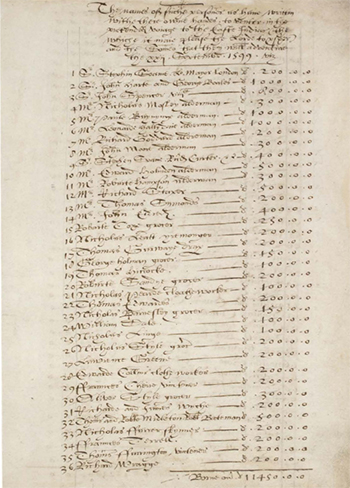
The first subscription list of 101 well-fleeced London names gathered by ‘Auditor Smythe’ for ‘the voiag to the Easte Indes’, on 22 September 1599, two days before the first public meeting at the Founder’s Hall, Moorgate Fields.
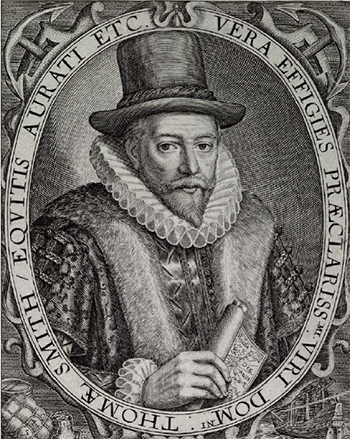
Sir Thomas ‘Auditor’ Smythe, the founder of the East India Company, in 1616
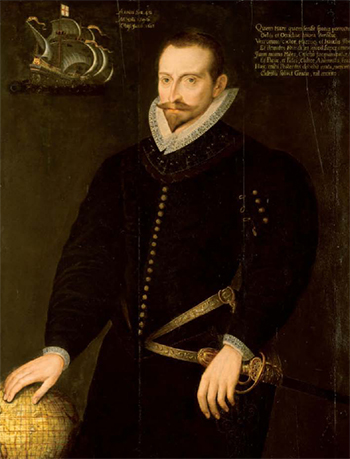
Sir James Lancaster, who commanded the Company’s first voyage in 1601, shown five years earlier, on his return from his first disastrous journey east.
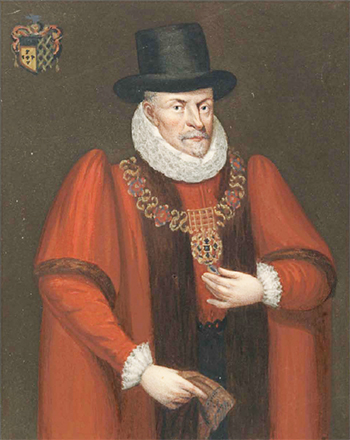
Sir Thomas Roe, the ambassador of James I who led Britain’s first official diplomatic mission to India in 1615.
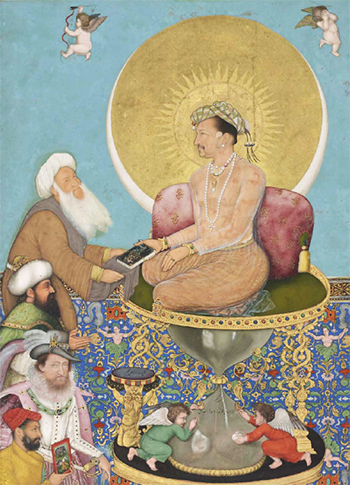
Jahangir as the Millennial Sultan Preferring the Company of Sufis, by Bichitr. Jahangir is sitting enthroned with the halo of majesty glowing so brightly behind him that one of the putti has to shield his eyes from his radiance; another pair of putti are writing a banner reading ‘Allah-o Akbar! Oh king, may your age endure a thousand years!’ The Emperor turns to hand a Quran to a sufi, spurning the outstretched hands of the Ottoman Sultan. James I, meanwhile, is relegated to the bottom corner of the frame, below Jahangir’s feet, and only just above Bichitr’s own self-portrait. The King shown in a three-quarter profile –an angle reserved in Mughal miniatures for the minor characters –with a look of vinegary sullenness on his face at his lowly place in the Mughal hierarchy.
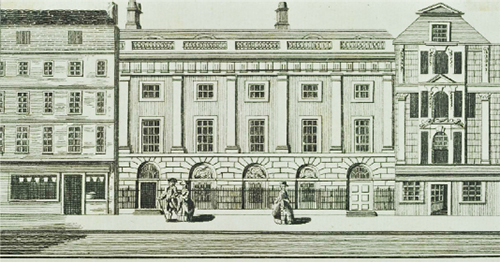
New East India House, the East India Company headquarters in London’s Leadenhall Street, after its early eighteenth-century Palladian facelift. A Portuguese traveller noted in 1731 that it was ‘lately magnificently built, with a stone front to the street; but the front being very narrow, does not make an appearance in any way answerable to the grandeur of the house within’. Like so much about the power of the East India Company, the modest appearance of East India House was deeply deceptive.
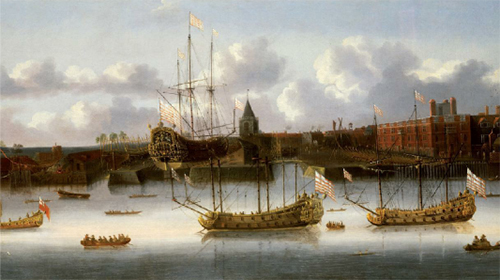
East India Company ships at Deptford, 1660.
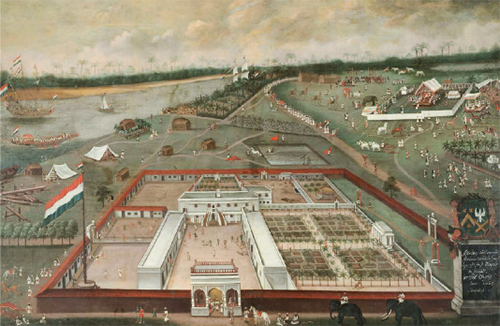
Headquarters of the Dutch East India Company at Hughli by Hendrik van Schuylenburgh, 1665.
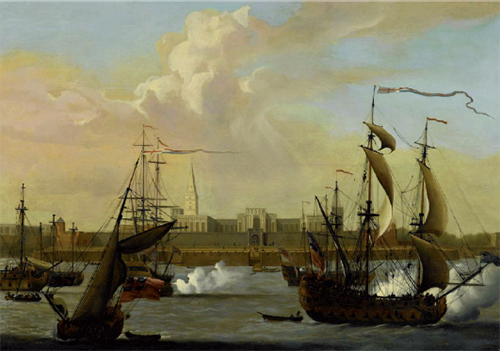
Fort William, Calcutta, by George Lambert and Samuel Scott, 1731.
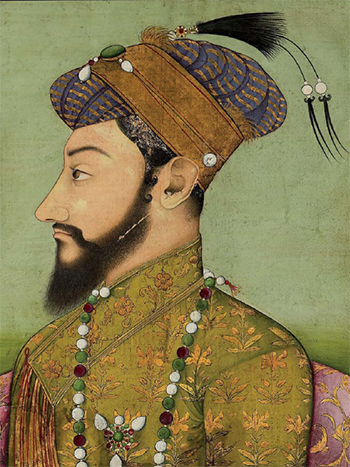
The severe and puritanical Mughal Emperor Alamgir Aurangzeb, whose overly ambitious conquest of the Deccan first brought Mughal dominions to their widest extent, then led to the eventual collapse of the Empire, painted c. 1653.
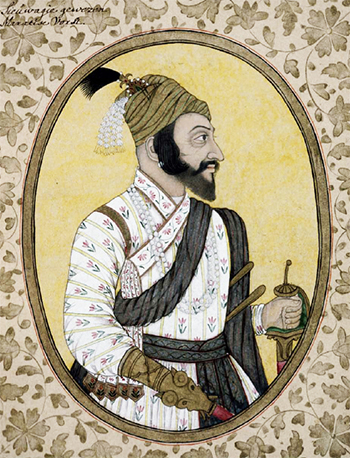
Below is his nemesis, the Maratha warlord Shivaji Bhonsle, shown at the end of his life c. 1680. Shivaji built forts, created a navy and raided deep into Mughal territory. He was crowned Chhatrapati, or Lord of the Umbrella, at two successive coronation ceremonies at his remote stronghold of Raigad in 1674
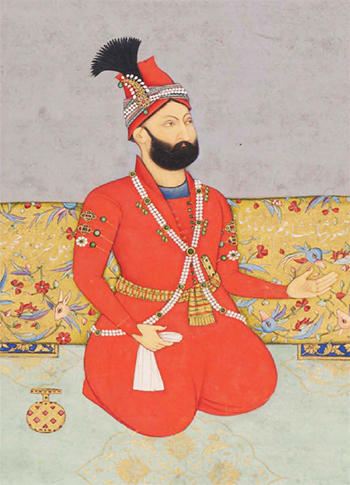
The Persian warlord Nader Shah was the son of a humble shepherd and furrier. He rose rapidly in the Safavid army due to his remarkable military talents, before deciding to take over the Kingdom and then ‘pluck some golden feathers from the Mughal peacock’.
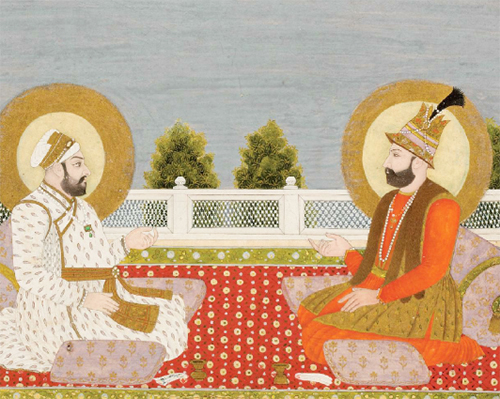
Nader Shah with the effete aesthete Emperor Muhammad Shah Rangila, whom the Persian relieved of his entire treasury, including the Peacock Throne, into which was embedded the great Koh-i-Noor diamond. The sudden impoverishment of Delhi after Nader’s departure meant that the administrative and military salaries could no longer be paid, and, without fuel, the fire went out of the boiler house of Empire.
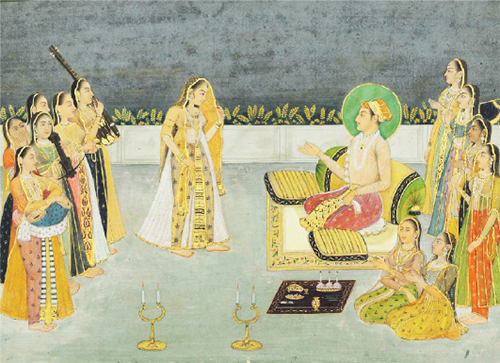
A Mughal prince, probably the young Shah Alam, on the terrace of the Red Fort being entertained by dancing girls, c. 1739, around the time of Nader’s Shah invasion.
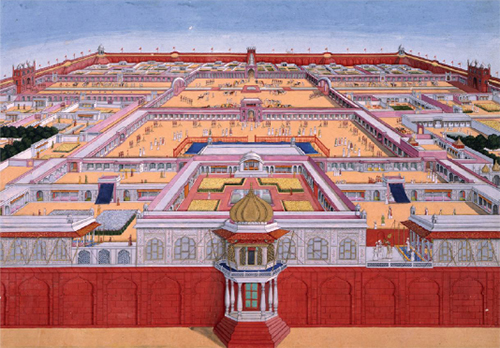
Aerial view down over the Red Fort, c. 1770.
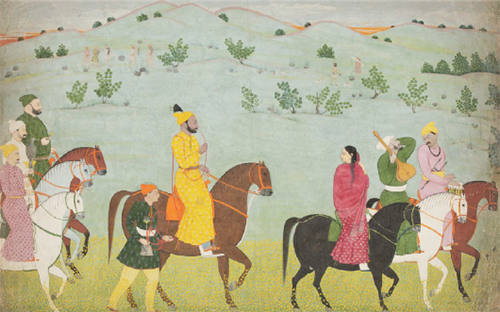
A Leisurely Ride, by Nainsukh. In the aftermath of the fall of Mughal Delhi, the imperial artists fanned out across the Empire, and elegant masterpieces such as this began to be painted in courts as remote as Guler and Jasrota in the Himalayan foothills.
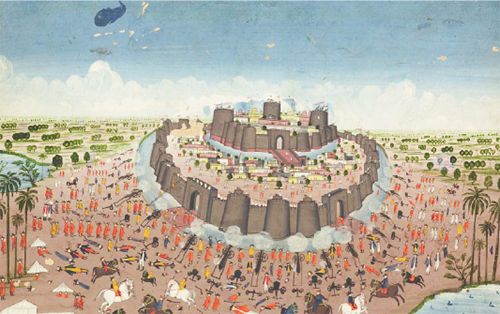
Europeans Besiege a City. As Mughal authority disintegrated, everyone took measures for their own protection and India became a decentralised and disjointed but profoundly militarised society. European mercenaries were much in demand for their military skills, especially as artillerymen.

A scene at a Murshidabad shrine.
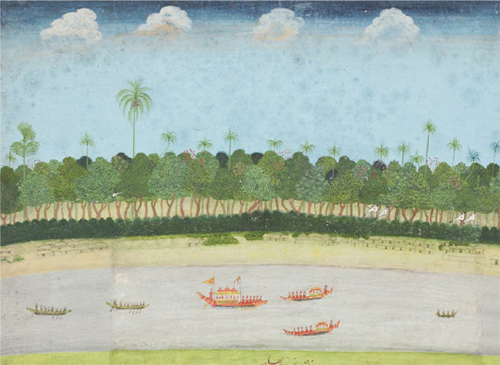
Above the Hughli near Murshidabad.
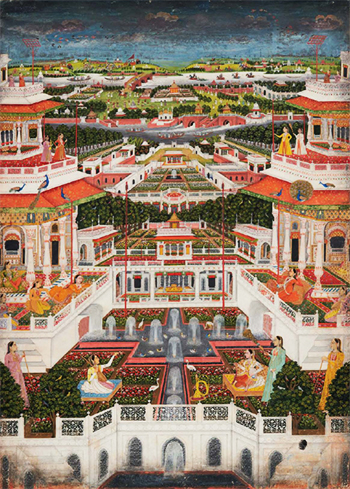
The palaces of Faizabad.
Plates Section

The first subscription list of 101 well-fleeced London names gathered by ‘Auditor Smythe’ for ‘the voiag to the Easte Indes’, on 22 September 1599, two days before the first public meeting at the Founder’s Hall, Moorgate Fields.

Sir Thomas ‘Auditor’ Smythe, the founder of the East India Company, in 1616

Sir James Lancaster, who commanded the Company’s first voyage in 1601, shown five years earlier, on his return from his first disastrous journey east.

Sir Thomas Roe, the ambassador of James I who led Britain’s first official diplomatic mission to India in 1615.

Jahangir as the Millennial Sultan Preferring the Company of Sufis, by Bichitr. Jahangir is sitting enthroned with the halo of majesty glowing so brightly behind him that one of the putti has to shield his eyes from his radiance; another pair of putti are writing a banner reading ‘Allah-o Akbar! Oh king, may your age endure a thousand years!’ The Emperor turns to hand a Quran to a sufi, spurning the outstretched hands of the Ottoman Sultan. James I, meanwhile, is relegated to the bottom corner of the frame, below Jahangir’s feet, and only just above Bichitr’s own self-portrait. The King shown in a three-quarter profile –an angle reserved in Mughal miniatures for the minor characters –with a look of vinegary sullenness on his face at his lowly place in the Mughal hierarchy.

New East India House, the East India Company headquarters in London’s Leadenhall Street, after its early eighteenth-century Palladian facelift. A Portuguese traveller noted in 1731 that it was ‘lately magnificently built, with a stone front to the street; but the front being very narrow, does not make an appearance in any way answerable to the grandeur of the house within’. Like so much about the power of the East India Company, the modest appearance of East India House was deeply deceptive.

East India Company ships at Deptford, 1660.

Headquarters of the Dutch East India Company at Hughli by Hendrik van Schuylenburgh, 1665.

Fort William, Calcutta, by George Lambert and Samuel Scott, 1731.

The severe and puritanical Mughal Emperor Alamgir Aurangzeb, whose overly ambitious conquest of the Deccan first brought Mughal dominions to their widest extent, then led to the eventual collapse of the Empire, painted c. 1653.

Below is his nemesis, the Maratha warlord Shivaji Bhonsle, shown at the end of his life c. 1680. Shivaji built forts, created a navy and raided deep into Mughal territory. He was crowned Chhatrapati, or Lord of the Umbrella, at two successive coronation ceremonies at his remote stronghold of Raigad in 1674

The Persian warlord Nader Shah was the son of a humble shepherd and furrier. He rose rapidly in the Safavid army due to his remarkable military talents, before deciding to take over the Kingdom and then ‘pluck some golden feathers from the Mughal peacock’.

Nader Shah with the effete aesthete Emperor Muhammad Shah Rangila, whom the Persian relieved of his entire treasury, including the Peacock Throne, into which was embedded the great Koh-i-Noor diamond. The sudden impoverishment of Delhi after Nader’s departure meant that the administrative and military salaries could no longer be paid, and, without fuel, the fire went out of the boiler house of Empire.

A Mughal prince, probably the young Shah Alam, on the terrace of the Red Fort being entertained by dancing girls, c. 1739, around the time of Nader’s Shah invasion.

Aerial view down over the Red Fort, c. 1770.

A Leisurely Ride, by Nainsukh. In the aftermath of the fall of Mughal Delhi, the imperial artists fanned out across the Empire, and elegant masterpieces such as this began to be painted in courts as remote as Guler and Jasrota in the Himalayan foothills.

Europeans Besiege a City. As Mughal authority disintegrated, everyone took measures for their own protection and India became a decentralised and disjointed but profoundly militarised society. European mercenaries were much in demand for their military skills, especially as artillerymen.

A scene at a Murshidabad shrine.

Above the Hughli near Murshidabad.

The palaces of Faizabad.
- admin
- Site Admin
- Posts: 38412
- Joined: Thu Aug 01, 2013 5:21 am
Re: The Anarchy:The East India Co. Corporate Violence, & Pil
Part 2 of 4
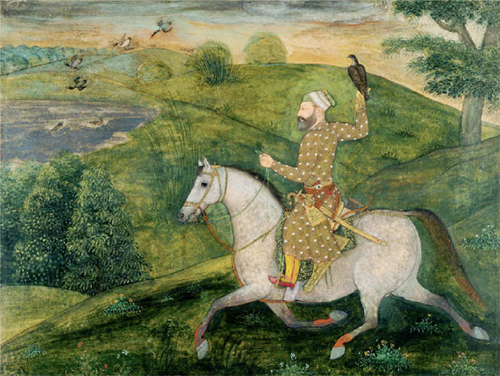
Aliverdi Khan came to power in 1740 in Bengal in a military coup financed by the powerful Jagat Seth bankers. A catloving epicure who loved to fill his evenings with good food, books and stories, after defeating the Marathas he created in Murshidabad a stable political, economic and political centre which was a rare island of prosperity amid the anarchy of Mughal decline.

Above, Aliverdi Khan is shown hawking, and below, a little older, he awards a turban jewel, or sarpeche, the Mughal badge of office, to his nephew, while his grandson, Siraj ud-Daula, looks on.
[x]

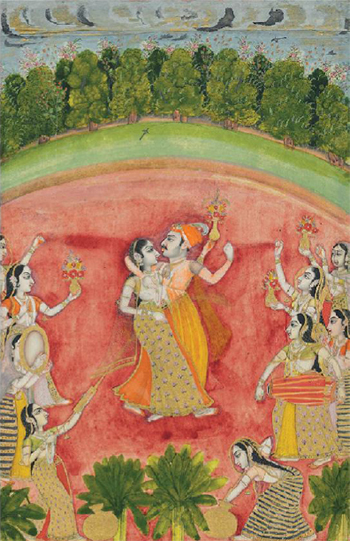
Left and right: Siraj ud-Daula with his women. ‘This prince made a sport of sacrificing to his lust almost every person of either sex to which he took a fancy,’ wrote his cousin, the historian Ghulam Hussain Khan.
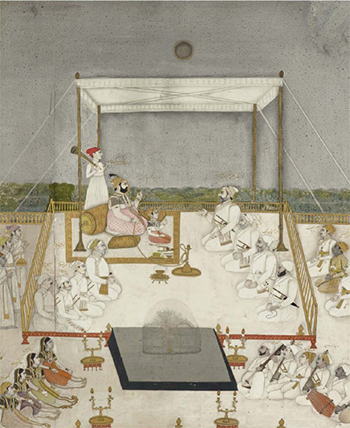
Aliverdi’s son-in-law, Shahmat Jang, enjoys an intimate musical performance by a troupe of hereditary musicians, or kalawants, from Delhi. These were clearly regarded as prize acquisitions because they are all named and distinctively portrayed. Seated waiting to sing on the other side of the hall are four exquisitely beautiful Delhi courtesans, again all individually named.
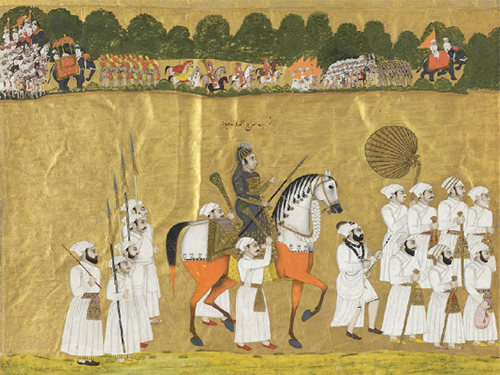
Siraj ud-Daula rides off to war.
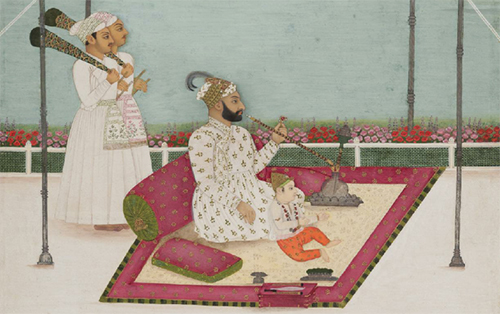
The brilliant historian Ghulam Hussain Khan. The Nawab’s cousin was among the many who emigrated from the ruined streets of Delhi at this time. His Seir Mutaqherin, or Review of Modern Times, his great history of eighteenth-century India, is by far the most revealing Indian source for the period.

Robert Clive in command at the Battle of Plassey, 1757.
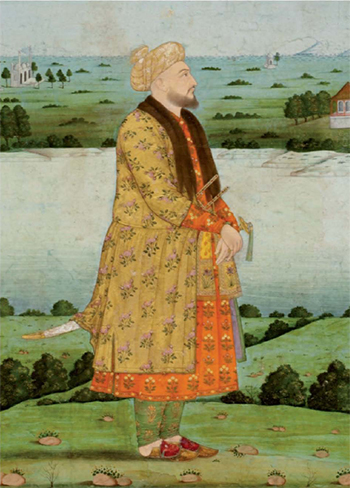
Mir Jafar Khan was an uneducated Arab soldier of fortune who had played his part in many of Aliverdi’s most crucial victories against the Marathas, and led the successful attack on Calcutta for Siraj ud-Daula in 1756. He joined the conspiracy hatched by the Jagat Seths to replace Siraj ud-Daula, and found himself the puppet ruler of Bengal at the whim of the East India Company. Robert Clive rightly described him as ‘a prince of little capacity’.
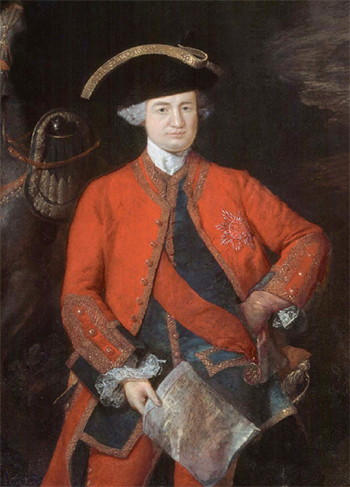
The young Robert Clive, c. 1764, one year before Buxar. Laconic, but fiercely ambitious and unusually forceful, he was a violent but extremely capable leader of the Company and its military forces in India. He had a streetfighter’s eye for sizing up an opponent, a talent at seizing the opportunities presented by happenchance and a willingness to take great risks.
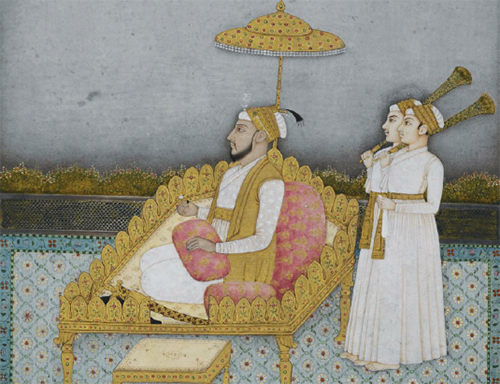
Shah Alam, seated on a throne overlooking the Ganges, shortly after his proclamation as Emperor in 1759. Shah Alam had no land and no money, but compensated as best he could for this with his immense charm, poetic temperament and refined manners. In this way he managed to collect around him some 20,000 followers and unemployed soldiers of fortune, most of them as penniless and ill-equipped as he was.

Mir Jafar and his son Miran on a hunting expedition. As Mir Jafar stumbled and as his treasury emptied, his vigorous but violent son Miran turned increasingly vicious. ‘His inclination was to oppress and torment people,’ wrote Ghulam Hussain Khan, who knew him well. ‘He was expeditious and quick-minded in slaughtering people, having a peculiar knack at such matters, and looking upon every infamous or atrocious deed as an act of prudence and foresight.’

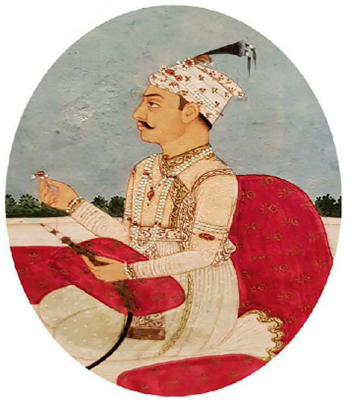
Mir Jafar (above) and Mir Qasim (right) in 1765. Mir Qasim was as different a man as could be imagined from his chaotic and uneducated father-in-law, Mir Jafar. Of noble Persian extraction, though born on his father’s estates near Patna, Mir Qasim was small in frame, with little military experience, but young, capable, intelligent and, above all, determined. He conspired with the Company to replace Mir Jafar in a coup in 1760 and succeeded in creating a tightly run state with a modern infantry army. But within three years he ended up coming into conflict with the Company.
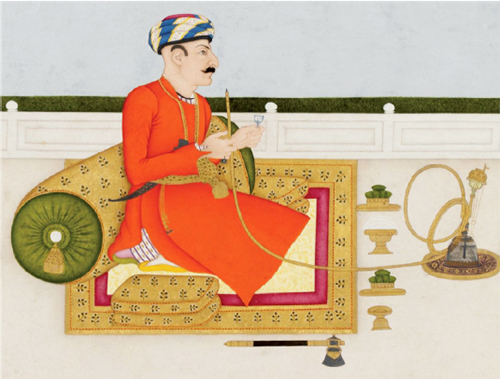
Khoja Gregory was an Isfahani Armenian to whom Mir Qasim gave the title Gurghin Khan, or the Wolf. Ghulam Hussain Khan thought him a remarkable man: ‘Above ordinary size, strongly built, with a very fair complexion, an aquiline nose and large black eyes, full of fire.’
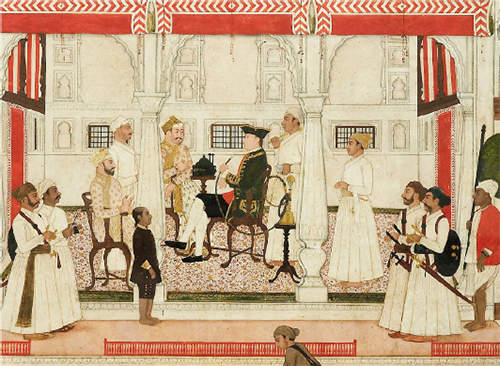
Official in Discussion with a Nawab – probably William Fullarton and Mir Qasim, Patna, 1760–65. Fullarton was a popular Scottish surgeon and aesthete and one of very few to survive the Patna massacre. He was saved by the personal intervention of his old friend, the historian Ghulam Hussain Khan.
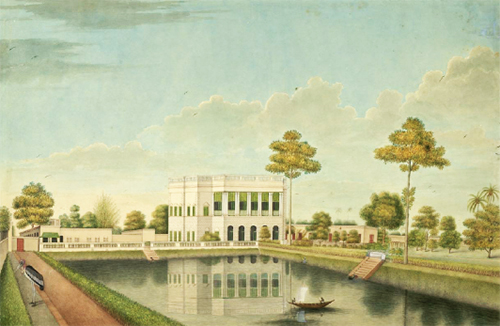
A Palladian house and garden by the Bengali artist Shaikh Muhammad Amir of Karraya.
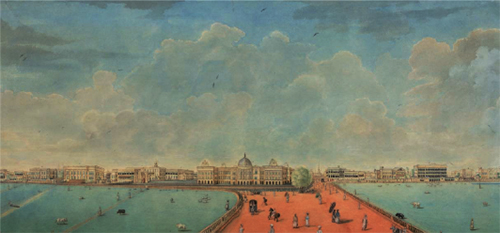
The Shaikh’s view of Government House and Esplanade Road, Calcutta, from the Maidan. Both seem to have been painted around 1827.
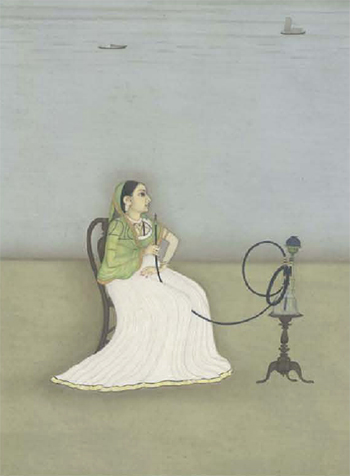

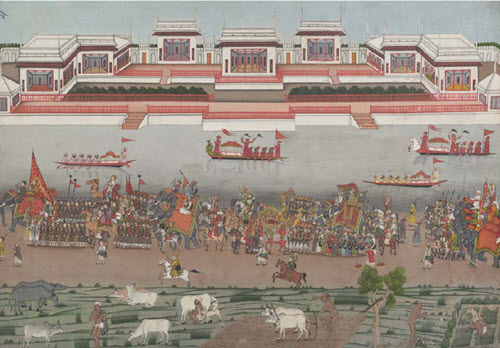
As the Mughal capital collapsed into anarchy, the celebrated Delhi artists Dip Chand and Nidha Mal migrated eastwards to find work in the richer, more stable and cosmopolitan courts of Patna and Lucknow. Here they developed a regional style, with the wide expanse of the Ganges invariably running smoothly between white sandbanks, as boats ply the waterways. Above: The cultured, Patnabased Kashmiri merchant prince Ashraf Ali Khan and his bibi Muttubby experiment with European fashions. Ashraf perches cross-legged on a Regency chair and both of them rest their hookahs on wooden teapoys. Below, Nawab Shuja ud-Daula passes in a grand procession past a line of riverside palaces.

Aliverdi Khan came to power in 1740 in Bengal in a military coup financed by the powerful Jagat Seth bankers. A catloving epicure who loved to fill his evenings with good food, books and stories, after defeating the Marathas he created in Murshidabad a stable political, economic and political centre which was a rare island of prosperity amid the anarchy of Mughal decline.

Above, Aliverdi Khan is shown hawking, and below, a little older, he awards a turban jewel, or sarpeche, the Mughal badge of office, to his nephew, while his grandson, Siraj ud-Daula, looks on.
[x]


Left and right: Siraj ud-Daula with his women. ‘This prince made a sport of sacrificing to his lust almost every person of either sex to which he took a fancy,’ wrote his cousin, the historian Ghulam Hussain Khan.

Aliverdi’s son-in-law, Shahmat Jang, enjoys an intimate musical performance by a troupe of hereditary musicians, or kalawants, from Delhi. These were clearly regarded as prize acquisitions because they are all named and distinctively portrayed. Seated waiting to sing on the other side of the hall are four exquisitely beautiful Delhi courtesans, again all individually named.

Siraj ud-Daula rides off to war.

The brilliant historian Ghulam Hussain Khan. The Nawab’s cousin was among the many who emigrated from the ruined streets of Delhi at this time. His Seir Mutaqherin, or Review of Modern Times, his great history of eighteenth-century India, is by far the most revealing Indian source for the period.

Robert Clive in command at the Battle of Plassey, 1757.

Mir Jafar Khan was an uneducated Arab soldier of fortune who had played his part in many of Aliverdi’s most crucial victories against the Marathas, and led the successful attack on Calcutta for Siraj ud-Daula in 1756. He joined the conspiracy hatched by the Jagat Seths to replace Siraj ud-Daula, and found himself the puppet ruler of Bengal at the whim of the East India Company. Robert Clive rightly described him as ‘a prince of little capacity’.

The young Robert Clive, c. 1764, one year before Buxar. Laconic, but fiercely ambitious and unusually forceful, he was a violent but extremely capable leader of the Company and its military forces in India. He had a streetfighter’s eye for sizing up an opponent, a talent at seizing the opportunities presented by happenchance and a willingness to take great risks.

Shah Alam, seated on a throne overlooking the Ganges, shortly after his proclamation as Emperor in 1759. Shah Alam had no land and no money, but compensated as best he could for this with his immense charm, poetic temperament and refined manners. In this way he managed to collect around him some 20,000 followers and unemployed soldiers of fortune, most of them as penniless and ill-equipped as he was.

Mir Jafar and his son Miran on a hunting expedition. As Mir Jafar stumbled and as his treasury emptied, his vigorous but violent son Miran turned increasingly vicious. ‘His inclination was to oppress and torment people,’ wrote Ghulam Hussain Khan, who knew him well. ‘He was expeditious and quick-minded in slaughtering people, having a peculiar knack at such matters, and looking upon every infamous or atrocious deed as an act of prudence and foresight.’


Mir Jafar (above) and Mir Qasim (right) in 1765. Mir Qasim was as different a man as could be imagined from his chaotic and uneducated father-in-law, Mir Jafar. Of noble Persian extraction, though born on his father’s estates near Patna, Mir Qasim was small in frame, with little military experience, but young, capable, intelligent and, above all, determined. He conspired with the Company to replace Mir Jafar in a coup in 1760 and succeeded in creating a tightly run state with a modern infantry army. But within three years he ended up coming into conflict with the Company.

Khoja Gregory was an Isfahani Armenian to whom Mir Qasim gave the title Gurghin Khan, or the Wolf. Ghulam Hussain Khan thought him a remarkable man: ‘Above ordinary size, strongly built, with a very fair complexion, an aquiline nose and large black eyes, full of fire.’

Official in Discussion with a Nawab – probably William Fullarton and Mir Qasim, Patna, 1760–65. Fullarton was a popular Scottish surgeon and aesthete and one of very few to survive the Patna massacre. He was saved by the personal intervention of his old friend, the historian Ghulam Hussain Khan.

A Palladian house and garden by the Bengali artist Shaikh Muhammad Amir of Karraya.

The Shaikh’s view of Government House and Esplanade Road, Calcutta, from the Maidan. Both seem to have been painted around 1827.



As the Mughal capital collapsed into anarchy, the celebrated Delhi artists Dip Chand and Nidha Mal migrated eastwards to find work in the richer, more stable and cosmopolitan courts of Patna and Lucknow. Here they developed a regional style, with the wide expanse of the Ganges invariably running smoothly between white sandbanks, as boats ply the waterways. Above: The cultured, Patnabased Kashmiri merchant prince Ashraf Ali Khan and his bibi Muttubby experiment with European fashions. Ashraf perches cross-legged on a Regency chair and both of them rest their hookahs on wooden teapoys. Below, Nawab Shuja ud-Daula passes in a grand procession past a line of riverside palaces.
- admin
- Site Admin
- Posts: 38412
- Joined: Thu Aug 01, 2013 5:21 am
Re: The Anarchy:The East India Co. Corporate Violence, & Pil
Part 3 of 4
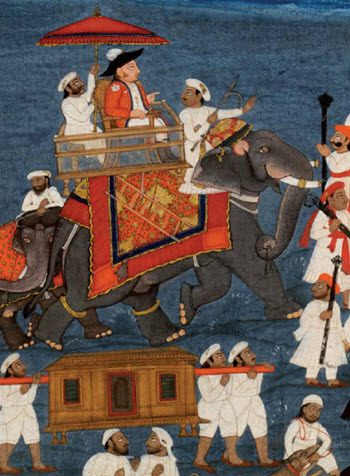
After Buxar, Europeans and their sepoy guards fanned out across India, trading, fighting, taxing and administering the revenues and justice departments. Above: Captain (later Colonel) James Tod rides an elephant, by Chokha, Mewar, 1817.
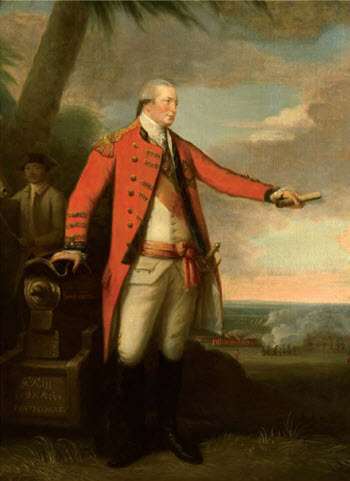
Hector Munro, c. 1785. Munro was the victor of Buxar and the vanquished at Pollilur.
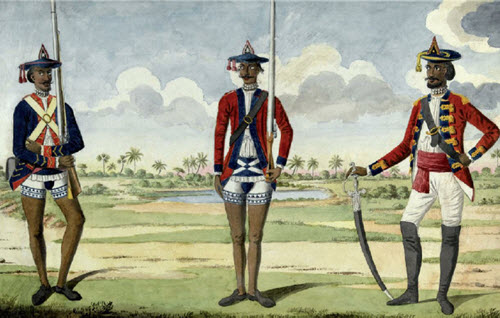
Madras sepoys, c. 1780.
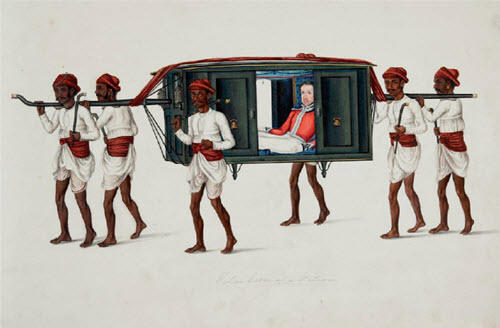
British Officer in a Palanquin, by Yellapah of Vellore.
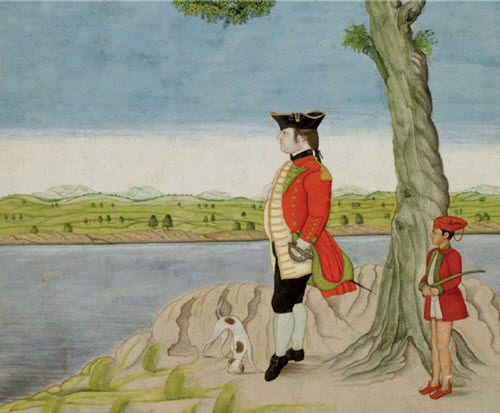
A Military Officer of the East India Company, Murshidabad, 1765.
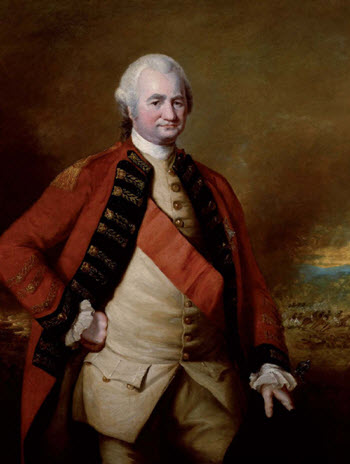
Robert Clive by Nathaniel Dance, c. 1770. Here Baron Clive of Plassey is shown in portly middle age, very much the man aware of all that he had achieved to establish the political and military supremacy of the East India Company in Bengal, Bihar and Orissa. ‘Fortune seems determined to accompany me to the last,’ Clive wrote to his friend and biographer Robert Orme. ‘Every object, every sanguine wish is upon the point of being completely fulfilled.’
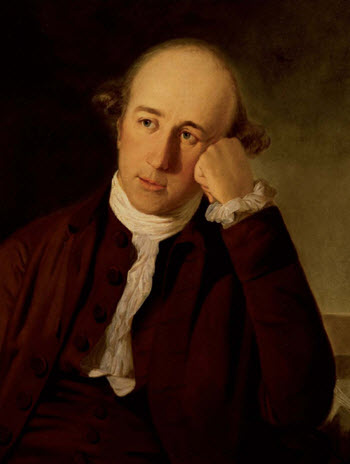
The young Warren Hastings by Tilly Kettle, c. 1772. A thin, plainly dressed and balding young man in simple brown fustian with an open face and somewhat wistful expression, but with a hint of sense of humour in the set of his lips. His letters at this period reveal a diffident, austere, sensitive and self-contained young man who rose at dawn, had a cold bath then rode for an hour, occasionally with a hawk on his arm. He seems to have kept his own company, drinking ‘but little wine’ and spending his evenings reading, strumming a guitar and working on his Persian.
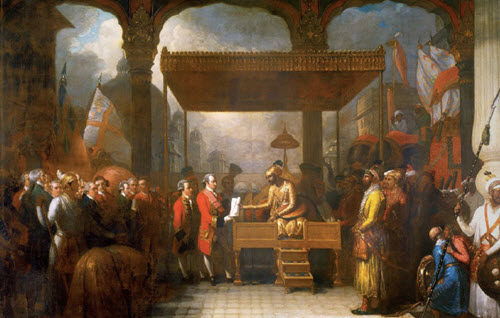
Shah Alam Conveying the Gift of the Diwani to Lord Clive, by Benjamin West.
Today we would call this an act of involuntary privatisation. The scroll is an order by the Emperor to dismiss the Mughal revenue officials in Bengal, Bihar and Orissa and replace them with a set of English traders appointed by Clive – the new Governor of Bengal – and the directors of the Company, whom the document describes as ‘the high and mighty, the noblest of exalted nobles, the chief of illustrious warriors, our faithful servants the English Company’. The collecting of Mughal taxes was henceforth subcontracted to a multinational corporation – whose revenue-collecting operations were protected by its own private army.

The Mughal Emperor Shah Alam Reviewing the Troops of the East India Company at Allahabad With General Barker, by Tilly Kettle. In 1771, Barker was despatched to Allahabad to try and stop Shah Alam returning to Delhi but found him ‘deaf to all arguments’. The Emperor had long found life in Allahabad as a puppet of the Company insupportable, and now he yearned to return home, whatever the risks.
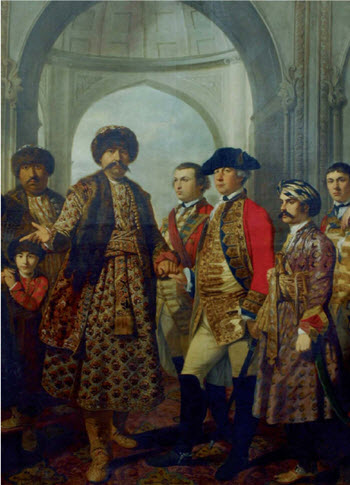
Shuja ud-Daula, Nawab of Avadh, with four Sons, General Barker and Military Officers, by Tilly Kettle. Shuja ud-Daula was a giant of a man. Nearly seven feet tall, with prominent, oiled moustaches, he was a man of immense physical strength. Even in late middle age he was reputedly strong enough to lift up two of his officers, one in each hand. He was defeated by the Company at the Battle of Buxar in 1765 and replaced by Clive back on the throne of Avadh, where he ruled until the end of his life as a close ally of the EIC.
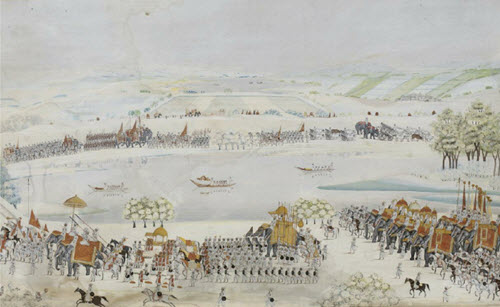
The royal procession of Shah Alam as the Emperor returns to Delhi in 1771. A long column of troops snakes in wide meanders along the banks of the Yamuna, through a fertile landscape. At the front of the procession are the musicians. Then follow the macemen and the bearers of Mughal insignia. Next comes the Emperor himself, high on his elephant and hedged around by a bodyguard. The imperial princes are next, followed by the many women of the imperial harem in their palanquins and covered carriages; then the heavy siege guns, dragged by foursomes of elephants. Behind, the main body of the army stretches off as far as the eye can see.
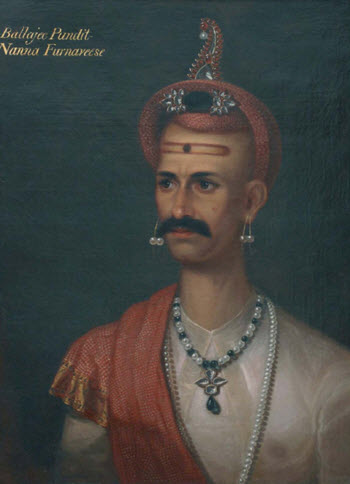
Nana Phadnavis, the Pune-based statesman and minister to the Peshwas, known as ‘the Maratha Machiavelli’. He was one of the first to realise that the East India Company posed an existential threat to India and tried to organise a Triple Alliance with the Hyderabadis and the Sultans of Mysore to drive them out, but failed to carry the project through to its conclusion.
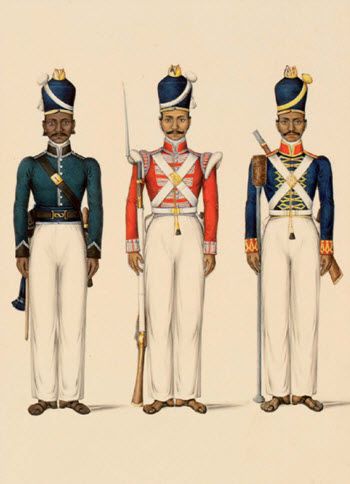
Sepoys of the Madras Infantry, by Yellapah of Vellore.
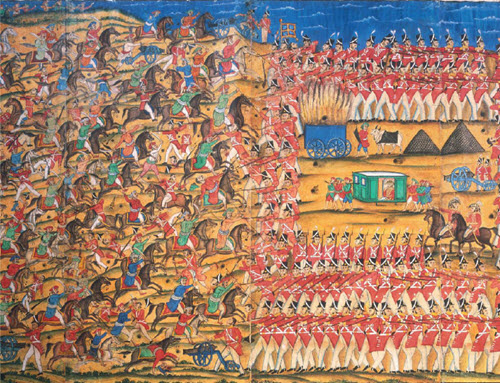
The Battle of Pollilur. A copy of the mural Tipu Sultan had painted on the walls of his garden palace, Darya Daulat Bagh, commemorating his greatest victory in 1780. At the centre, Colonel William Baillie can be seen in his palanquin, touching his finger to his mouth in astonishment as Tipu blows up his ammunition wagon and the Mysore cavalry assault the Company square on all sides.

Edmund Burke, from the studio of Sir Joshua Reynolds. Burke was an Anglo-Irish Whig statesman and political theorist. He had never been to India, but part of his family had been ruined by unwise speculation in East India stock. Together Burke and Francis worked on a series of Select Committee reports exposing the Company’s misdeeds in India. Before he met Philip Francis, Burke had described himself as ‘a great admirer’ of Hastings’ talents. Francis quickly worked to change that. By April 1782, Francis had drawn up a list of twenty-two charges against Hastings, which Burke then brought to the House. After five years of obsessive campaigning, Burke and Francis persuaded Parliament that there was enough evidence to impeach him.
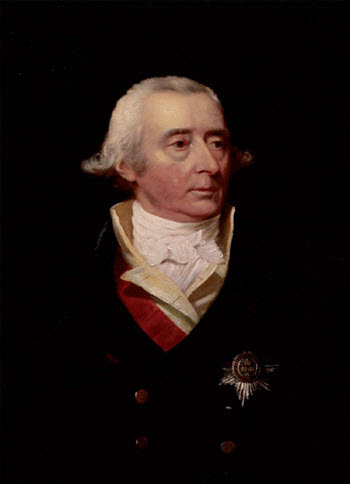
Philip Francis by James Lonsdale, c. 1806. Wrongly convinced that Hastings was the source of all corruption in Bengal, and ambitious to replace him as Governor General, Francis pursued Hastings from 1774 until his death. Having failed to kill Hastings in a duel, and instead receiving a pistol ball in his own ribs, he returned to London, where his accusations eventually led to the impeachment of both Hastings and his Chief Justice, Elijah Impey. Both were ultimately acquitted.
[x]
Portrait of the elderly Warren Hastings by Lemuel Francis Abbott, 1796. Far from being an ostentatious and loud-mouthed new-rich ‘Nabob’, Hastings was a dignified, intellectual and somewhat austere figure. Standing gaunt at the bar during his impeachment in his plain black frock coat, white stockings and grey hair, he looks more Puritan minister about to give a sermon than some paunchy plunderer. Nearly six feet tall, he weighed less than eight stone: ‘of spare habit, very bald, with a countenance placid and thoughtful, but when animated, full of intelligence.’
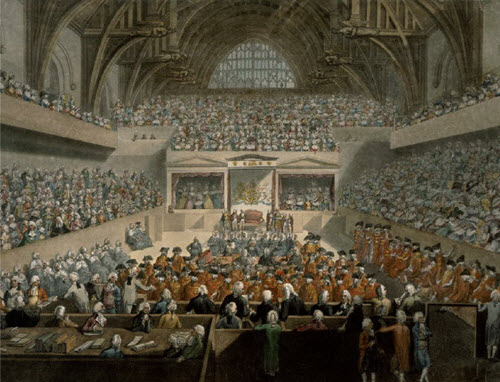
The Impeachment of Warren Hastings in Westminster Hall, 1788. This was not just the greatest political spectacle in the age of George III, it was the nearest the British ever got to putting the Company’s Indian Empire on trial. Tickets for the few seats reserved for spectators changed hands for as much as £50, and even then so many people wished to attend that, as one of the managers of the impeachment noted, the audience ‘will have to mob it at the door till nine, when the doors open, and then there will be a rush as there is at the pit of the Playhouse when Garrick plays King Lear’.
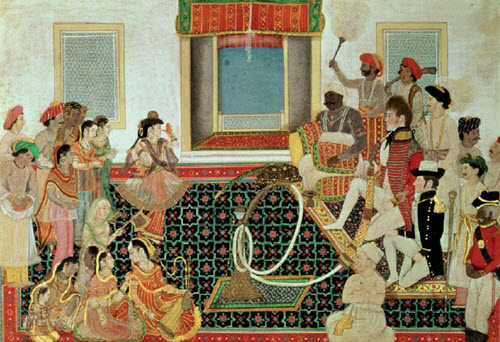
Mahadji Scindia in Delhi Entertaining a British Naval Officer and a Young British Military Officer with a Nautch, c. 1790.
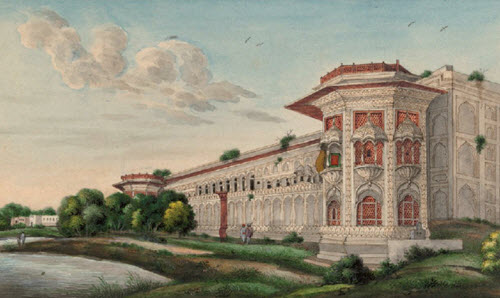
Qudsia Bagh palace where Ghulam Qadir was brought up during his time at the court of Shah Alam.
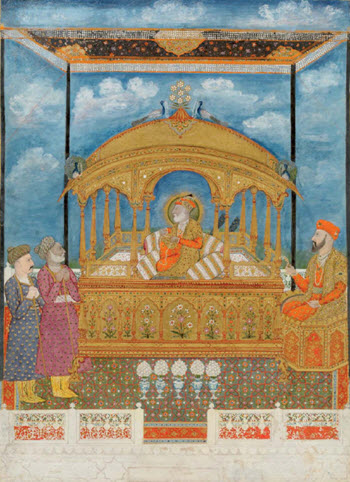
The blind Shah Alam II on a wooden replica of the Peacock Throne, c. 1790, by Khairullah. Now in his seventies, the old king sat amid his ruined palace, the sightless ruler of a largely illusory empire.

After Buxar, Europeans and their sepoy guards fanned out across India, trading, fighting, taxing and administering the revenues and justice departments. Above: Captain (later Colonel) James Tod rides an elephant, by Chokha, Mewar, 1817.

Hector Munro, c. 1785. Munro was the victor of Buxar and the vanquished at Pollilur.

Madras sepoys, c. 1780.

British Officer in a Palanquin, by Yellapah of Vellore.

A Military Officer of the East India Company, Murshidabad, 1765.

Robert Clive by Nathaniel Dance, c. 1770. Here Baron Clive of Plassey is shown in portly middle age, very much the man aware of all that he had achieved to establish the political and military supremacy of the East India Company in Bengal, Bihar and Orissa. ‘Fortune seems determined to accompany me to the last,’ Clive wrote to his friend and biographer Robert Orme. ‘Every object, every sanguine wish is upon the point of being completely fulfilled.’

The young Warren Hastings by Tilly Kettle, c. 1772. A thin, plainly dressed and balding young man in simple brown fustian with an open face and somewhat wistful expression, but with a hint of sense of humour in the set of his lips. His letters at this period reveal a diffident, austere, sensitive and self-contained young man who rose at dawn, had a cold bath then rode for an hour, occasionally with a hawk on his arm. He seems to have kept his own company, drinking ‘but little wine’ and spending his evenings reading, strumming a guitar and working on his Persian.

Shah Alam Conveying the Gift of the Diwani to Lord Clive, by Benjamin West.
Today we would call this an act of involuntary privatisation. The scroll is an order by the Emperor to dismiss the Mughal revenue officials in Bengal, Bihar and Orissa and replace them with a set of English traders appointed by Clive – the new Governor of Bengal – and the directors of the Company, whom the document describes as ‘the high and mighty, the noblest of exalted nobles, the chief of illustrious warriors, our faithful servants the English Company’. The collecting of Mughal taxes was henceforth subcontracted to a multinational corporation – whose revenue-collecting operations were protected by its own private army.

The Mughal Emperor Shah Alam Reviewing the Troops of the East India Company at Allahabad With General Barker, by Tilly Kettle. In 1771, Barker was despatched to Allahabad to try and stop Shah Alam returning to Delhi but found him ‘deaf to all arguments’. The Emperor had long found life in Allahabad as a puppet of the Company insupportable, and now he yearned to return home, whatever the risks.

Shuja ud-Daula, Nawab of Avadh, with four Sons, General Barker and Military Officers, by Tilly Kettle. Shuja ud-Daula was a giant of a man. Nearly seven feet tall, with prominent, oiled moustaches, he was a man of immense physical strength. Even in late middle age he was reputedly strong enough to lift up two of his officers, one in each hand. He was defeated by the Company at the Battle of Buxar in 1765 and replaced by Clive back on the throne of Avadh, where he ruled until the end of his life as a close ally of the EIC.

The royal procession of Shah Alam as the Emperor returns to Delhi in 1771. A long column of troops snakes in wide meanders along the banks of the Yamuna, through a fertile landscape. At the front of the procession are the musicians. Then follow the macemen and the bearers of Mughal insignia. Next comes the Emperor himself, high on his elephant and hedged around by a bodyguard. The imperial princes are next, followed by the many women of the imperial harem in their palanquins and covered carriages; then the heavy siege guns, dragged by foursomes of elephants. Behind, the main body of the army stretches off as far as the eye can see.

Nana Phadnavis, the Pune-based statesman and minister to the Peshwas, known as ‘the Maratha Machiavelli’. He was one of the first to realise that the East India Company posed an existential threat to India and tried to organise a Triple Alliance with the Hyderabadis and the Sultans of Mysore to drive them out, but failed to carry the project through to its conclusion.

Sepoys of the Madras Infantry, by Yellapah of Vellore.

The Battle of Pollilur. A copy of the mural Tipu Sultan had painted on the walls of his garden palace, Darya Daulat Bagh, commemorating his greatest victory in 1780. At the centre, Colonel William Baillie can be seen in his palanquin, touching his finger to his mouth in astonishment as Tipu blows up his ammunition wagon and the Mysore cavalry assault the Company square on all sides.

Edmund Burke, from the studio of Sir Joshua Reynolds. Burke was an Anglo-Irish Whig statesman and political theorist. He had never been to India, but part of his family had been ruined by unwise speculation in East India stock. Together Burke and Francis worked on a series of Select Committee reports exposing the Company’s misdeeds in India. Before he met Philip Francis, Burke had described himself as ‘a great admirer’ of Hastings’ talents. Francis quickly worked to change that. By April 1782, Francis had drawn up a list of twenty-two charges against Hastings, which Burke then brought to the House. After five years of obsessive campaigning, Burke and Francis persuaded Parliament that there was enough evidence to impeach him.

Philip Francis by James Lonsdale, c. 1806. Wrongly convinced that Hastings was the source of all corruption in Bengal, and ambitious to replace him as Governor General, Francis pursued Hastings from 1774 until his death. Having failed to kill Hastings in a duel, and instead receiving a pistol ball in his own ribs, he returned to London, where his accusations eventually led to the impeachment of both Hastings and his Chief Justice, Elijah Impey. Both were ultimately acquitted.
[x]
Portrait of the elderly Warren Hastings by Lemuel Francis Abbott, 1796. Far from being an ostentatious and loud-mouthed new-rich ‘Nabob’, Hastings was a dignified, intellectual and somewhat austere figure. Standing gaunt at the bar during his impeachment in his plain black frock coat, white stockings and grey hair, he looks more Puritan minister about to give a sermon than some paunchy plunderer. Nearly six feet tall, he weighed less than eight stone: ‘of spare habit, very bald, with a countenance placid and thoughtful, but when animated, full of intelligence.’

The Impeachment of Warren Hastings in Westminster Hall, 1788. This was not just the greatest political spectacle in the age of George III, it was the nearest the British ever got to putting the Company’s Indian Empire on trial. Tickets for the few seats reserved for spectators changed hands for as much as £50, and even then so many people wished to attend that, as one of the managers of the impeachment noted, the audience ‘will have to mob it at the door till nine, when the doors open, and then there will be a rush as there is at the pit of the Playhouse when Garrick plays King Lear’.

Mahadji Scindia in Delhi Entertaining a British Naval Officer and a Young British Military Officer with a Nautch, c. 1790.

Qudsia Bagh palace where Ghulam Qadir was brought up during his time at the court of Shah Alam.

The blind Shah Alam II on a wooden replica of the Peacock Throne, c. 1790, by Khairullah. Now in his seventies, the old king sat amid his ruined palace, the sightless ruler of a largely illusory empire.
- admin
- Site Admin
- Posts: 38412
- Joined: Thu Aug 01, 2013 5:21 am
Re: The Anarchy:The East India Co. Corporate Violence, & Pil
Part 4 of 4
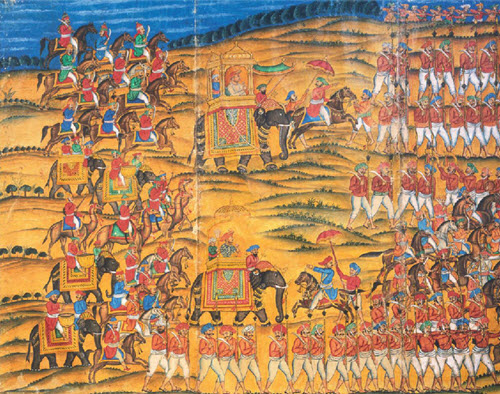
Tipu Sultan on his elephant commanding his forces at the Battle of Pollilur.
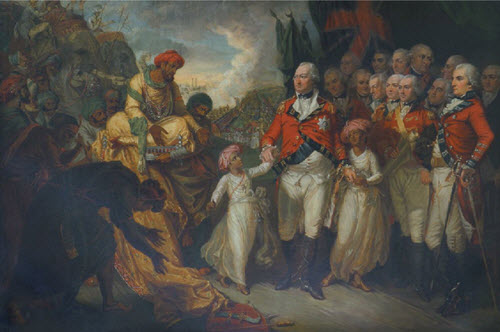
Lord Cornwallis receiving the sons of Tipu Sultan after his 1792 invasion of Mysore, by Mather Brown.
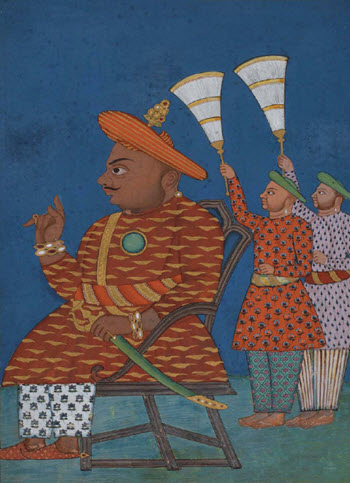
Tipu succeeded his father in 1782 and ruled with great efficiency and imagination during peace, but with great brutality in war. He was forced to cede half his kingdom to Lord Cornwallis’s Triple Alliance with the Marathas and Hyderabadis in 1792 and was finally defeated and killed by Lord Wellesley in 1799.
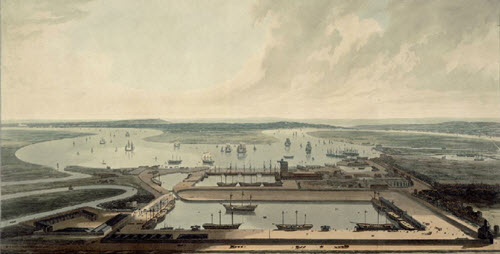
A View of the East India Docks, c. 1808 by William Daniell, seen from what is now East India Dock, London.
In less than fifty years since the 1750s the Company had seized control of almost all of what had once been Mughal India and encircled the globe. It had also created a sophisticated administration and civil service, built much of London’s docklands and come close to generating nearly half of Britain’s trade. Its annual spending within Britain alone – around £8.5 million – equalled about a quarter of total British government annual expenditure. No wonder, then, that the Company now referred to itself as ‘the grandest society of merchants in the Universe’.
The Scindias
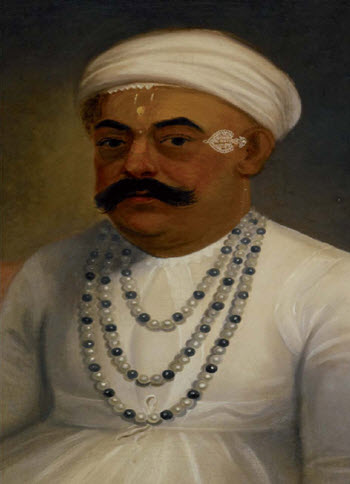
Mahadji Scindia was a shrewd Maratha politician who took Shah Alam under his wing from 1771 onwards and turned the Mughals into Maratha puppets. He created a powerful modern army under the Savoyard General Benoît de Boigne, but towards the end of his life his rivalry with Tukoji Holkar and his unilateral peace with the East India Company at the Treaty of Salbai both did much do undermine Maratha unity.
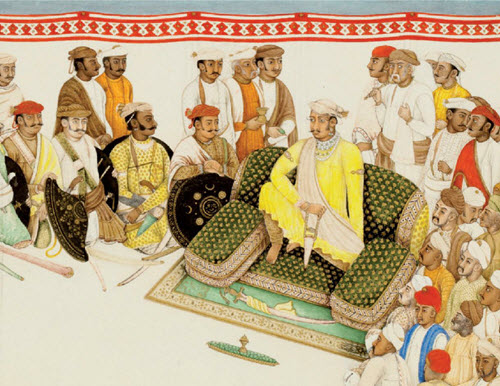
When Mahadji Scindia died in 1794, his successor, Daulat Rao, was only fifteen. The boy inherited the magnificent army that Benoît de Boigne had trained up for his predecessor, but he showed little vision or talent in its deployment. His rivalry with the Holkars and failure to present a common front against the East India Company led to the disastrous Second Anglo-Maratha war of 1803. This left the East India Company the paramount power in India and paved the way for the British Raj.
The Wellesleys
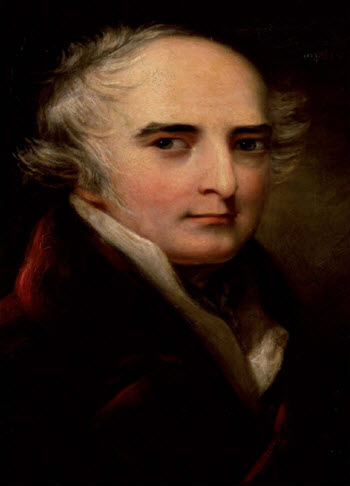
Richard Wellesley conquered more of India than Napoleon did of Europe. Despising the mercantile spirit of the East India Company, he used its armies and resources successfully to wage the Fourth Anglo-Mysore War, which ended with the killing of Tipu Sultan and the destruction of his capital in 1799, then the Second Anglo-Maratha War, which led to the defeat of the armies of both Scindia and Holkar, 1803. By this time he had expelled the last French units from India and given the East India Company control of most of the subcontinent south of the Punjab.
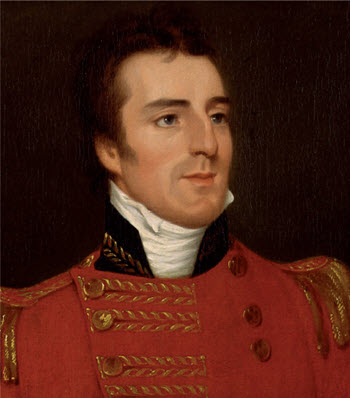
Arthur Wellesley was fast promoted by his elder brother to be Governor of Mysore and ‘Chief Political and Military Officer in the Deccan and Southern Maratha Country’. He helped defeat the armies of Tipu in 1799 and those of the Marathas in 1803, most notably at the Battle of Assaye. Later famous as the Duke of Wellington.
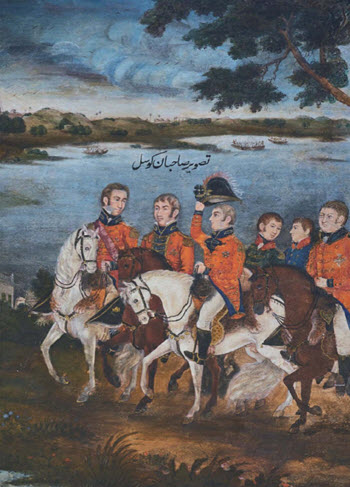
The Duke of Wellington on Campaign in the Deccan, 1803. After the Battle of Assaye one of Wellesley’s senior officers wrote: ‘I hope you will not have occasion to purchase any more victories at such a high price.’
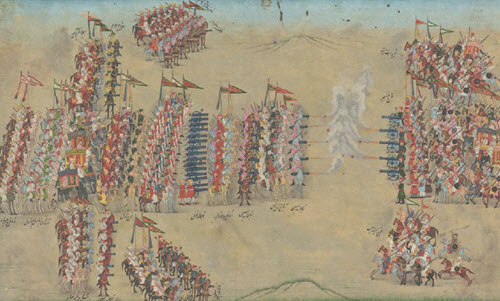
Two armies drawn up in combat, with artillery in front, cavalry in the wings and elephants bringing up the rear.

Tipu Sultan on his elephant commanding his forces at the Battle of Pollilur.

Lord Cornwallis receiving the sons of Tipu Sultan after his 1792 invasion of Mysore, by Mather Brown.

Tipu succeeded his father in 1782 and ruled with great efficiency and imagination during peace, but with great brutality in war. He was forced to cede half his kingdom to Lord Cornwallis’s Triple Alliance with the Marathas and Hyderabadis in 1792 and was finally defeated and killed by Lord Wellesley in 1799.

A View of the East India Docks, c. 1808 by William Daniell, seen from what is now East India Dock, London.
In less than fifty years since the 1750s the Company had seized control of almost all of what had once been Mughal India and encircled the globe. It had also created a sophisticated administration and civil service, built much of London’s docklands and come close to generating nearly half of Britain’s trade. Its annual spending within Britain alone – around £8.5 million – equalled about a quarter of total British government annual expenditure. No wonder, then, that the Company now referred to itself as ‘the grandest society of merchants in the Universe’.
The Scindias

Mahadji Scindia was a shrewd Maratha politician who took Shah Alam under his wing from 1771 onwards and turned the Mughals into Maratha puppets. He created a powerful modern army under the Savoyard General Benoît de Boigne, but towards the end of his life his rivalry with Tukoji Holkar and his unilateral peace with the East India Company at the Treaty of Salbai both did much do undermine Maratha unity.

When Mahadji Scindia died in 1794, his successor, Daulat Rao, was only fifteen. The boy inherited the magnificent army that Benoît de Boigne had trained up for his predecessor, but he showed little vision or talent in its deployment. His rivalry with the Holkars and failure to present a common front against the East India Company led to the disastrous Second Anglo-Maratha war of 1803. This left the East India Company the paramount power in India and paved the way for the British Raj.
The Wellesleys

Richard Wellesley conquered more of India than Napoleon did of Europe. Despising the mercantile spirit of the East India Company, he used its armies and resources successfully to wage the Fourth Anglo-Mysore War, which ended with the killing of Tipu Sultan and the destruction of his capital in 1799, then the Second Anglo-Maratha War, which led to the defeat of the armies of both Scindia and Holkar, 1803. By this time he had expelled the last French units from India and given the East India Company control of most of the subcontinent south of the Punjab.

Arthur Wellesley was fast promoted by his elder brother to be Governor of Mysore and ‘Chief Political and Military Officer in the Deccan and Southern Maratha Country’. He helped defeat the armies of Tipu in 1799 and those of the Marathas in 1803, most notably at the Battle of Assaye. Later famous as the Duke of Wellington.

The Duke of Wellington on Campaign in the Deccan, 1803. After the Battle of Assaye one of Wellesley’s senior officers wrote: ‘I hope you will not have occasion to purchase any more victories at such a high price.’

Two armies drawn up in combat, with artillery in front, cavalry in the wings and elephants bringing up the rear.
- admin
- Site Admin
- Posts: 38412
- Joined: Thu Aug 01, 2013 5:21 am
38 posts
• Page 4 of 4 • 1, 2, 3, 4
Who is online
Users browsing this forum: No registered users and 7 guests
